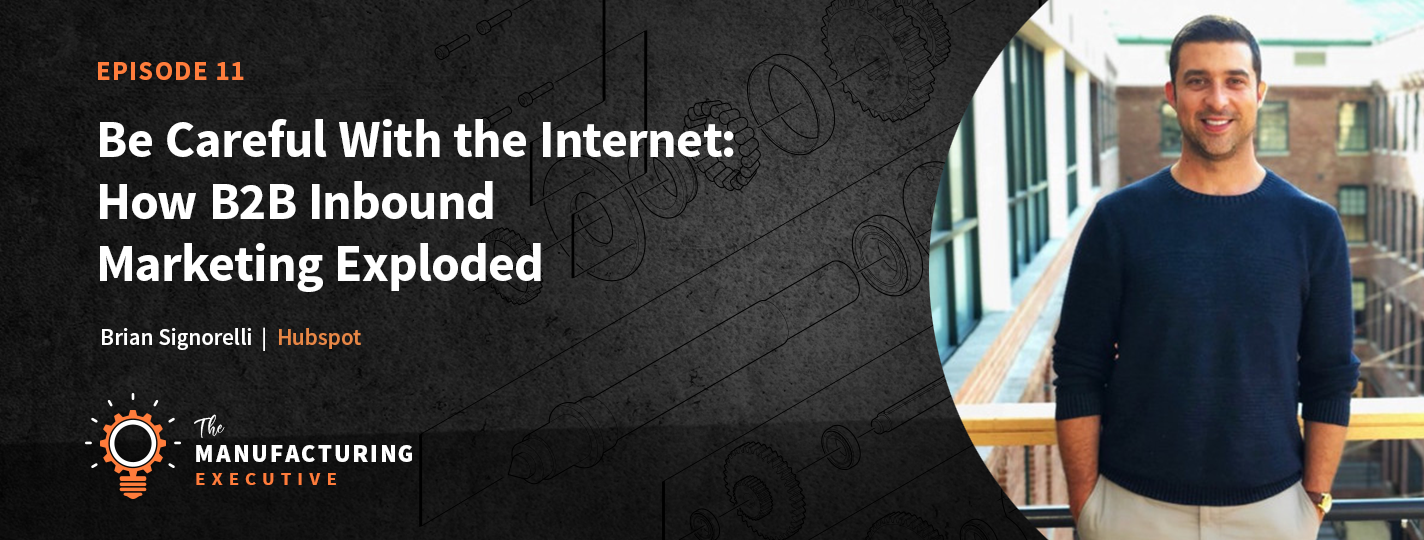
The Manufacturing Executive: Episode 11
Listen to this episode here or on Apple Podcasts, Spotify, Stitcher or Google Podcasts.
Episode show notes
It’s 2010. Apple has just released a new product called the iPad. The Lakers just won their fifth championship under Phil Jackson. And the BP oil spill was all over the news. In the marketing world, a trending movement started to take hold. It was called inbound marketing.
Today, inbound marketing has exploded, and B2B businesses are taking the next logical step to inbound selling. Brian Signorelli, senior director of sales at Hubspot and author of the book Inbound Selling, joined this episode of the podcast to discuss the history and future of inbound.
Brian and I talk about:
- Why inbound marketing’s popularity spread so far
- Great resources to learn more about what inbound is and why it works
- Extending inbound marketing principles into the sales side of an organization
Resources we talked about:
To ensure that you never miss an episode of The Manufacturing Show, subscribe on Apple Podcasts, Spotify, Stitcher or Google Podcasts.
Transcript of episode
Joe Sullivan:
Welcome to another episode of the Manufacturing Executive Podcast. This show is being brought to you by our sponsor, CADENAS PARTsolutions. I’m Joe Sullivan, your host, and a cofounder of the industrial marketing agency, Gorilla 76.
Joe Sullivan:
So let’s transport ourselves back in time about 10 years. It’s 2010, Apple had just released a new product called the iPad. The Lakers had just won their fifth championship under Phil Jackson. The BP oil spill was all over the news. And in the marketing world, there was a trending movement starting to take hold called inbound marketing.
Joe Sullivan:
The term inbound marketing is common speak now, and it has been for a while. But I’d be willing to bet that most of you in the manufacturing sector listening to this, would have probably stared at me with glazed-over eyes if I asked you to tell me what inbound marketing is 10 years ago.
Joe Sullivan:
Today, my guest is someone who has witnessed firsthand, and also contributed to, in a lot of ways, the explosion of inbound marketing in the B2B world over the last decade. Brian Signorelli is the senior director of partner acquisition at HubSpot, where his teams work with marketing, sales, CRM consulting, and other professional service companies to help them grow their own businesses and their client’s businesses faster.
Joe Sullivan:
He regularly writes, develops, and presents inbound sales content for HubSpot’s Solution Partners and their customers. He’s been with HubSpot since 2012, and has seen the company grow from 5,000 customers, through its 2014 IPO, to over 80,000 today. Prior to that, Brian worked as an analyst for a management consulting firm, as well as a small startup in the Boston area. He resides in Boston, Massachusetts with his wife, Leah and their dog, Dixie.
Joe Sullivan:
Brian, it’s been a while since you and I have talked, and I’ve been looking forward to this conversation ever since you made my day a few weeks ago by agreeing to come on the show. So welcome.
Brian Signorelli:
Thank you. Thank you, Joe. Yeah, it’s crazy that we first talked, I mean, what about eight years ago now? And it’s great to stay in touch with you over the years and see your business do well. And it was great to get an invite from you to jump on the podcast. So I’m to happy to be on with you today.
Joe Sullivan:
So I guess before we get into this topic of inbound, can you kind of briefly tell our listeners just a little bit more about you and your journey to this point? And also for anybody listening who doesn’t really know much about HubSpot, which is probably a small percentage of people at this point given the brand’s name at this point. But give us a little bit about you and an overview of what HubSpot is, and what the software does.
Brian Signorelli:
Yeah, absolutely. I’m happy to. So, I think you know this, but before I came to HubSpot, I was actually a HubSpot customer. I was working with a buddy of mine, and his dad, and a few other people, and we were trying to get this little startup called Gifts On Time going. I was hired to basically be the head of sales/marketing/other stuff. I mean, you know how it goes with a small business. Kind of did everything.
Brian Signorelli:
When I started working with them, the product was just about to come to market, and I go, “Okay, great. We need to start generating awareness, and generate leads, and website traffic, and get signups, and get some revenue here. Because we’ve invested a lot and we want to get this business going.” And I said, “Yeah, marketing, lead gen, seems easy enough. Sure I’ll do that.”
Brian Signorelli:
It’s really hard, obviously, for anyone who has worked in the marketing profession or in sales, it’s really, really hard. And so we spent… I mean, I’m not kidding. We literally spent hundreds of thousands of dollars on website design. We hired an SEO specialist. We hired a pay-per-click specialist. We did trade shows. We did advertisements in local newspapers. We did advertisements in national rags and all that type of stuff.
Brian Signorelli:
It felt like we tried literally every known outbound marketing to… I didn’t know it was called outbound them, but I just was like, “This is what marketing is.” We tried every one of the tactics we thought marketing was, and we just got crickets. This was 2009… Or 2010, actually. This was 2010. So, good intro.
Brian Signorelli:
And we’re just like, “This is crazy. How are we putting so much money and effort into all these marketing efforts and literally getting nothing for it?” So, frankly, we were down to our last 10 or $15,000 of budget that we had for marketing. And we had a choice between hiring another marketing agency versus using HubSpot on our own.
Brian Signorelli:
And at the time, we had decided to use HubSpot. That’s not to say that using an agency would have been a bad idea, but they were basically only managing our social media profile, they were doing the trade show stuff, helping us design booths. It was stuff that we were basically already doing, and it wasn’t fundamentally different.
Brian Signorelli:
So anyway, we started using HubSpot on our own. I think within the first week of getting it up and running, writing our first blog post, our first call to action, our first landing page, we generated something like 40 leads right away. And I was like, “Oh my gosh, this is amazing. This works so well.”
Brian Signorelli:
Ultimately, six months in, we didn’t stick to it because it’s hard. It’s hard to write a lot of blog posts that are actually good and worth reading. It is really hard to develop premium content like ebooks, white papers. Diagnostic tools. Things that people are willing to give a little bit of contact information for.
Brian Signorelli:
And so I’d certainly… Anyone who hasn’t adopted the concept of inbound marketing, I would highly encourage you to consider working with an agency. Unless you really feel like you’ve got a lot of time, a full staff that has mastered this, knows what they’re doing, is ready to go, and you’d prefer to keep everybody in-house.
Brian Signorelli:
Anyway, fast-forward to today, I’ve been at HubSpot for eight years. I’ve been on the sales team for the entire time. I’ve worked with basically our marketing agency partners, our sales partners, our integration partners. I’ve held various roles as an individual contributor. Different management roles.
Brian Signorelli:
And yeah, it’s been really cool to see HubSpot’s growth and journey over those past… Almost past decade now. Happy to elaborate further, but that’s probably more than you were betting on there.
Joe Sullivan:
No, that’s great. So, I mean, you’ve seen some serious changes to the marketing landscape, not only inside your company at HubSpot, but in general across the marketing landscape in the last eight or nine years or so.
Joe Sullivan:
As I suggested earlier, inbound marketing wasn’t really even common language for most businesses back in the early 2010s. What do you think drove this explosion, in terms of the acceptance of inbound marketing, and the spread of its popularity.
Brian Signorelli:
Yeah. I mean, my take on this is that it just takes time for people to change and to get with the program. And so if you think about… Don’t worry, I’m not going to take you through a play-by-play of the last 20 years. But if you think about the last 20 years, the internet only kind of became widely available like in the late 90s, early 2000s.
Brian Signorelli:
And people were highly suspicious of it. I mean, I remember… Frankly, I was probably a teenager, a kid. I was really a teenager at that point. I remember wanting to buy something off of eBay. And my mom was like, “Be really careful with the internet. You don’t know who’s out there.”
Brian Signorelli:
It takes a long time for businesses to realize that, “Okay, what the internet represents, it’s not just I need a website to prove to people I exist in the world.” It’s, “Oh my gosh, this is actually a way that…”
Brian Signorelli:
It was really Google that fundamentally transformed the way that we find information. I mean, just think of the simple concept of, whenever you have any questions. It was like, “Oh, I don’t know about blah, blah, blah.” “Just Google it, just Google it, just Google it.”
Brian Signorelli:
Well, what that means for businesses is, if you are not coming up in the search results on the first page… When someone is asking questions that is relevant to your subject matter expertise, to your domain, to your products, to your services, if you’re not showing up, then you don’t exist.
Brian Signorelli:
So I think from 2000 to 2010, a lot of people were like, “Yeah, we need a website. We need some digital presence. I don’t really know exactly what we’re doing, but we need something.” Then I saw this kind of second wave of like, “Oh, we need content.” But do you remember, probably 2000… I don’t know, five, 2010. There was a lot more content online, but a lot of it was paid. So you had to pay $500, or $1,000, or $3,000 for content.
Brian Signorelli:
And then, it wasn’t HubSpot necessarily. I think that HubSpot was part of that. But I think people started realizing, “Oh my gosh, we can actually start generating a bunch of website traffic and leads if we give our content away for free, especially if it’s something of value to people.
Brian Signorelli:
And so, the evolution is like, if you think about sales and marketing in the context of the internet over the past 20 years. Before Google, all the control was, frankly, in the hands of sellers. If you’re a buyer, you needed to call a company to actually get access to information. And the seller could hide behind this kind of iron curtain of like, “Well, you need me to understand what it is that we do and what your options are, etc.”
Brian Signorelli:
Google flipped that equation. All the power is now… The internet, Google, however you want to refer to it. All the power shifted away from the seller and into the hands of the buyer. And so now, I think businesses have realized that, because buyers can do all this research on their own, they can basically get answers to almost any question they want on their own without ever talking to a sales rep.
Brian Signorelli:
I think that’s kind of what has driven this change, and driven this adoption of inbound marketing. If I want to exist, if I want anybody’s attention, if I want anybody’s interest, we need to actually be adding value in some way that lines up with the way people, frankly, consume information these days. Which is really through Google searches. That’s really all it is.
Joe Sullivan:
Yeah, I think you nailed it. I think that’s right on the money. And that shift in power from seller to buyer has just been so transformational.
Joe Sullivan:
I mean, the expectation is now that you’re going to be able to obtain this information, and if you’re not the one publishing it, your competitor is. And who’s going to have the visibility, who’s going to be the first to gain trust and attention? Well, whoever’s putting the insights out there, right?
Brian Signorelli:
Absolutely. Absolutely. Yeah, I mean, you have to, and we’ll get to this, but you have to be adding value in some way that your competitor isn’t, or that is going to help your buyers get to the point of being ready to make a purchase, or even consider a purchase, for that matter.
Brian Signorelli:
I mean, just think about the world we’re living in. It’s the age of convenience. Everything is available on demand. Why would I ever pick up the phone to call a business to learn about them, when I can accomplish all of that, on my own terms, in my own time, at any hour of the day that I want.
Brian Signorelli:
And so I’d much rather talk to the 24/7 sales rep, so to speak. Which should be your website, as long as it actually has like meaningful blog content, resources, pricing information. And if it’s not there, I’m going to find it on Quora, I’m going to find it on other review sites. I’m going to find it somehow.
Brian Signorelli:
But I’d much rather do that on my own time, and on my own terms, than talk to one of your sales reps, frankly. And that’s coming from someone who has been a sales rep.
Joe Sullivan:
Yup. Makes total sense. And I think that the pushback that I’ve heard from time to time is, “Well, you can’t replace a sales person, a real human conversation, with a website or with written content.” But I think people are missing the point when they make that argument.
Joe Sullivan:
If your buyer is already out there looking for information on their own, and the expectation is they’re going to be able to obtain it, you need to be the one providing it. That content’s not there to replace the human being, in a lot of cases. Especially in complex B2B buying processes.
Joe Sullivan:
But it’s going to be the first step. It’s the first step in the sale. The first interaction somebody has with you, is going to be your content and whatever you’re able to put out there online.
Joe Sullivan:
And not until you’ve earned enough of their attention and trust that maybe you understand their issue, you’ve seen it before. You could help them solve it. It’s not until they have that sense of confidence that they’re going to pick up the phone and call you, right?
Brian Signorelli:
Absolutely. Absolutely. They’re going to consume… I can’t remember the most recent stat from the Content Marketing Institute, but it’s something like, the average buyer’s going to consume seven to 15 different pieces of content before they ever even engage with your sales rep.
Brian Signorelli:
So if you aren’t making a really strong first impression, and giving your prospective would-be buyers access to information that they are looking for before they are even ready to talk to one of your sales reps, then your sales reps will never even have the at bats. They’ll never even have the chance to have that conversation.
Brian Signorelli:
And that’s the whole point. It’s like, look, we’re not trying to replace sales reps. It’s just, if you want to give your sales reps as many at bats as possible, you will do inbound/content marketing. That is how people are generating leads these days.
Joe Sullivan:
Yup. Right on. We’re going to take a 30 second breather here for a word from our sponsor, CADENAS PARTsolutions.
Joe Sullivan:
Let’s talk real quick about getting specified. Are you a component manufacturer? Maybe you sell architectural products to parks or large facilities. Engineers and architects need models of your products to test fit in their designs.
Joe Sullivan:
That’s where CADENAS comes in. They help you create a dynamic, shareable, CAD catalog you put on your website. Designers can preview the product from any angle, and download it in the format they prefer. They get the data they need for their design, and you get a fresh lead to add to your marketing pipeline.
Joe Sullivan:
To get one of your products turned into an online 3D model for free, use the code executive at partsolutions.com/executive.
Joe Sullivan:
Well, let’s talk more about content for a minute, while we’re sort of on that topic. So, I’ve been consulting manufacturers specifically, now for about a decade.
Joe Sullivan:
Manufacturers love talking about their products. They love talking about themselves, and what they do, and how great their customer service is. And I always say that there’s absolutely a place for that, but nobody wants that information until they are in the process of actually vetting you. They need to first believe that you understand their issues and goals. It’s really those things that I believe your content needs to address.
Joe Sullivan:
So, can you talk a little bit from your perspective, Brian, about what role you think content should play. And especially during those early stages of an often long and complex buyer’s journey?
Brian Signorelli:
Absolutely. So are you familiar with… I mean, I read this book probably a year or two ago, that just… I have not been as excited about a book since I learned what inbound marketing was and I read Brian Halligan and Dharmesh Shah’s Inbound Marketing. Are you familiar with StoryBrand by any chance, by Don Miller?
Joe Sullivan:
Yes. Yes.
Brian Signorelli:
Okay. So this one just popped for me. I’m like, “Oh my gosh. He’s got it right.”
Brian Signorelli:
Okay, so here’s the thing. The premise of that book is basically, “Look, you need to clarify your message to your buyers.” And where most businesses get it wrong with content marketing, or just really marketing in general, is that they view themselves as the hero in the hero’s journey. And you need to flip that equation.
Brian Signorelli:
Briefly walk you through it. I’ve got the infographic pulled up, just so I remember this. Seven-ish stages of the hero’s journey. There is a character, the hero, who has a problem, who meets a guide. And that guide gives them a plan, part four. Then the guide calls them to action, step five. And that, step six, results in either realizing their hopes, their dreams, their goals, or ends in tragedy that they’re trying to avoid.
Brian Signorelli:
And what really just popped to me was that where most businesses get it wrong, is that they view themselves… And it’s reflected, frankly, like when you said these companies that want to talk about their products, and how great they are, and their services, and how awesome they are. That is a reflection of you thinking that you are the hero in the buyer’s journey.
Brian Signorelli:
You are not the hero in the buyer’s journey. Your customer is the hero in the buyer’s journey. And your content needs to take them through that journey. You are simply the guide.
Brian Signorelli:
So like your customers are Luke Skywalker. You are Yoda, as the business. Doing all your marketing. I think that’s the main thing that businesses miss.
Brian Signorelli:
Look, you need to basically paint this picture to help your customers understand that you understand what their fears are. You understand what their challenges are. You have a plan. You are calling them to action to execute on that plan. And if they execute on that plan, they will realize their hopes, their dreams, their business goals. Whatever those success outcomes they are looking for. That is the role that your business should be playing in that hero’s journey.
Brian Signorelli:
And it might sound crazy, but I’m telling you, take a page out of the Hollywood playbook for how movies are written, apply that to your own marketing. All my chips are in on that concept of how businesses should be thinking about marketing these days.
Joe Sullivan:
Yeah, I love StoryBrand. I stumbled across it through a few different sources probably six months ago as well, and read it, and immediately loved it. I think it’s a perfect analogy really.
Joe Sullivan:
And it’s such a logical thing, too, to think about, it’s about your customer, right? It’s such a cliche in business, but then people don’t practice it. So I love having an analogy that is about making the customer the hero. You’re there to guide them, you’re here to help them understand their problem, figure out different ways to get to the solution. And that’s the role of your content.
Joe Sullivan:
So, to make it a little more tangible, talk to me a little bit about content. What could content be for a business to business company? What role or what form could that take?
Joe Sullivan:
I love Marcus Sheridan’s stuff where he talks about problem-based content and comparison content, and review-based content. What do you see that works?
Brian Signorelli:
It’s super simple. I’ve been saying this for eight years, at least. 2010… Well, 2012 I started at HubSpot. And obviously I had the problem of saying, “Hey, I’ve noticed your website doesn’t have a blog.” And people basically laughing me out of the room, being like, “What the hell’s a blog? Why would I ever use one?” Well, who’s laughing now?
Brian Signorelli:
However, for people who would actually entertain it, they’re like, “Okay, all right, I’ll blog. I’ll take a bet on you. I will blog. I have a problem. What do I blog about? What content do I write about?” And I said, “This is going to sound overly simplistic, but I’m telling you, this is what works. You should write content that answers the questions that your prospects are asking.”
Brian Signorelli:
So, think about… The easiest way to generate your next 100 blog articles, is to sit down with your sales team, with your support team, your customer service team, and just say, “Hey, tell me the top two or three most common questions that you’re getting from our prospects, from our customers, whoever it is.” And I guarantee you that… All you do is you take what their questions are. You flip the question into a statement.
Brian Signorelli:
For example, someone for HubSpot might be saying, “I’m really struggling to generate more leads. How do I generate more leads?” The blog article itself, or an ebook or a white paper, whatever kind of premium piece of content, would be something like Five Proven Strategies to Generate More Leads to Your Website. It’s literally just taking the question, flipping it around, making it a statement.
Brian Signorelli:
And then the best part is, if you know what you’re talking about, and you should, because whatever questions they’re asking you, your company should be a subject matter expert in. And if you don’t have people who are good writers again, hire Joe and his team. You just literally answer the questions that people are asking. It’s a very simple equation. You don’t need to overthink this.
Brian Signorelli:
Of course, there’s a bunch of finer points of content architecture and making sure that your website is optimized to get found, and you’re promoting the content. There’s a lot more that goes to it. You can’t just write a blog article and be like, “Okay, I’m done. I can walk away.”
Brian Signorelli:
But in terms of getting the meat of it, it’s literally just answering the questions that people are asking. Because your hope is, when they are Googling some question that they have, you want to show up first, second, third, just not any later than 10th. But hopefully in the top 10 is when you’re going to show up.
Brian Signorelli:
And if your answers are showing up when they’re asking Google questions, then guess who’s going to get the attention? Your business, not your competitor.
Joe Sullivan:
Yup. Absolutely. Nailed it. And, let’s just say you’re a manufacturer. You’re a automation service provider, something like that. And you hear from your customers in struggling with downtime on the plant floor, or cost of labor, or whatever it is.
Joe Sullivan:
Now you address that, that way. Here are ways you can reduce downtime. There’s your blog post. Five Proven Ways to Reduce Downtime, or something like that. There’s a million ways to do it, but let those common questions that your sales team’s hearing over and over again, and those problems you’re trying to solve for your customers, form the foundation of your content.
Joe Sullivan:
And now when you start… People will find you. There will be context for a conversation with them when it gets to that point. I think it’s a perfect framework.
Brian Signorelli:
Yeah.
Joe Sullivan:
So simple, right?
Brian Signorelli:
Yup. It is very simple. Very simple.
Joe Sullivan:
So you published your book, Inbound Selling in 2018, where you sort of extend these principles of inbound marketing into the sales side of an organization.
Joe Sullivan:
Can you talk a little bit about, what’s the topic of the book? What does inbound selling mean as opposed to inbound marketing?
Brian Signorelli:
Yeah. I mean, inbound selling is really just, Okay, well, if inbound marketing is any form of marketing designed to develop someone’s trust and at least get them to feel comfortable exchanging a little bit of information, like even their first name, last name, email, inbound selling is literally the next step in that process.
Brian Signorelli:
So if you’re changing the way you’re doing marketing, and you’re starting to generate these inbound leads through your website… Where I’ve seen most businesses really fail is that they might be very successful generating a lot more website traffic, generating a lot more inbound leads. But then the sales team is like, “These leads are garbage. I can’t sell to these people.”
Brian Signorelli:
The reality is, sure, are some of the leads garbage? Yeah, they probably are. But I think the problem is that most salespeople, and this is not true everywhere, of course, but certainly over the past 10 years, salespeople have had to adopt the way they actually think about engaging leads. It’s not like the cold call, the pitch, like, “Hey, I know I caught you out of the blue, but do you have five minutes to talk?” That’s not what it’s about. That’s not how you approach an inbound lead.
Brian Signorelli:
So the idea of the book Inbound Selling, is really just a reflection… I mean, it’s literally the HubSpot sales playbook. It’s everything that I’ve learned at HubSpot over the past, well, I published it two years ago. So, the first five years at HubSpot.
Brian Signorelli:
Everything that is in that book is still true for how HubSpot sells today. And it really kind of guides businesses through rethinking the way that their sales team needs to engage buyers in the age of convenience, in the age of content marketing, to make sure you’re getting the most out of those investments.
Brian Signorelli:
And, it goes on too, and talks a little bit about cross functional alignment, about managing sales teams, developing people. I had a really kind of funky, but I thought interesting chapter from a sales futurist named Derek Wyszynski, the last chapter, kind of talking about this dystopian future of sales and where we could theoretically be heading in the next 20 or 30 years.
Brian Signorelli:
But yeah, that’s really it. It’s just sort of like, all right, look, marketing’s done its job. I mean, not everyone, but it feels like a lot of people, certainly today, have kind of… Most people have got with the program. They’re like, “Okay, good. Got it. Website should be more than just a brochure. It should be a lead generator. It should be an educator for my potential prospects.”
Brian Signorelli:
Inbound Selling is literally just that extension. It’s the next step of, “Okay, great. You’re doing all this work. You made a huge investment to actually get more website traffic and leads. Don’t screw it up. Make sure your sales team actually understands how to work these leads.”
Brian Signorelli:
Because, frankly, it’s a bit different than what they are used to, especially if they have been around the block a few times and have sold from say, I don’t know, the year 1990 through the year 2010. The way sales worked then, there are a lot of things that are still true today, certainly, but there are a lot of things that aren’t true that you have to do differently today. And that’s kind of what Inbound Selling gets at the heart of.
Joe Sullivan:
Well, it’s such an important topic, and I see this really time and time again. I see this disconnect between marketing and sales in the manufacturing companies that we consult.
Joe Sullivan:
What you said is exactly true. They’re used to maybe leads… A request-a-quote lead, or an RFQ form submission, is so different than somebody who is, say, downloading a white paper or subscribing to your newsletter. But a more traditional sales person is inclined to kind of just treat it the same way. “Oh, I have a new lead. I’m going to call them and try to sell them something.”
Brian Signorelli:
Yup.
Joe Sullivan:
Not going to work. Yeah, I think it’s a great topic. I think it’s a book everybody should check out, because I see this literally 90% of the time. There’s an adjustment to be made to selling this way when you start to really see that inbound funnel start working for you.
Joe Sullivan:
Well, Brian, last question I’ll ask you here. A lot’s changed in the last 10 years or so, as we’ve talked about. Where do you see things headed next with B2B marketing and sales?
Brian Signorelli:
Yeah, so three things I’ll touch on for that. And I’ve thought a lot about this for, I guess, the past decade. And try to pay attention to what businesses are doing, where things are going.
Brian Signorelli:
I think one thing that you’re going to see more and more of, I think you’re already starting to see more of, is now that everyone’s doing content marketing, how do you stand out? And I think that one of the things that you’ll see more and more businesses doing over the next two, three, five years, is creating a primary research. Doing original research studies on their own, and creating insights, and creating original information that no one can find anywhere else. That is one of the main keys, I think, to standing out today.
Brian Signorelli:
And, frankly, as a sales rep, one of the things I always tell my sales team is, “Look, if you cannot provide information to your prospect that they can find on their own, or that they’d be able to find on their own otherwise, then you by definition have no value.” If you’re writing blog content that is well known about topics that have been established, and there’s information, insight, that, frankly, you can get on 15 other websites, you’re not going to stand out.
Brian Signorelli:
So I think one thing you’ll see, and it’s hard, but I think there’ll be more original research done. And I think the companies that do that will really stand out.
Brian Signorelli:
The second thing, and this is… You might remember a guy by the name of Pete Caputa. He’s the CEO of Databox. He was the founder of the Agency Partner program at HubSpot. He clued me in to another marketing strategy that they’ve had phenomenal success with.
Brian Signorelli:
He said, “I think the place that a lot of marketers are getting it wrong today, is that they think they should be marketing to their audience.” And he’s like, “I think that’s wrong. They should actually be marketing with their audience.”
Brian Signorelli:
And so what he does is, he basically… Like we said, we have a bunch of these questions that prospects are asking. But instead of answering these questions himself at Databox, he actually sends these questions out to all of his newsletter subscribers, his customers, and says, “Hey, I’m writing a blog article. I’m looking for experts like you to contribute some of your thoughts to this. Would you be interested in writing a little snippet? We’ll feature you on our blog,” so on and so forth.
Brian Signorelli:
The really cool part about that is, you’re making your prospects and your customers kind of, I wouldn’t say famous, but giving them a little bit of street cred with their peers. You’re also offering to drive an inbound link back to their website, and often they will do the same for you, which helps you drive more and more marketing.
Brian Signorelli:
I think it’s in a really early stage, but I think Pete is onto something. And I can’t say that I’ve seen a ton of businesses adopt this yet. I know you see a lot of these like roundups, and insights from the top 10 influencers, and blah, blah, blah. I think marketers are getting closer to the right strategy, but I think you’re going to see more and more of that over time is, stop marketing to your audience, market with your audience. I think that’s an interesting paradigm shift.
Brian Signorelli:
And then the third thing that I would point to is, I think so many businesses are missing the mark with leveraging their customer base as a source of, frankly, new business.
Brian Signorelli:
If you think about how hard it is to win new accounts versus grow existing accounts… It’s not to say that you want to rely purely on net new lead gen to grow your business. But your, customers have already made the investment. They’ve already taken the bet on you. They’ve already had, hopefully, an amazing experience with you.
Brian Signorelli:
And so I just think that there’s… And I see it a little bit in B2C. I mean, companies like Uber, Zoom, Slack. I mean, there’s all these businesses. Even the B2C apps. It’s always like, “Here’s your referral code. Refer a friend, get 10, $15 off,” whatever.
Brian Signorelli:
I’m not suggesting that industrial manufacturers should be offering $15 redemption codes to make referrals. And I don’t know what’s right. I’m not an expert in that space. But I would challenge you all to think, “What more can we be doing to drive awareness for our business by turning our customers into promoters of our business in a way that balances the value equation.” Where, what do they get in exchange for what they’re giving?
Brian Signorelli:
I don’t know exactly what that looks like. Probably take some creative people to figure that out, to think through it, but don’t underestimate the value of your customer base. Because they are the ones that have already made that bet on you. Figure out how to turn them into promoters of your business, and then that will continue powering the flywheel that we talk about at HubSpot.
Joe Sullivan:
Great answers. Yeah, a really thoughtful response. And, per your numbers two and three there, what I really like is they’re both about, you’re delivering value and getting something in return just through partnerships and relationships.
Joe Sullivan:
Creating content with your potential customer, you’re putting the spotlight on them. It’s not that different from a podcast where you might be interviewing potential future customers so that you can hear from them, build a relationship with them. Then their peers can learn from that and it sort of spreads. And in your last example, leveraging those relationships with clients, creating value for them in some way, and they are happy to return that to you.
Joe Sullivan:
So I think you’re onto something. I think it’s right on the money.
Brian Signorelli:
We shall see.
Joe Sullivan:
We’ll see. Well, awesome, Brian. Great conversation. Really appreciate you coming on. Just a lot of really great insights from somebody who’s been there to see the rise and explosion of inbound along the way. I’m sure it’s been an interesting perspective being inside of HubSpot, who’s really was kind of been at the forefront of all this.
Joe Sullivan:
Can you tell listeners where they can connect with you online, where they can find your book, Inbound Selling, and also where they can learn more about HubSpot?
Brian Signorelli:
Yeah, absolutely. I’m happy to connect with anybody on LinkedIn. There are, as hard as it may be to believe, there are multiple Brian’s Signorellis online.
Joe Sullivan:
No kidding.
Brian Signorelli:
Yeah. Just make sure that if you connect with me, I’m pretty sure I’m the only one in the Boston area. I am in Boston, Massachusetts.
Brian Signorelli:
Yeah, so LinkedIn, Brian Signorelli. Happy to connect with anybody. The book, Inbound Selling, is available on Amazon and a bunch of other places. Amazon’s probably easiest if you want to check it out. It’s also an audio book, if you prefer audio books.
Brian Signorelli:
HubSpot, hubspot.com, or reach out to me through LinkedIn, I’m happy to get you connected with anybody who could answer questions you might have or help you in some way. We also have a bunch of free products, if you want to try before you want to talk to anybody. We try to walk the walk on that.
Joe Sullivan:
Beautiful. Yeah, HubSpot definitely practices what they preach. So there’s a lot of great resources you can find there just for learning purposes even before you’d be ready for the software, potentially.
Joe Sullivan:
Before we wrap it up, I want to say a big thank you to our sponsor, CADENAS PARTsolutions, for helping make this show possible. All right, well, Brian, thanks a ton for joining. Again, great conversation. And for the rest of you, I hope to catch you on the next episode of The Manufacturing Executive.
Brian Signorelli:
Thanks, Joe.
Speaker 2:
You’ve been listening to The Manufacturing Executive Podcast. To ensure that you never miss an episode, subscribe to the show in your favorite podcast player.
Speaker 2:
If you’d like to learn more about industrial marketing and sales strategy, you’ll find an ever-expanding collection of articles, videos, guides, and tools specifically for B2B manufacturers at gorilla76.com/learn. Thank you so much for listening. Until next time.

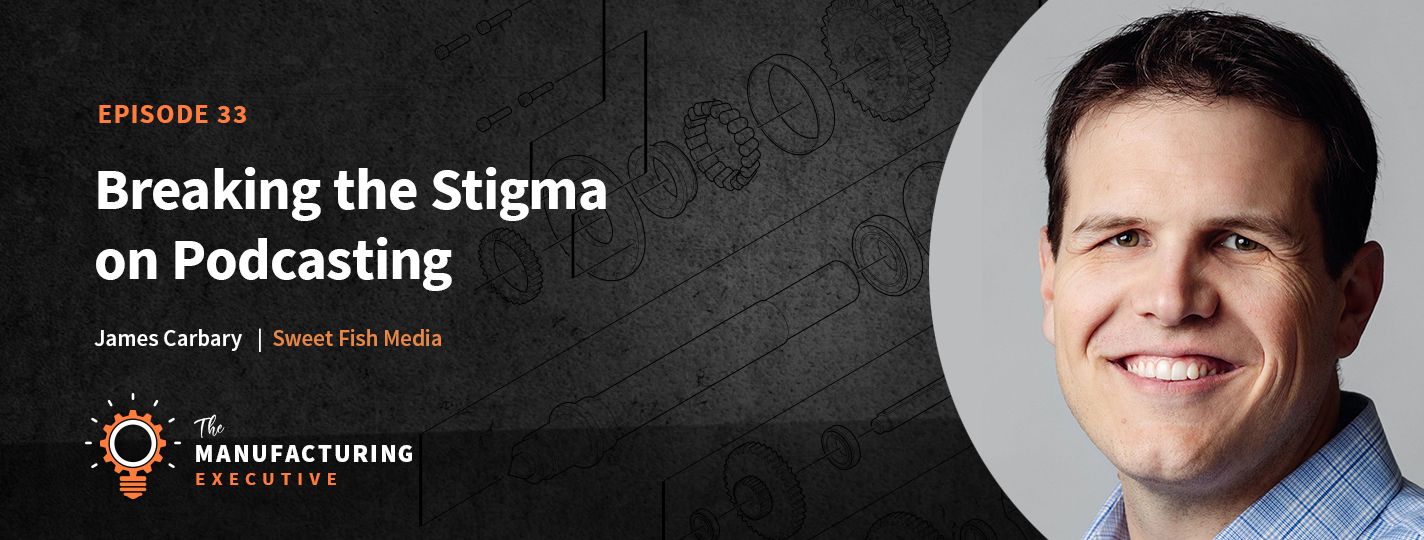
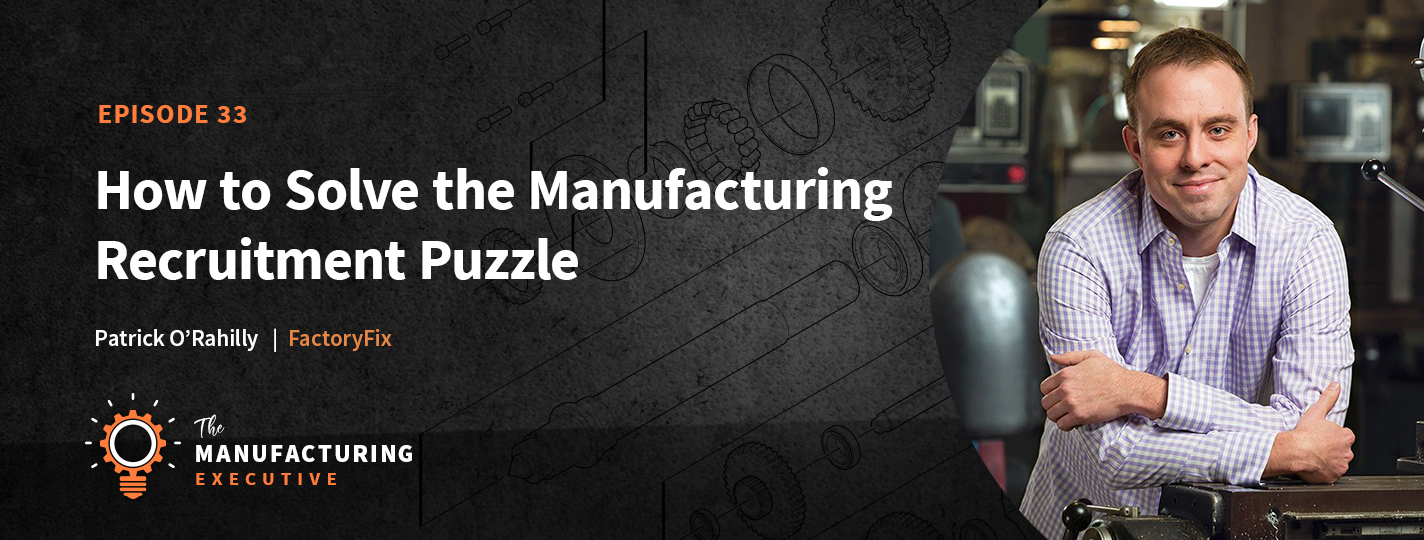
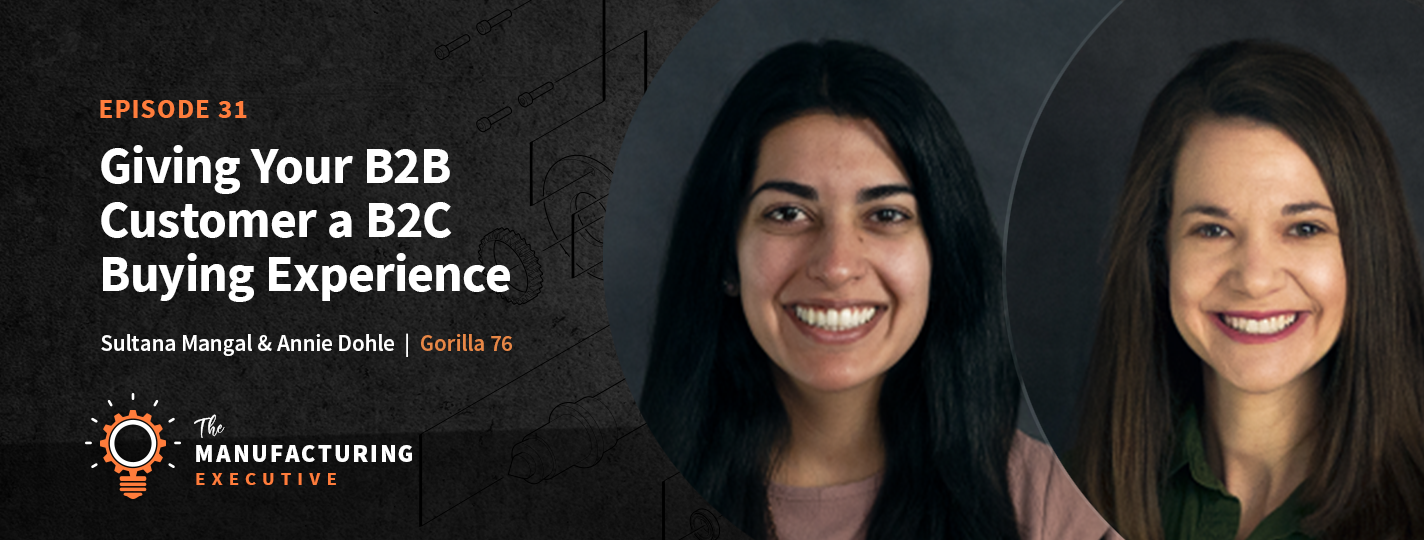
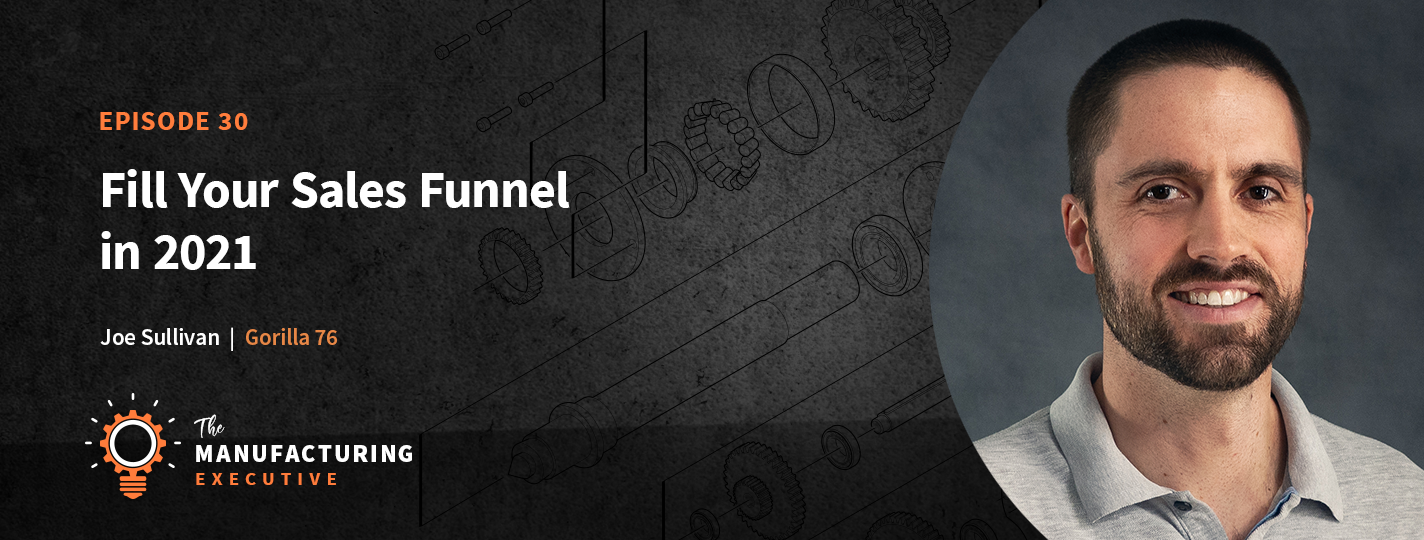

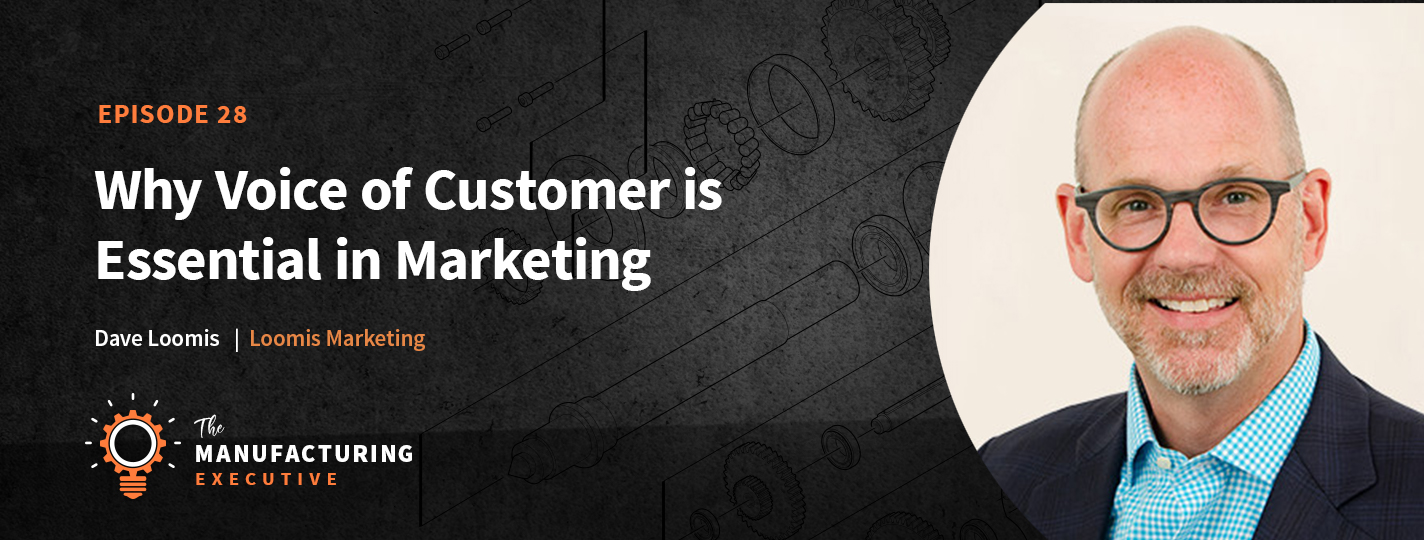
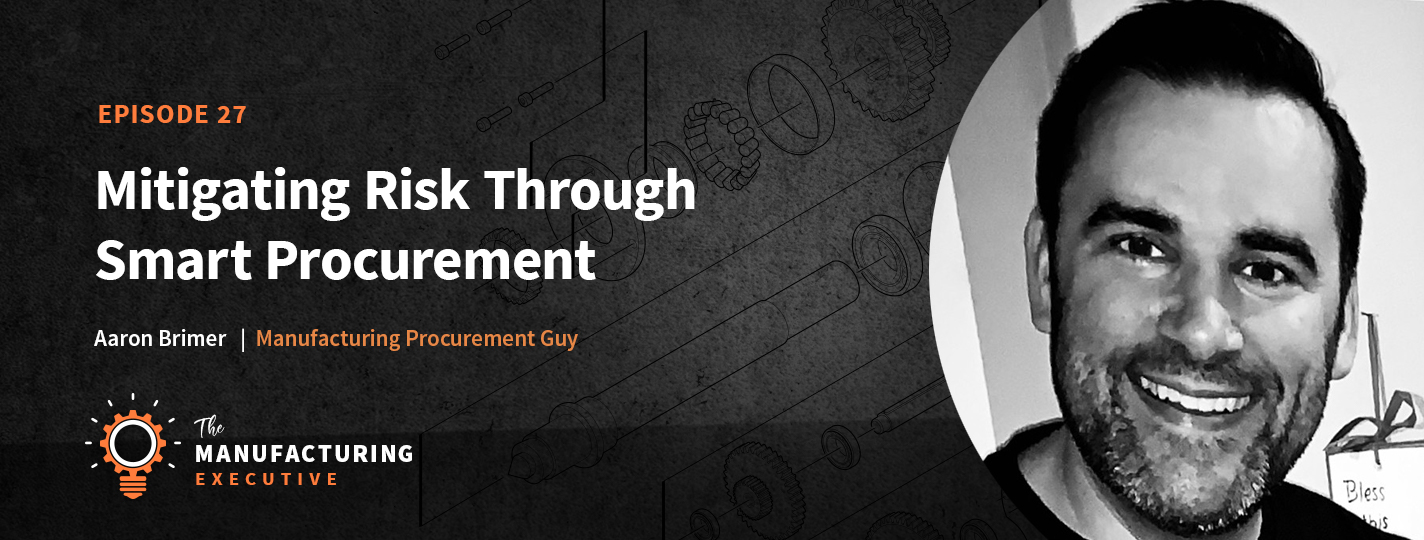


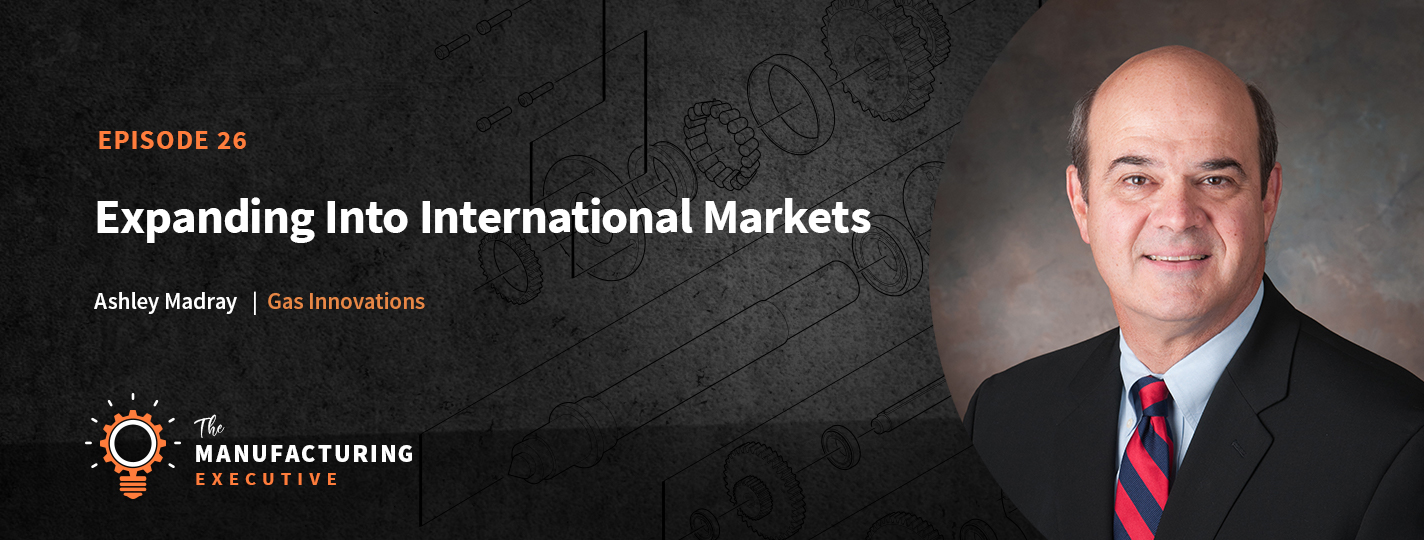
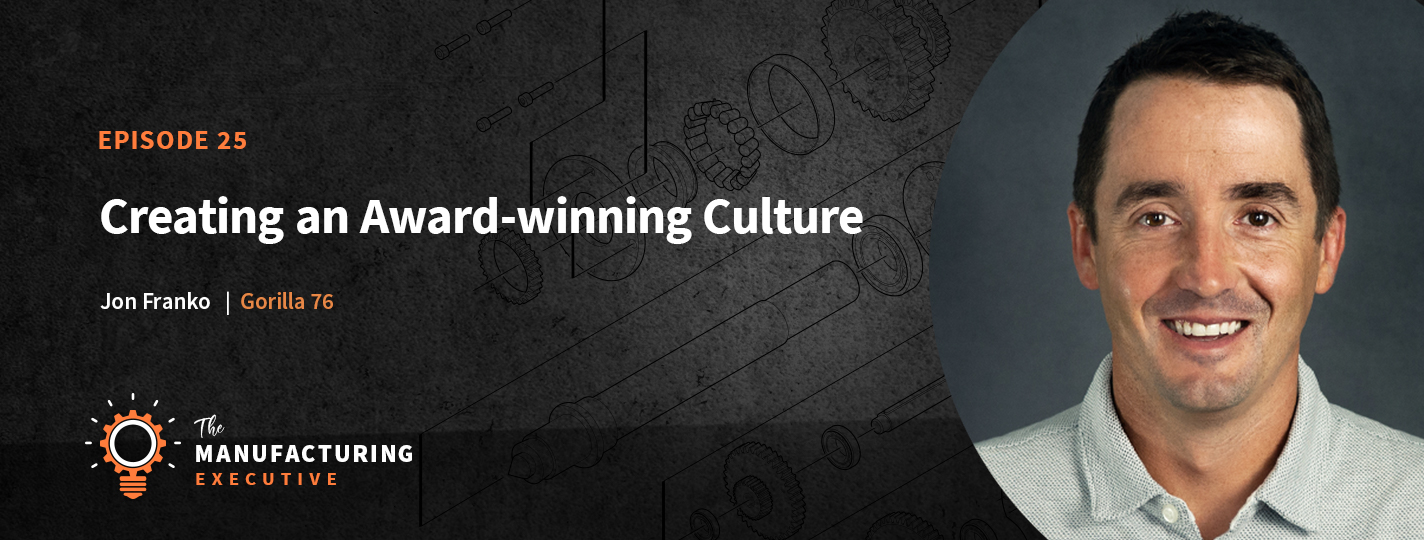

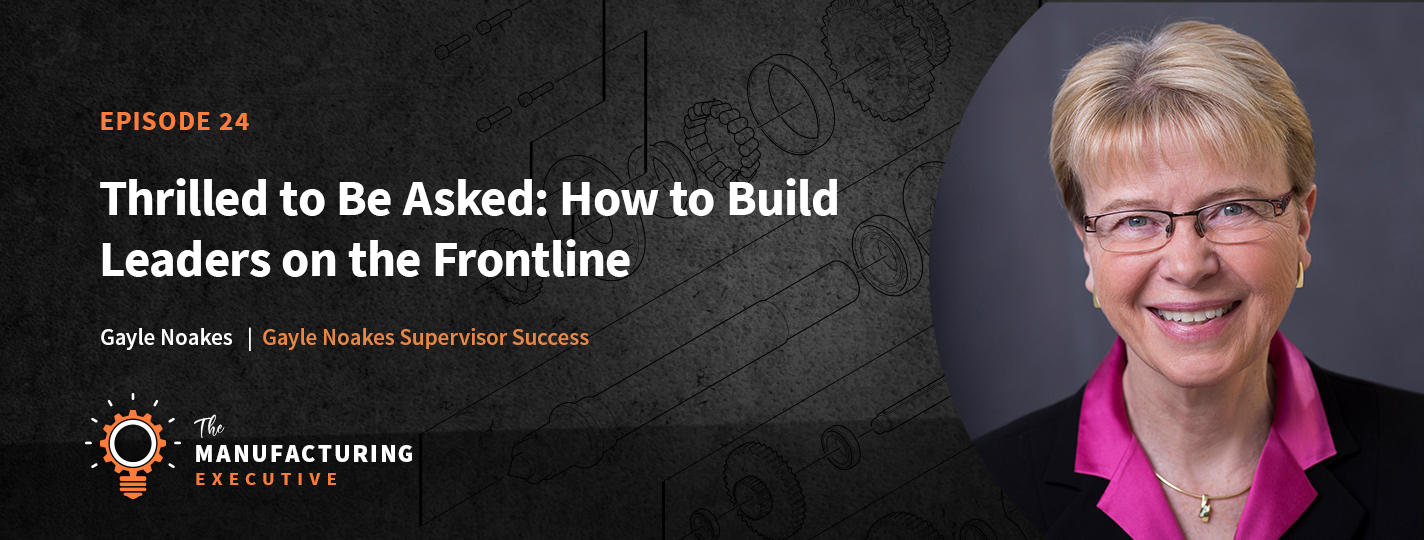
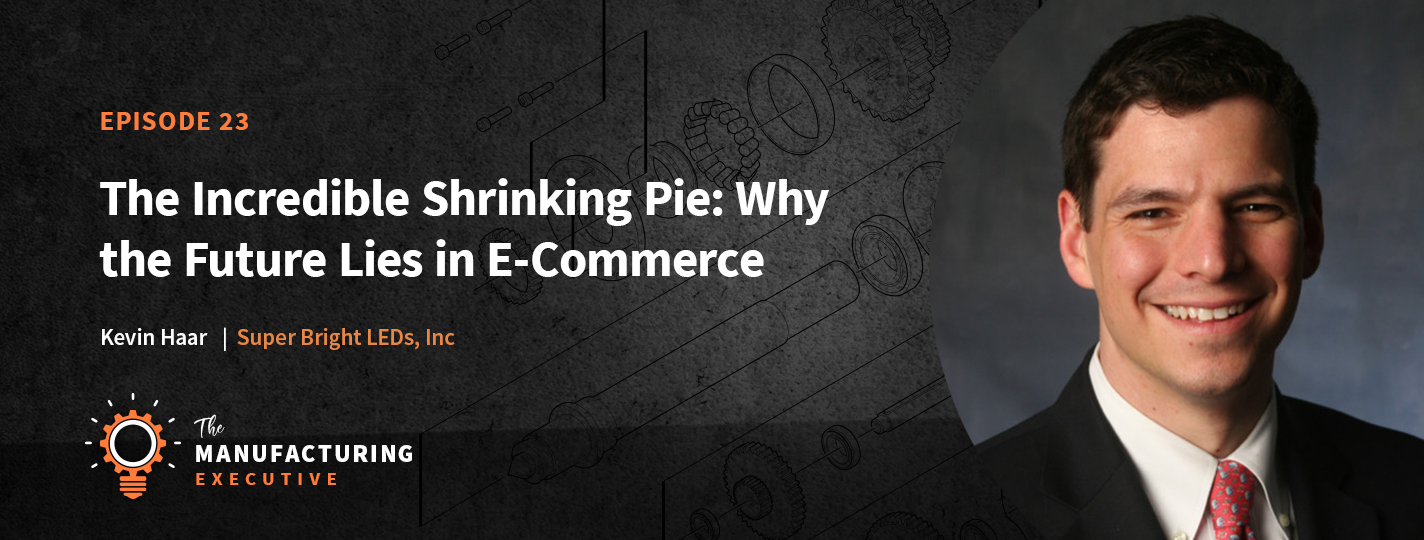

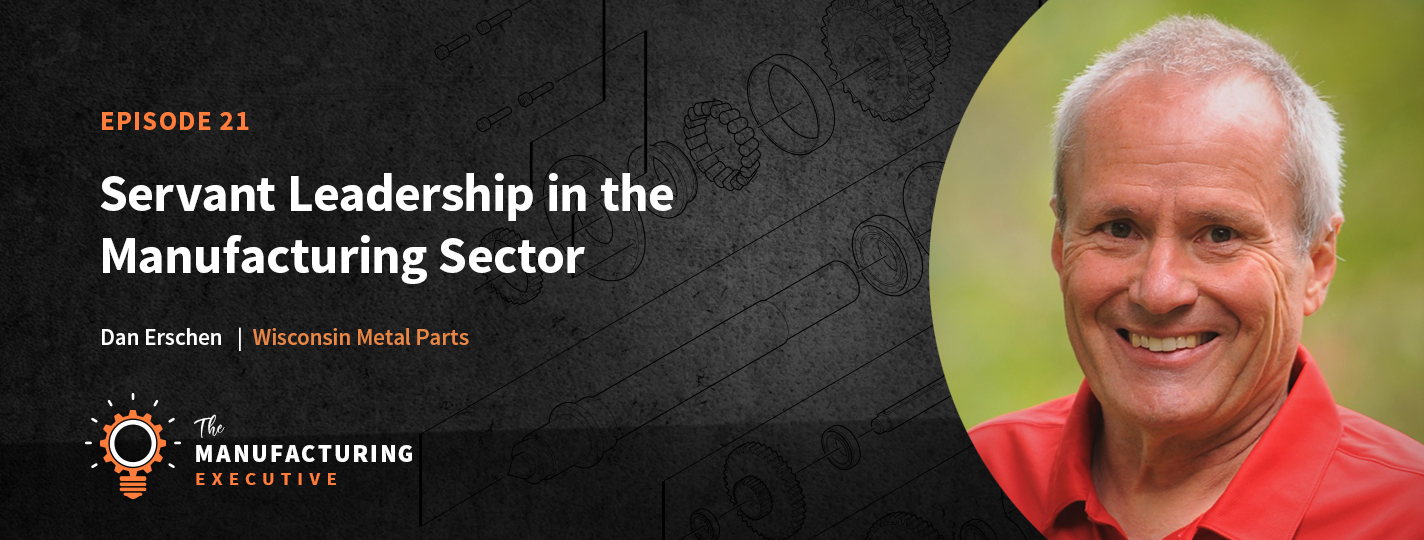
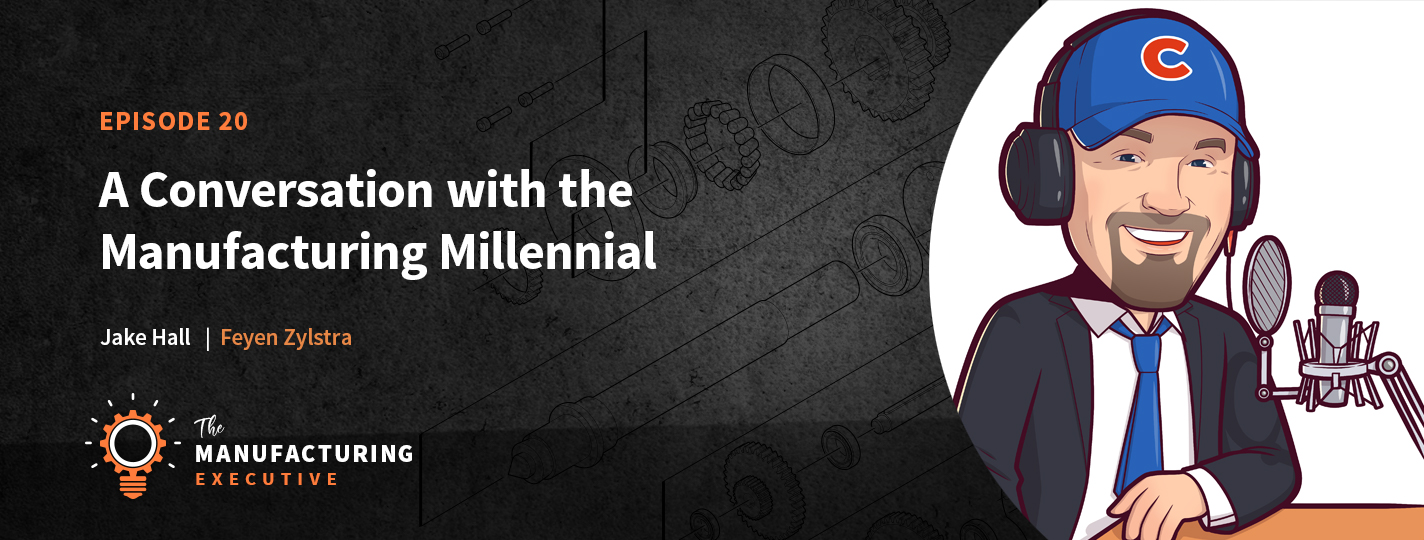

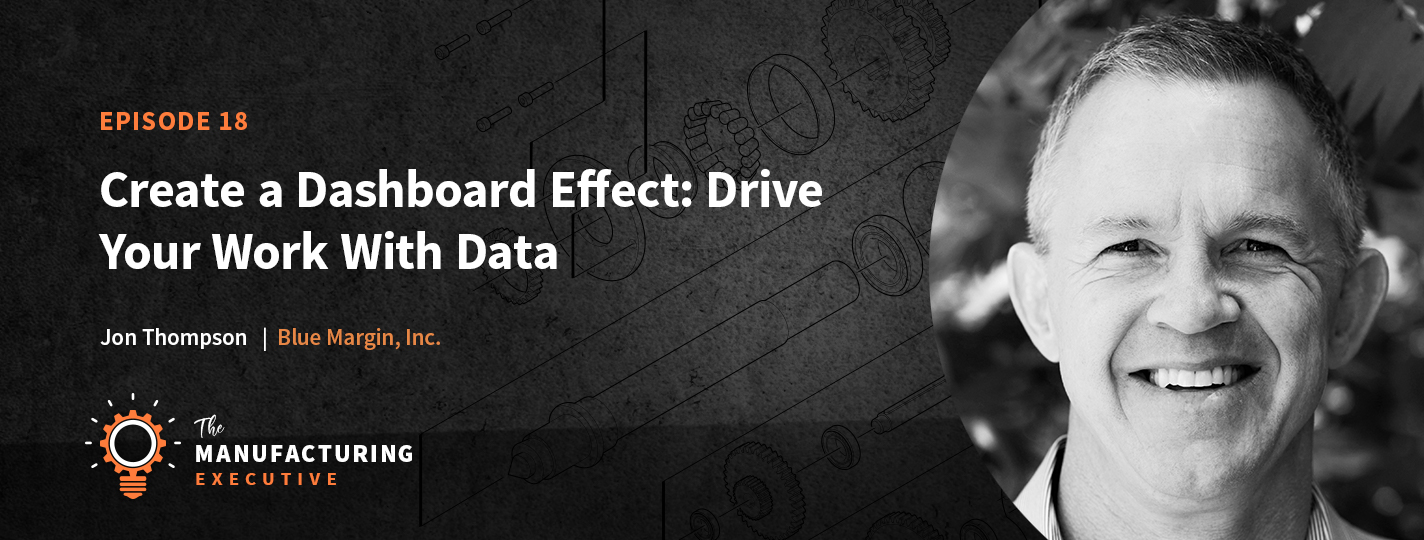

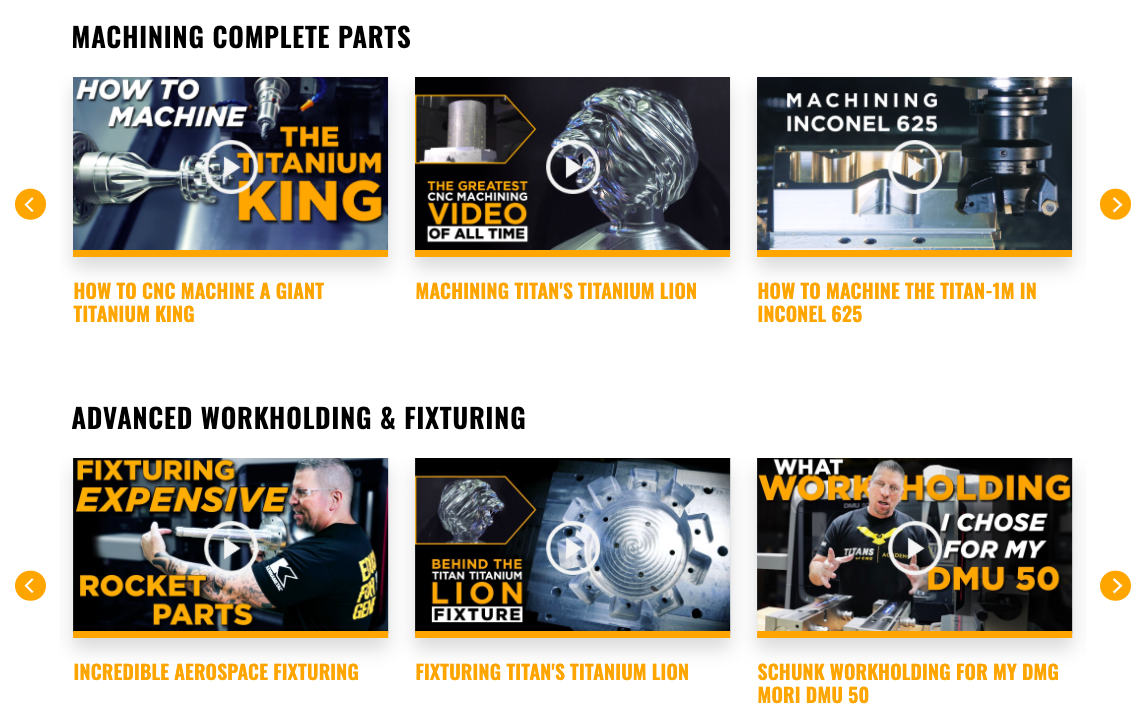
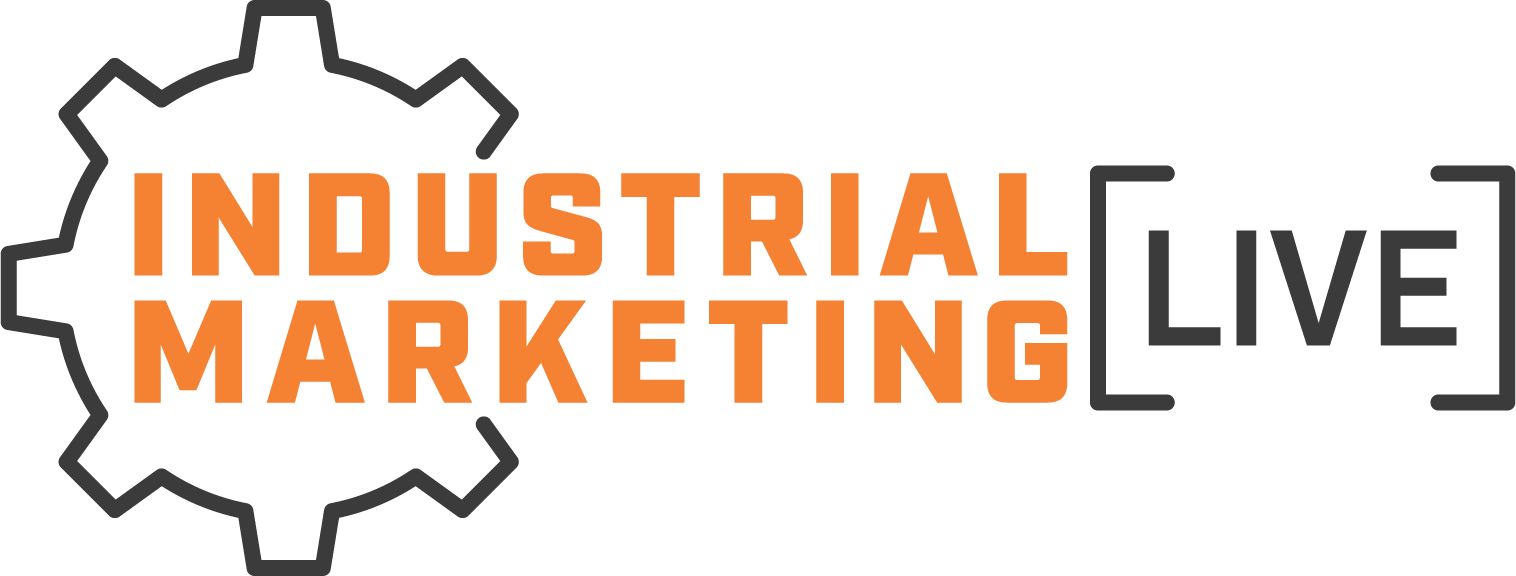
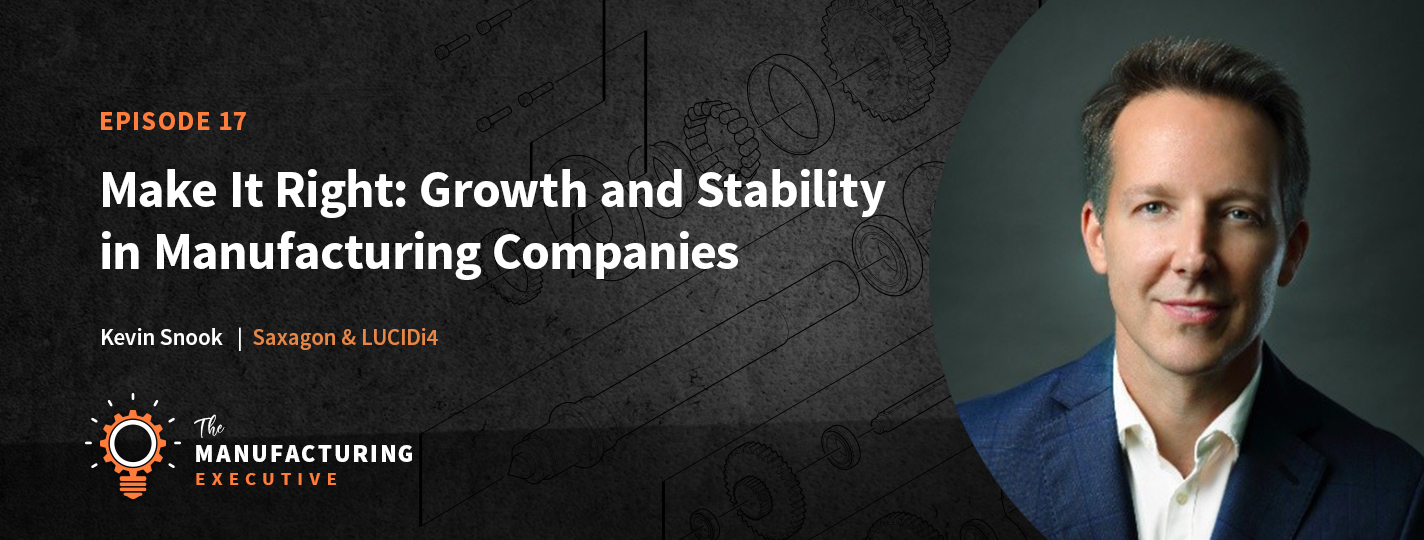
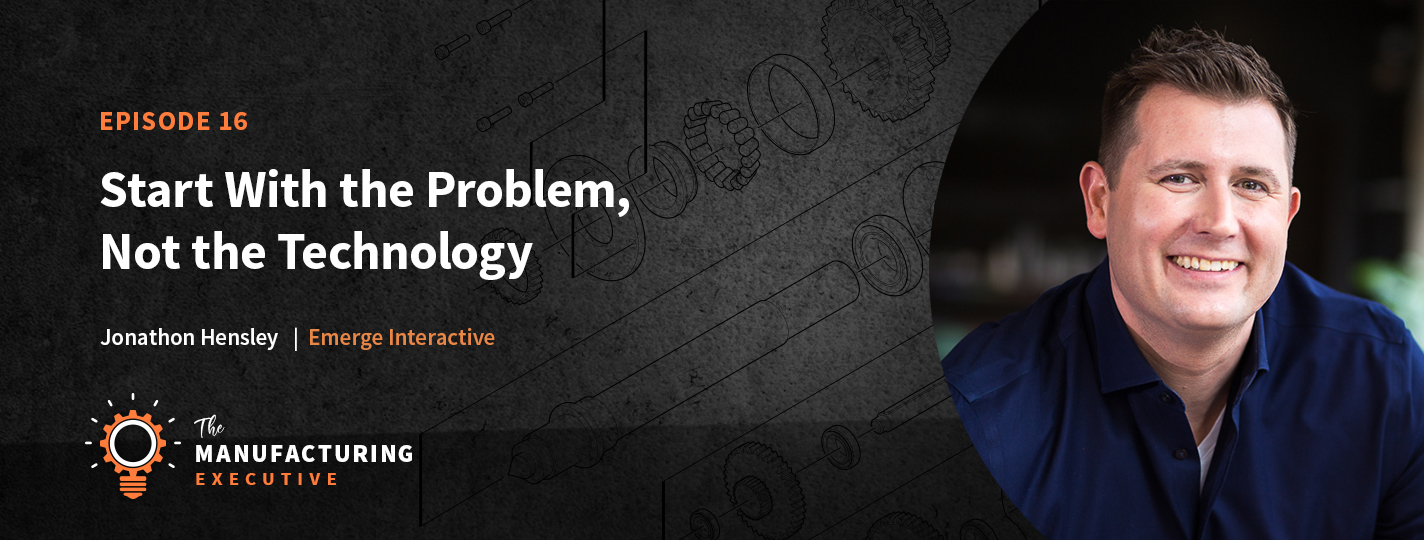
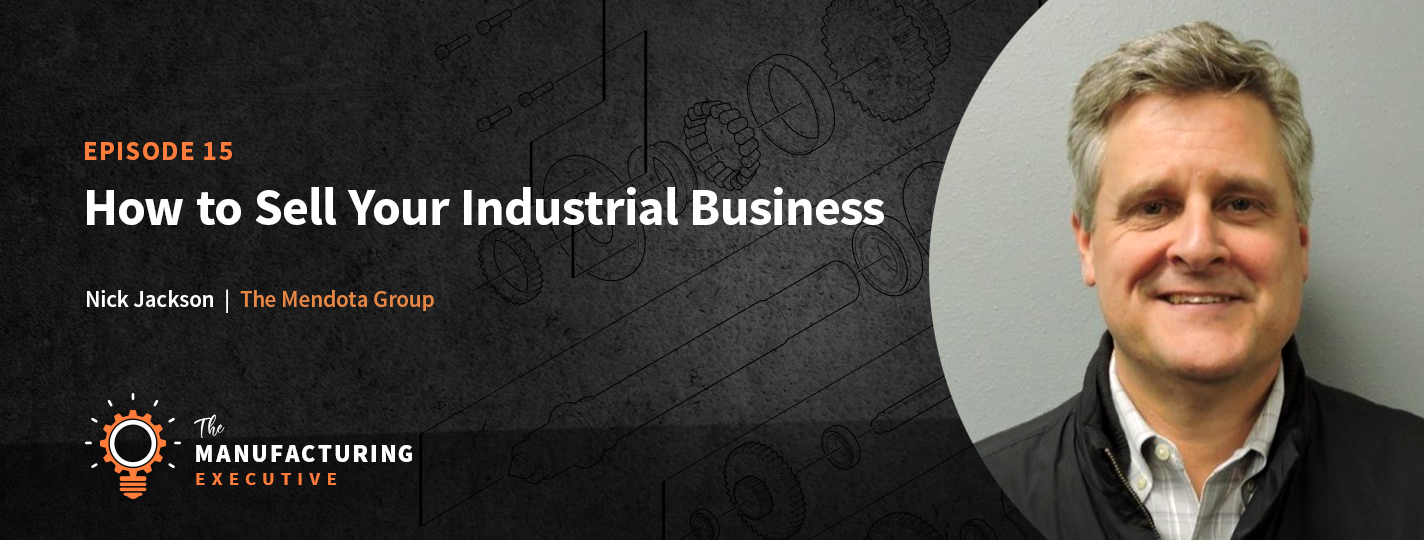
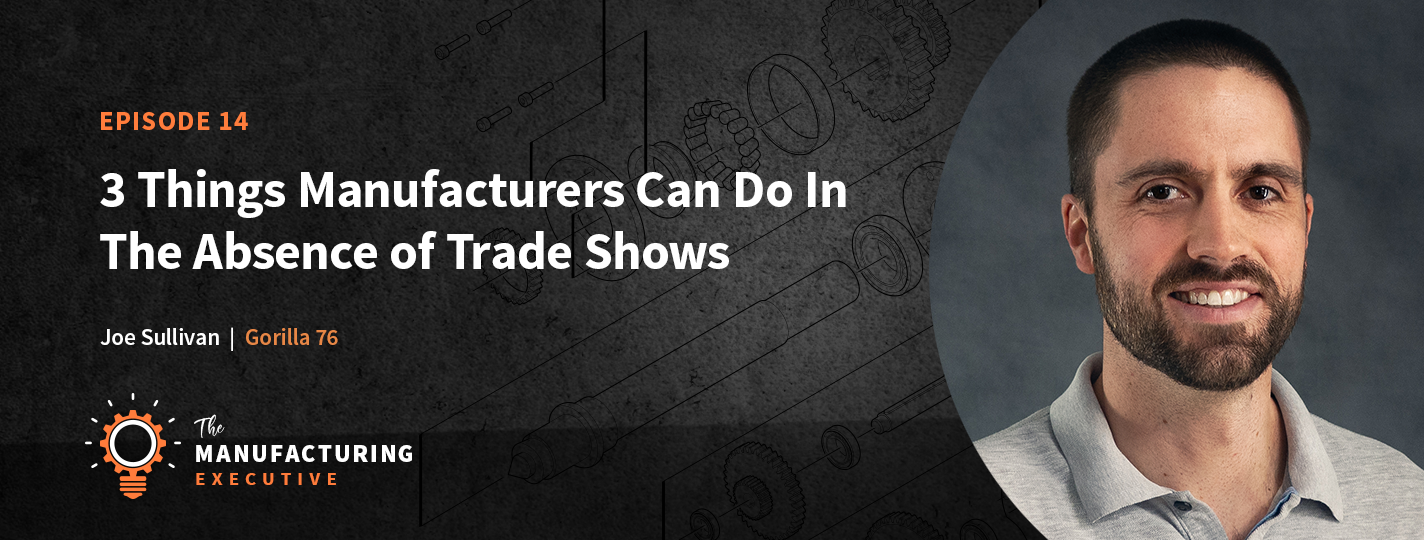
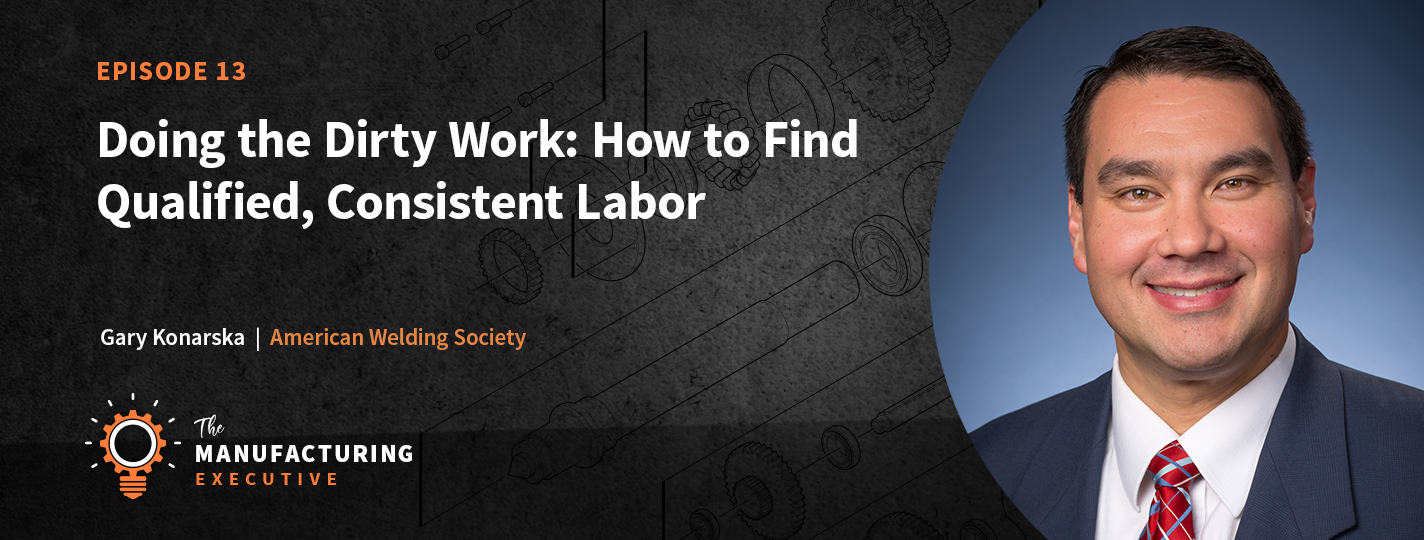

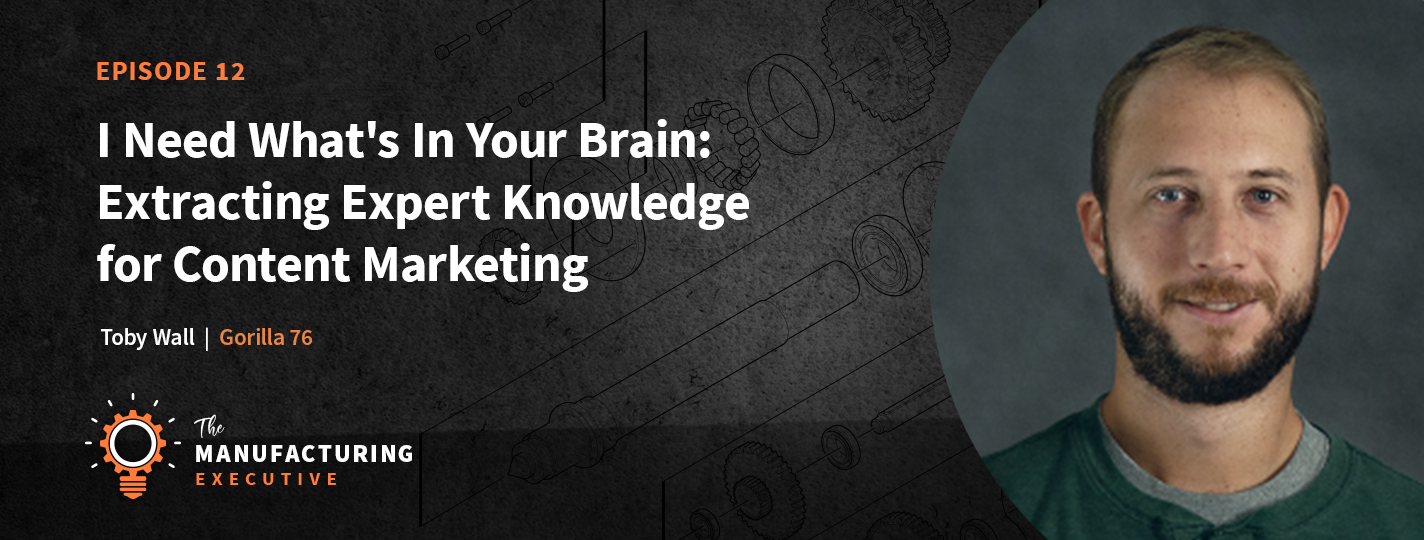


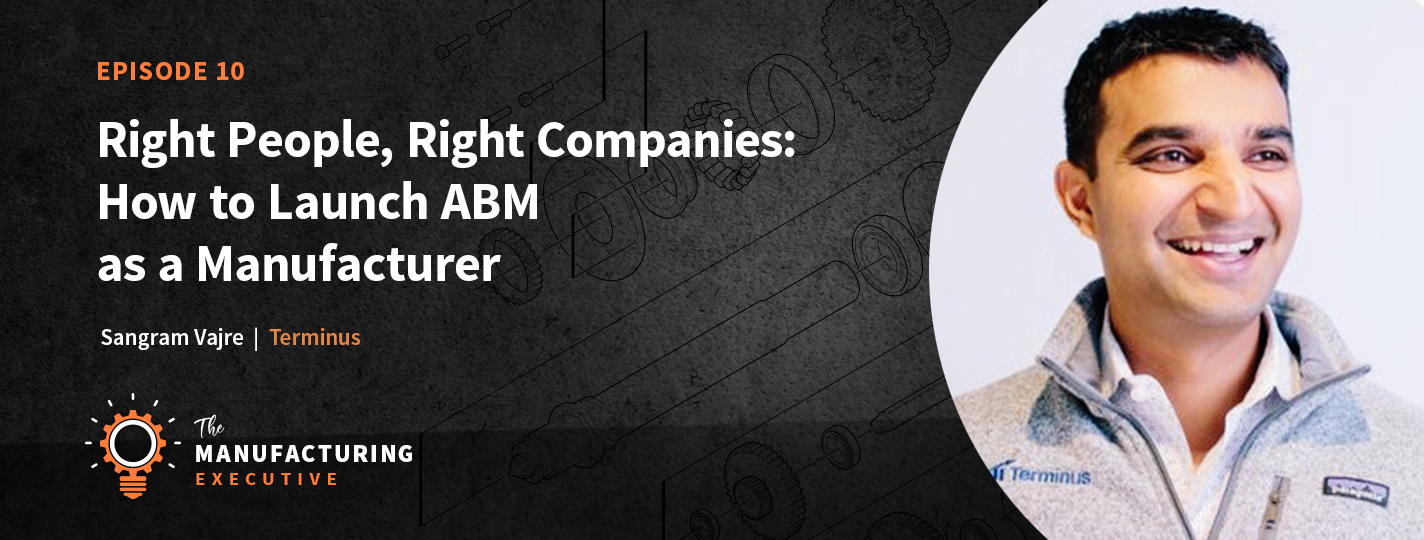
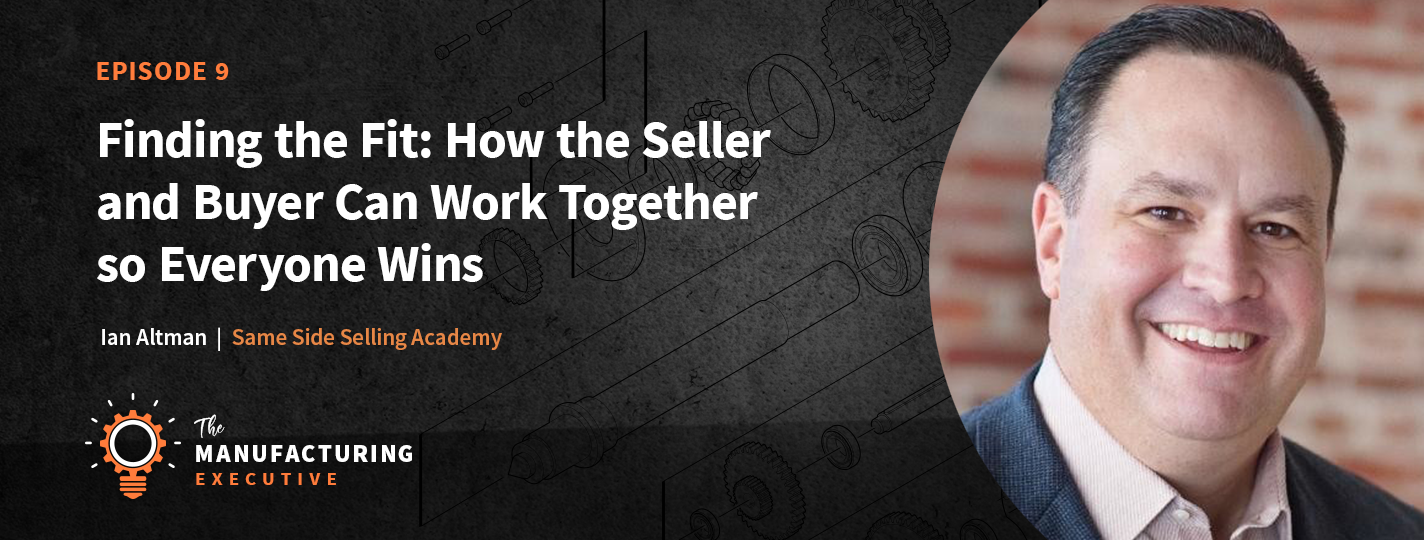


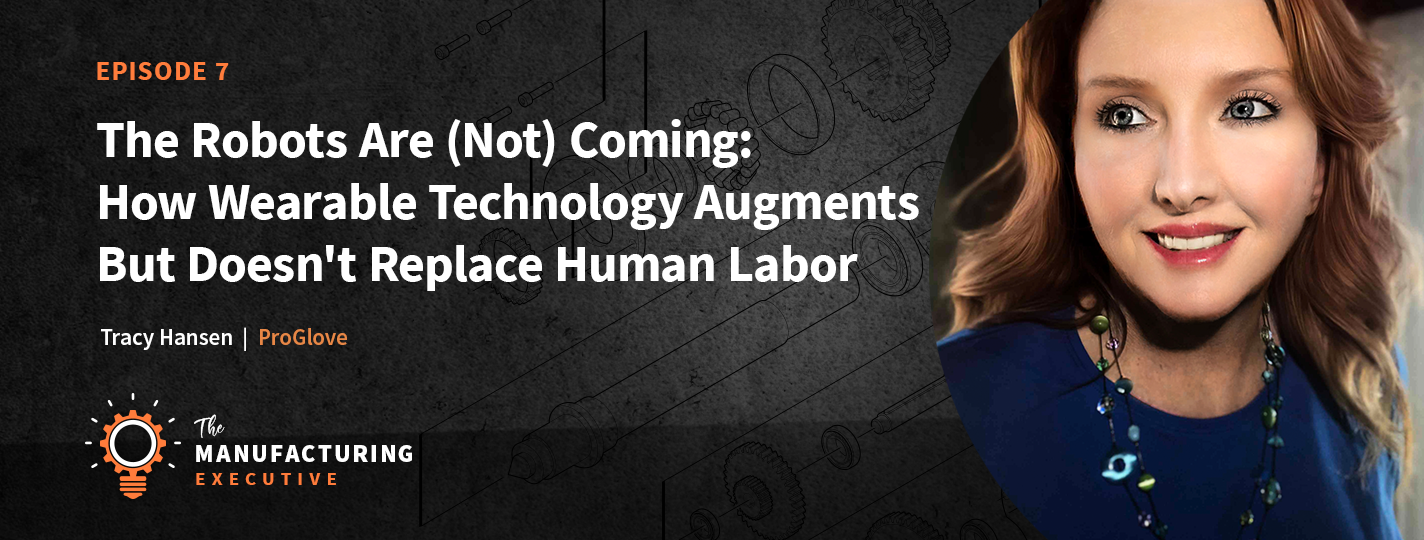
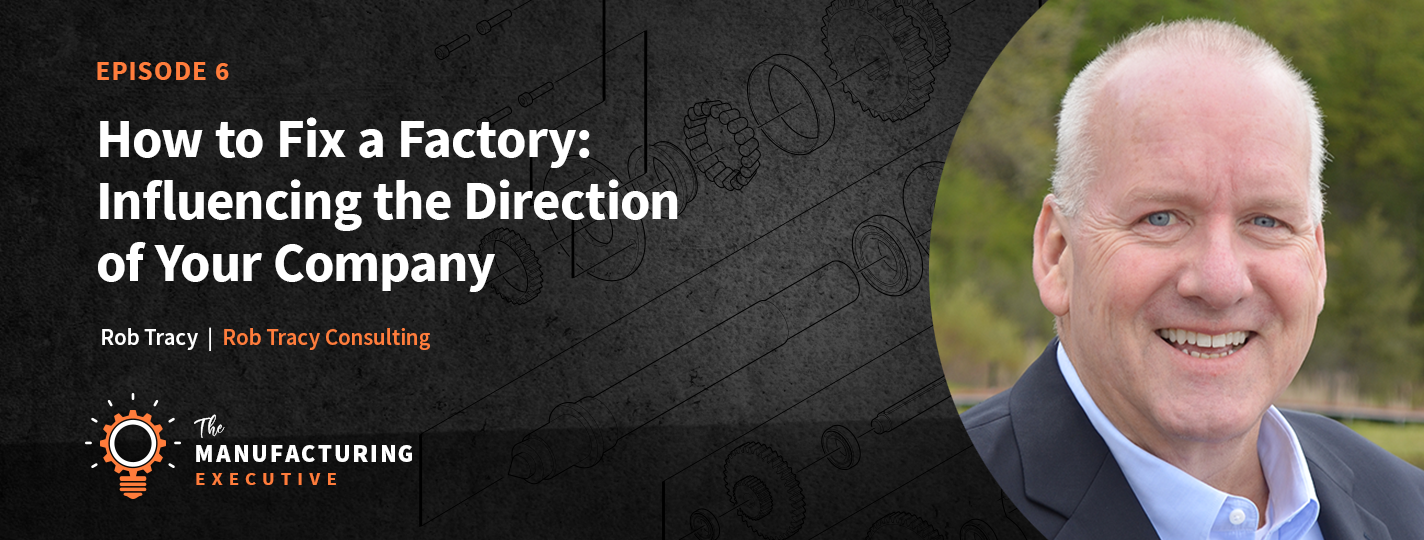

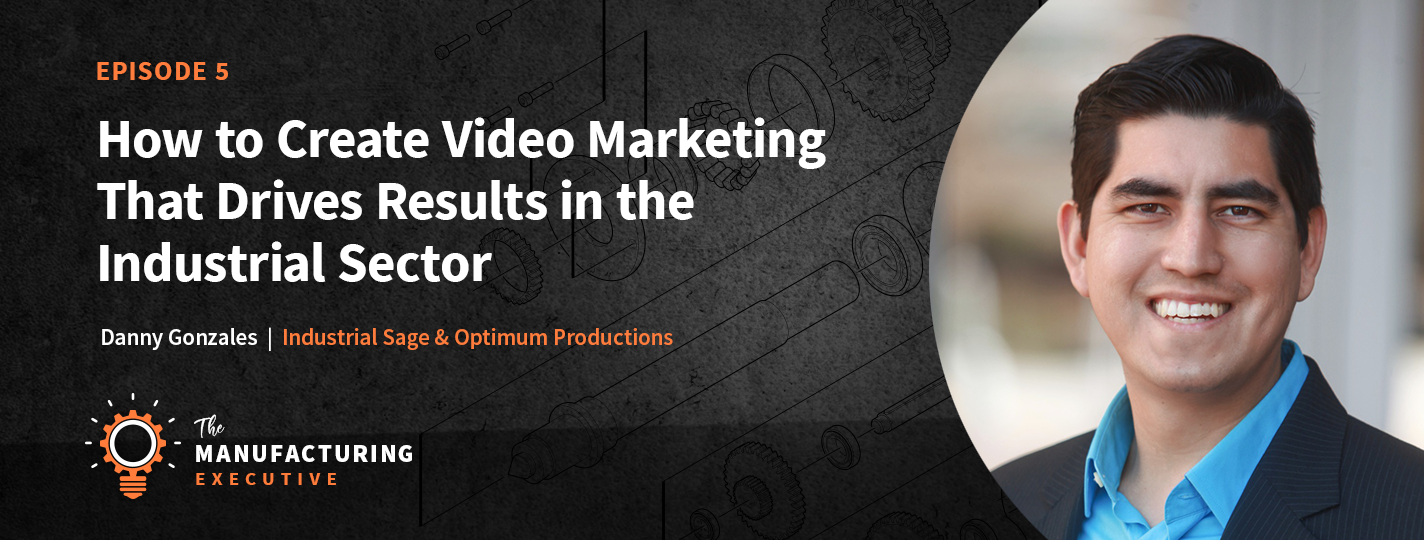

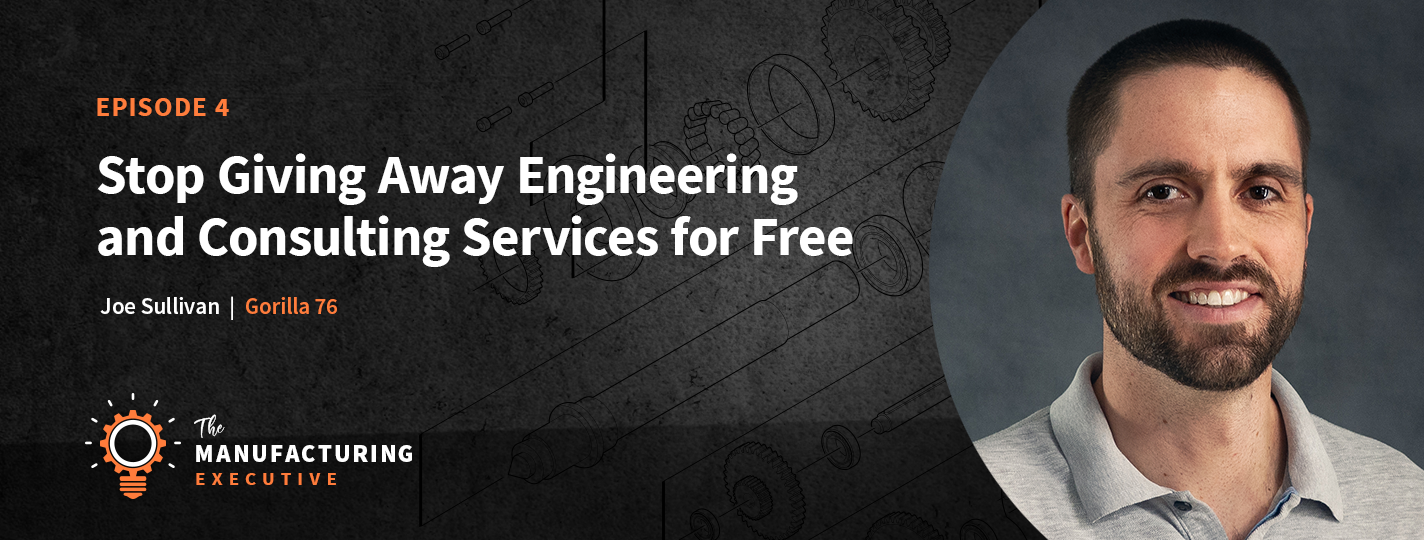

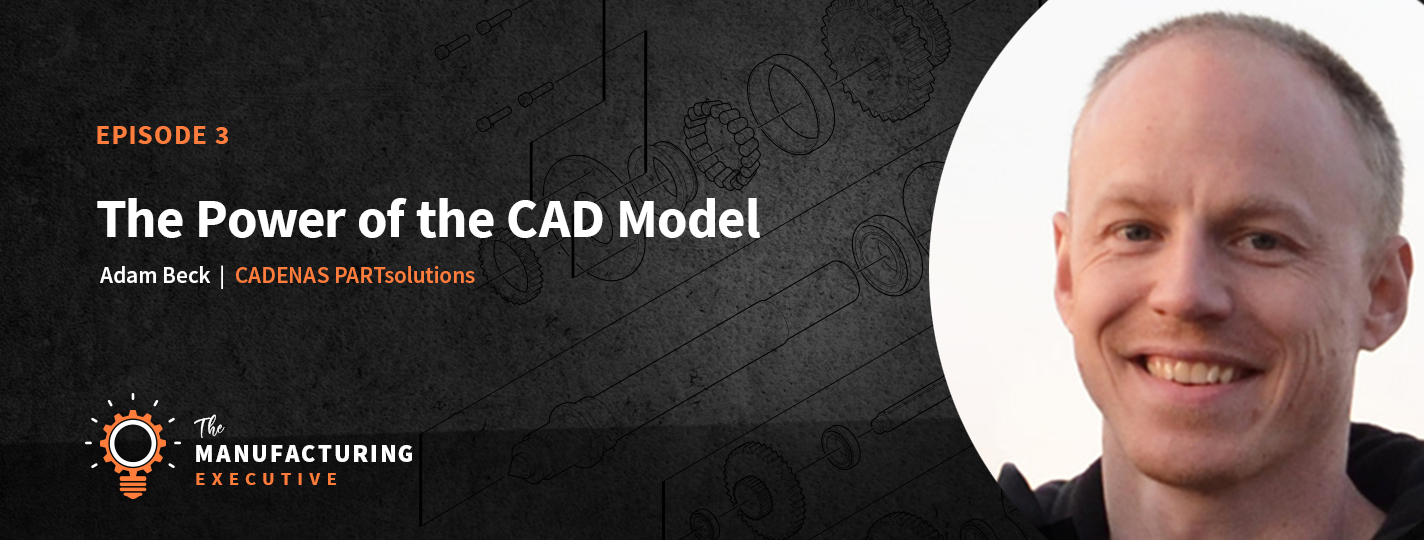
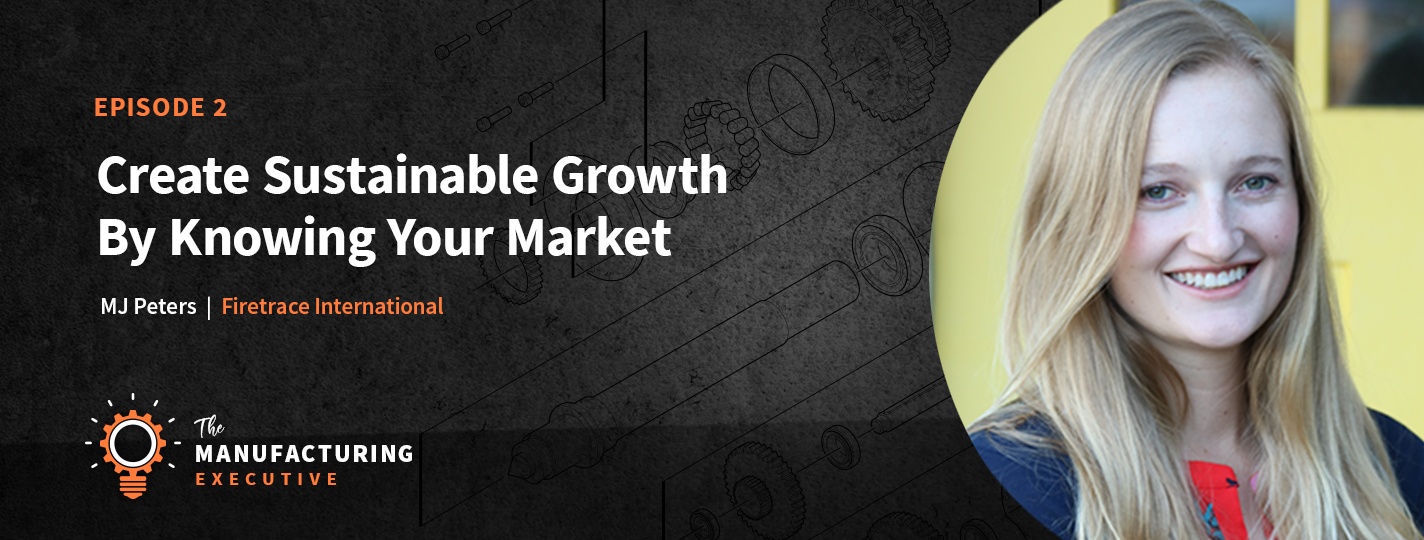
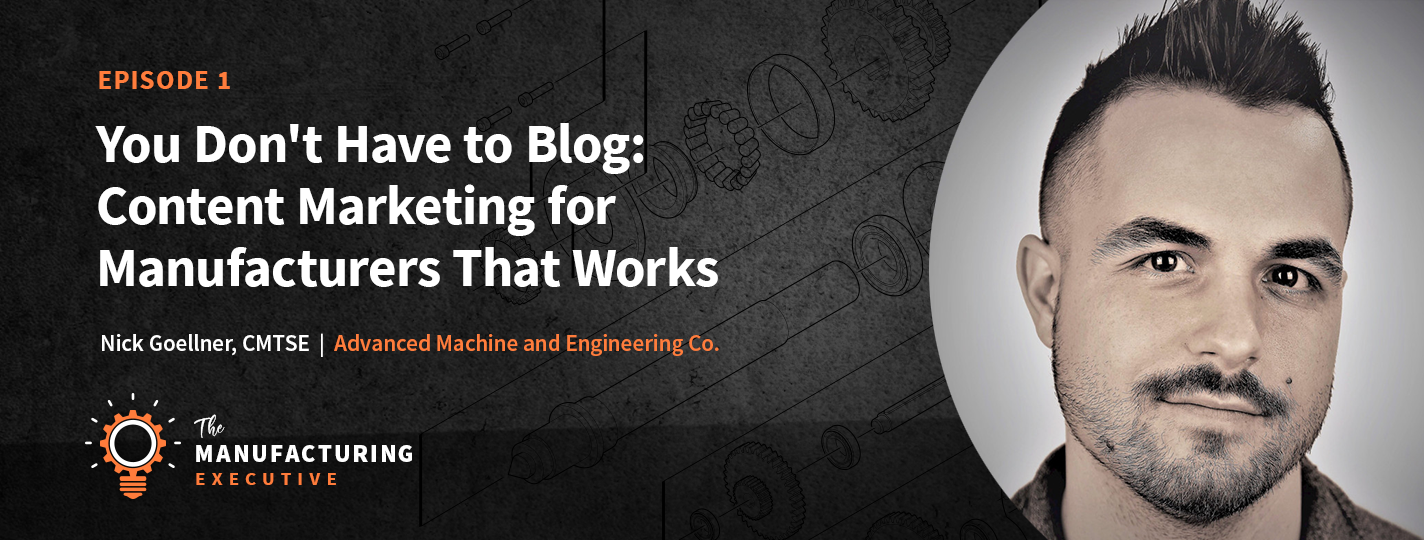

 The author of this article,
The author of this article, 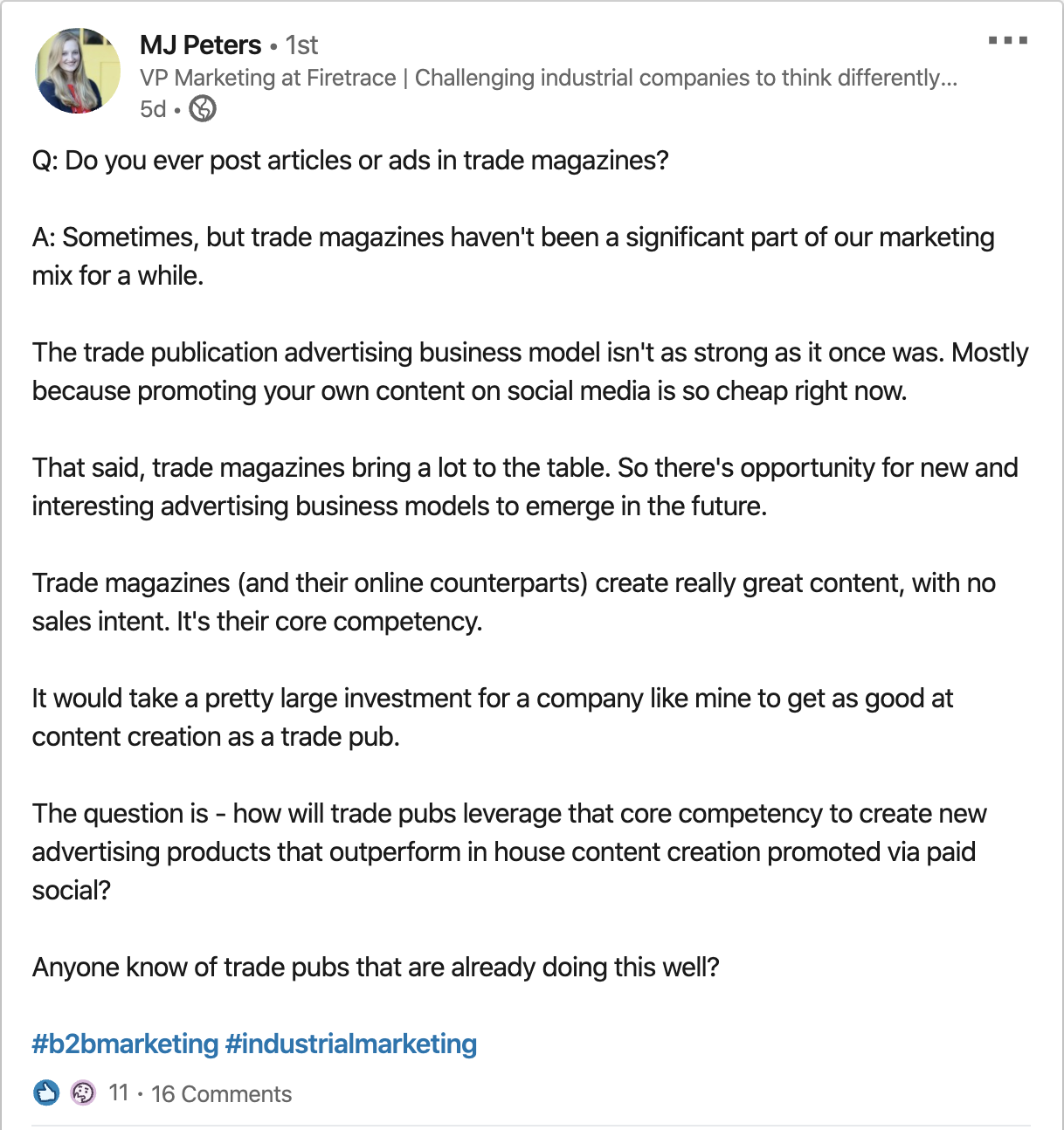

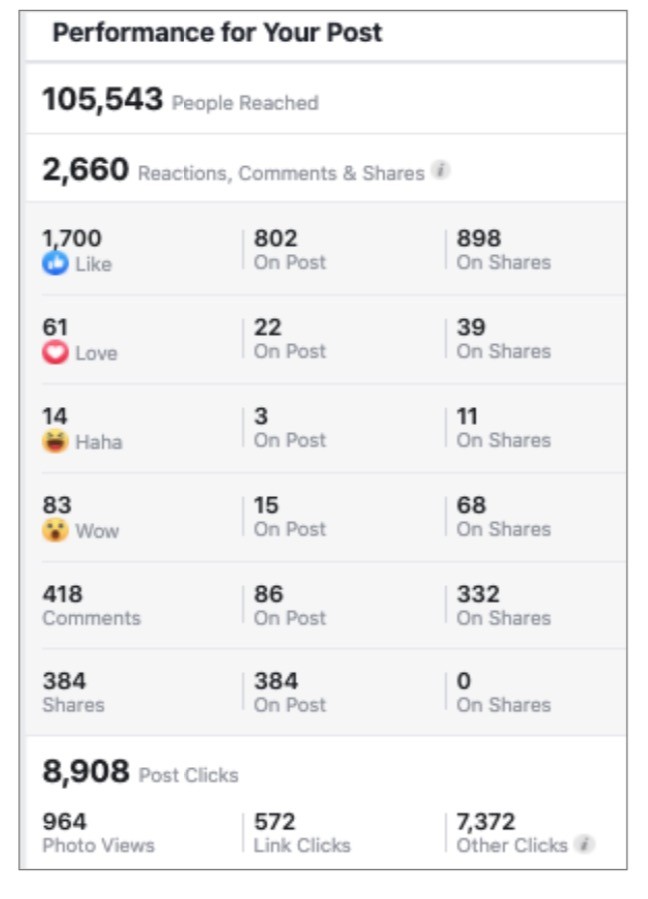


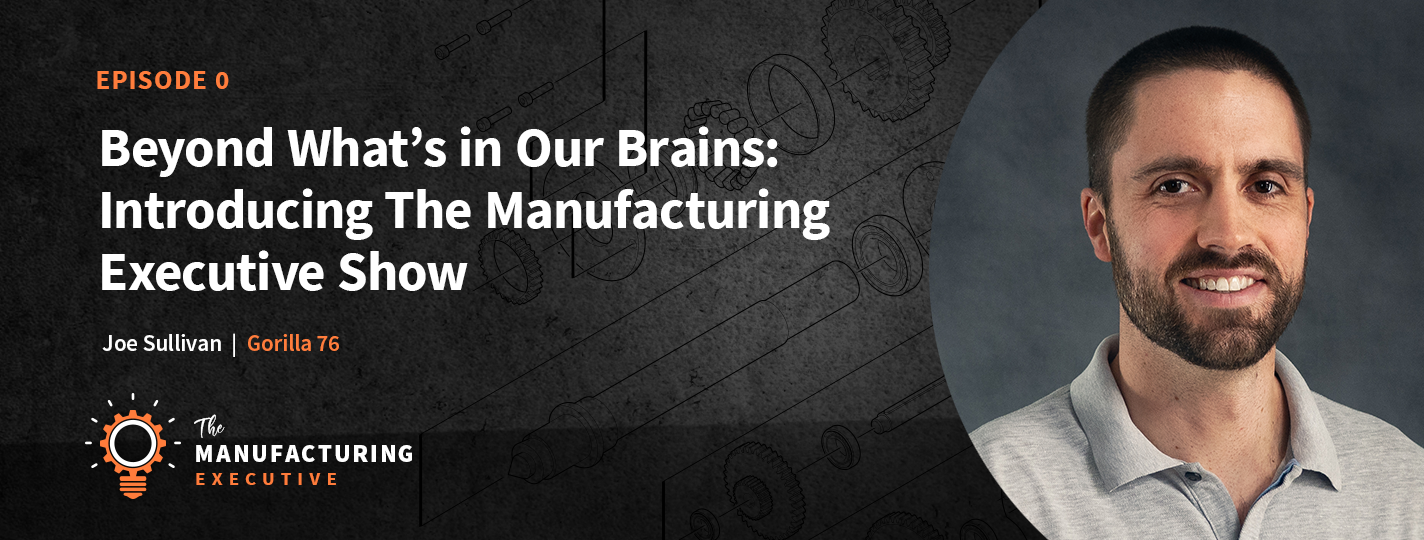




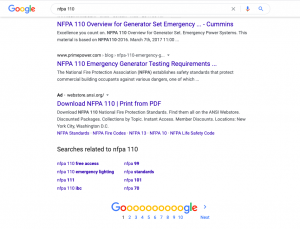
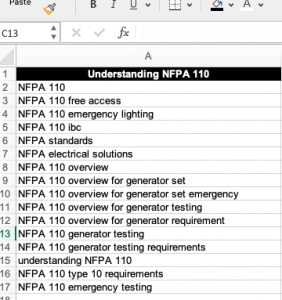
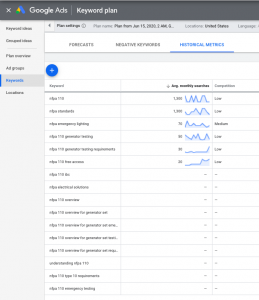
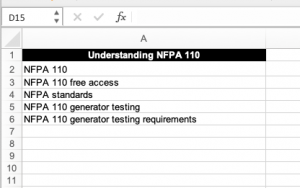
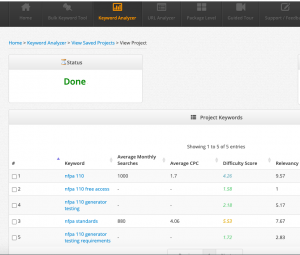
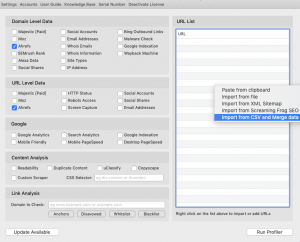

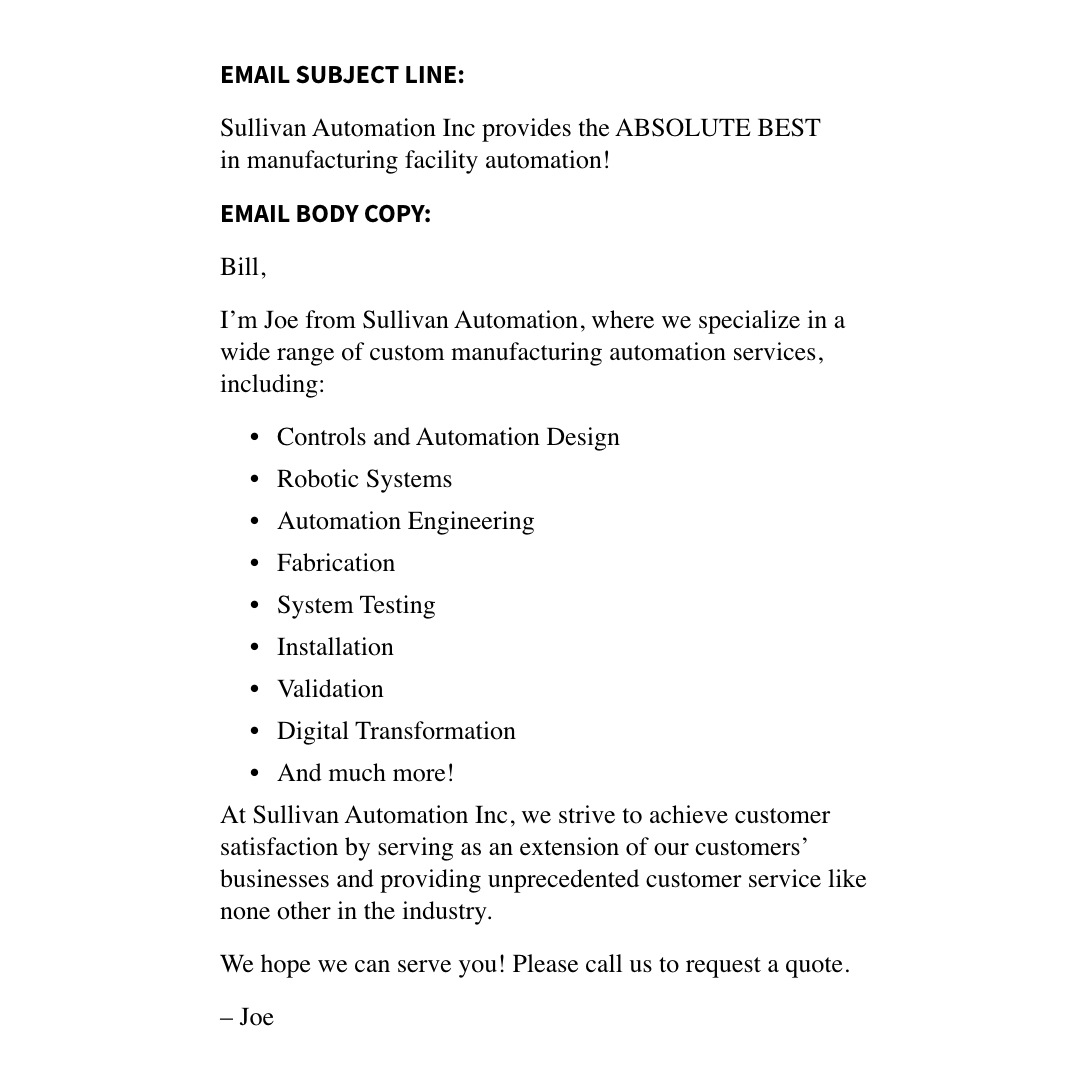
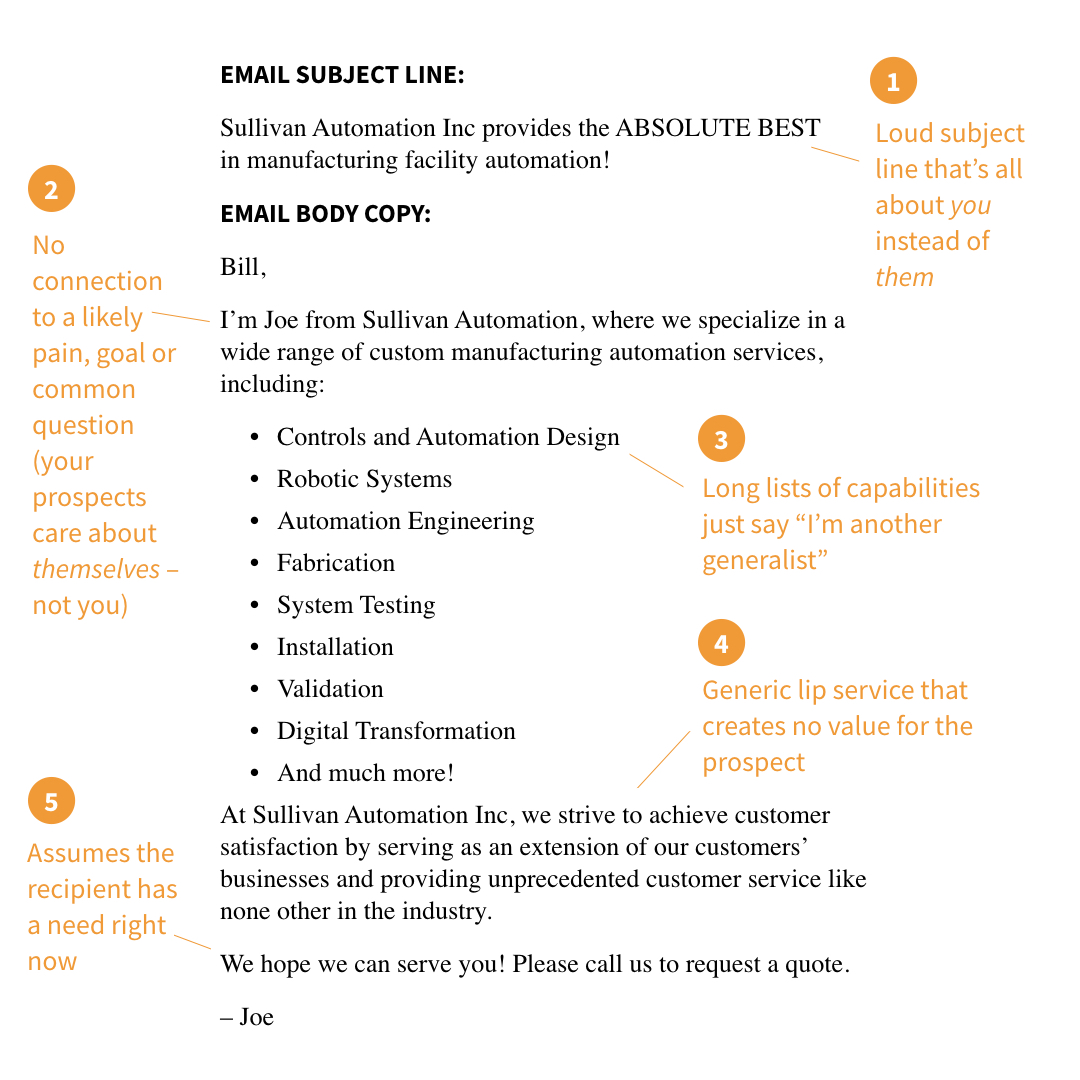
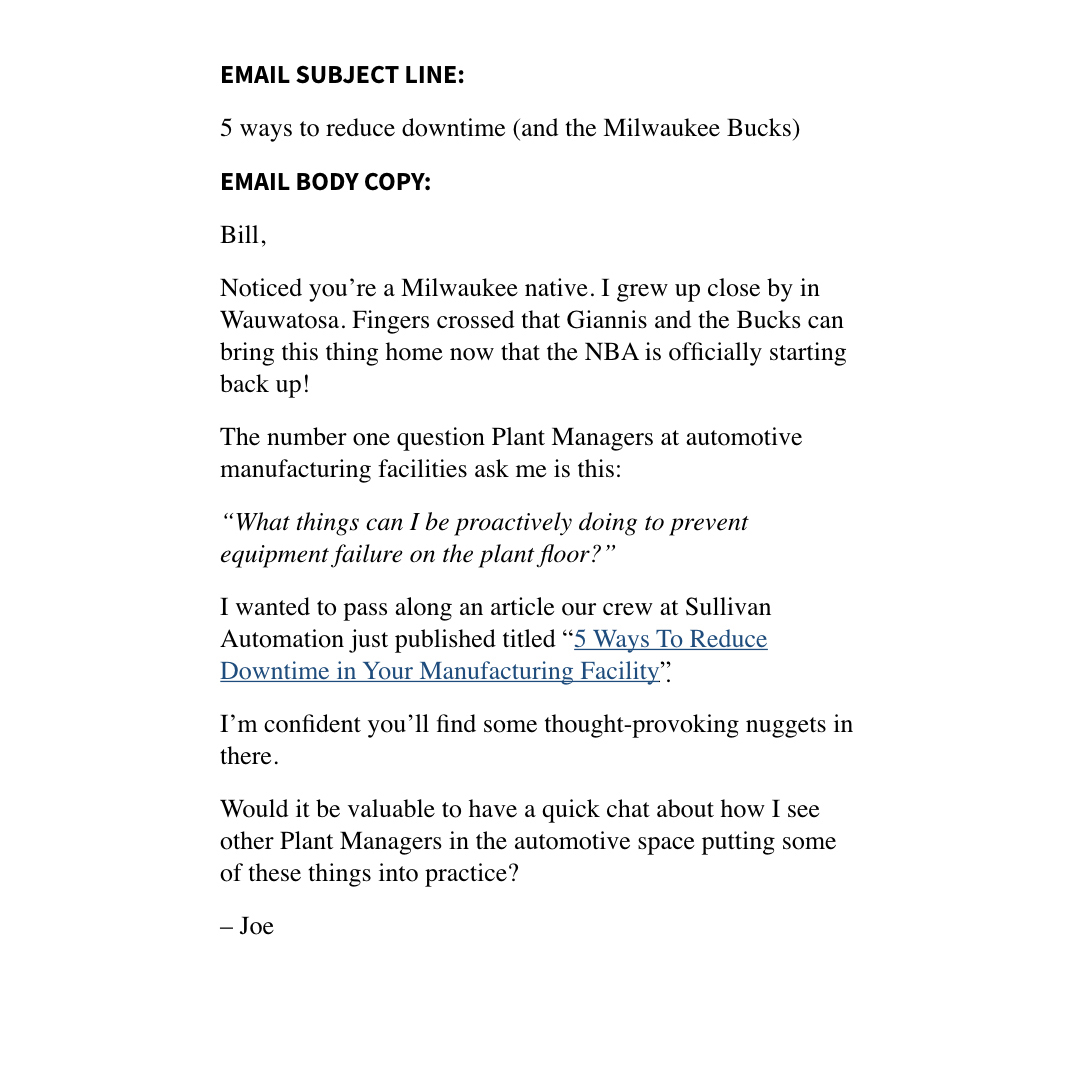
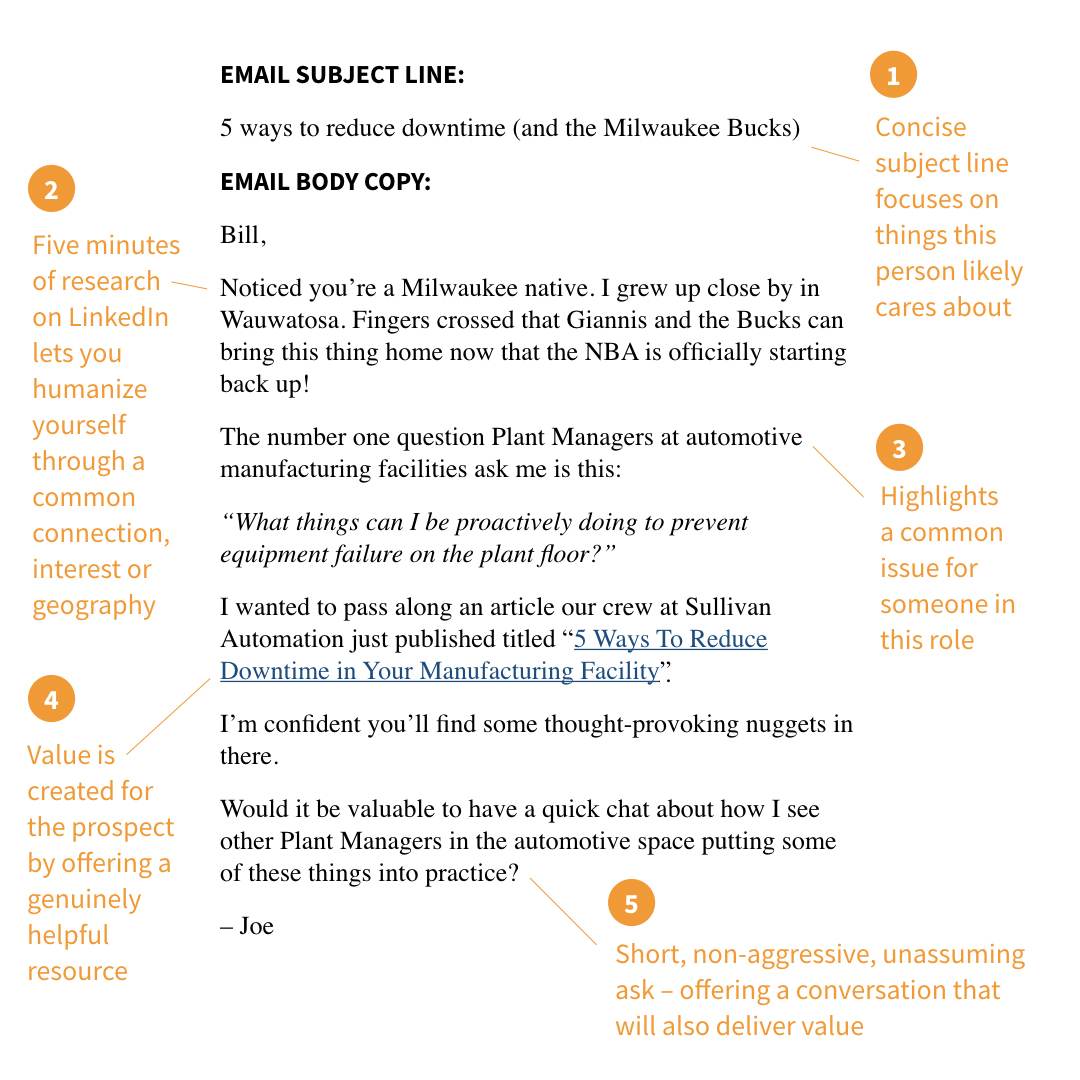

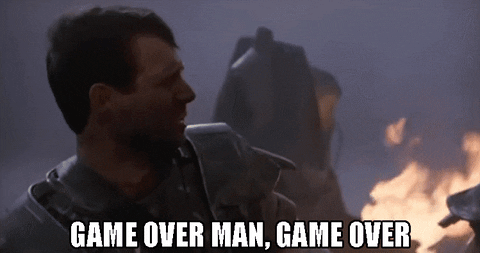
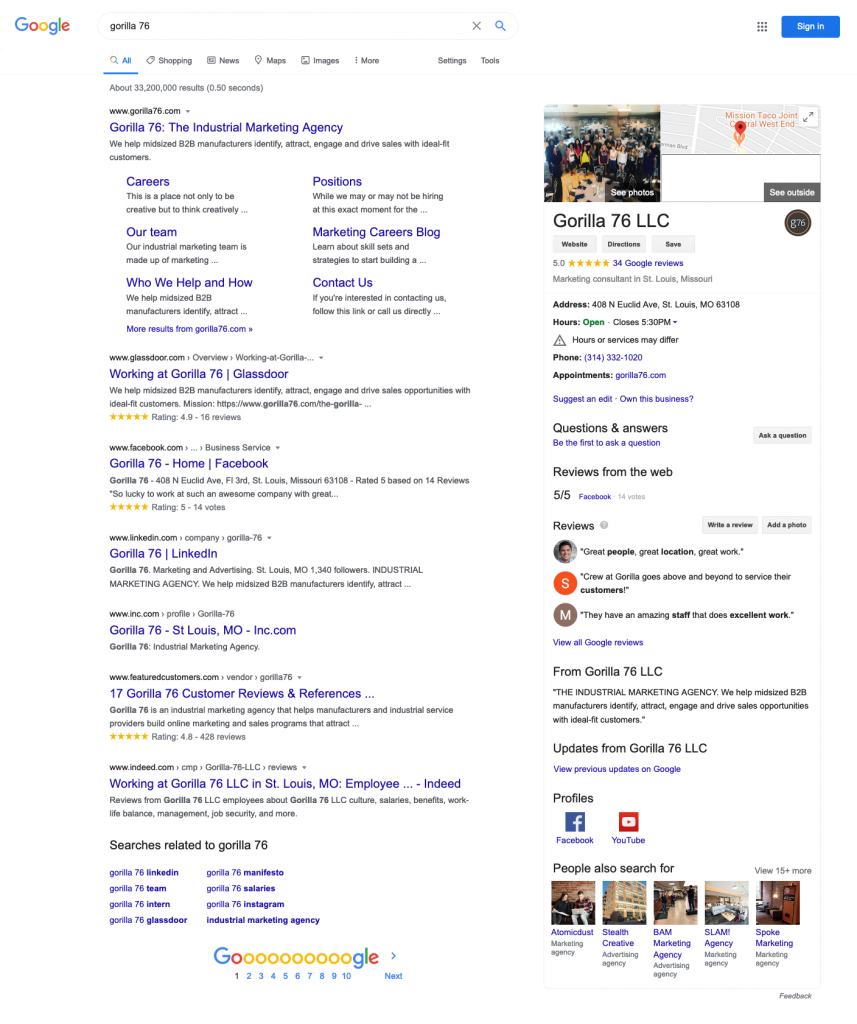


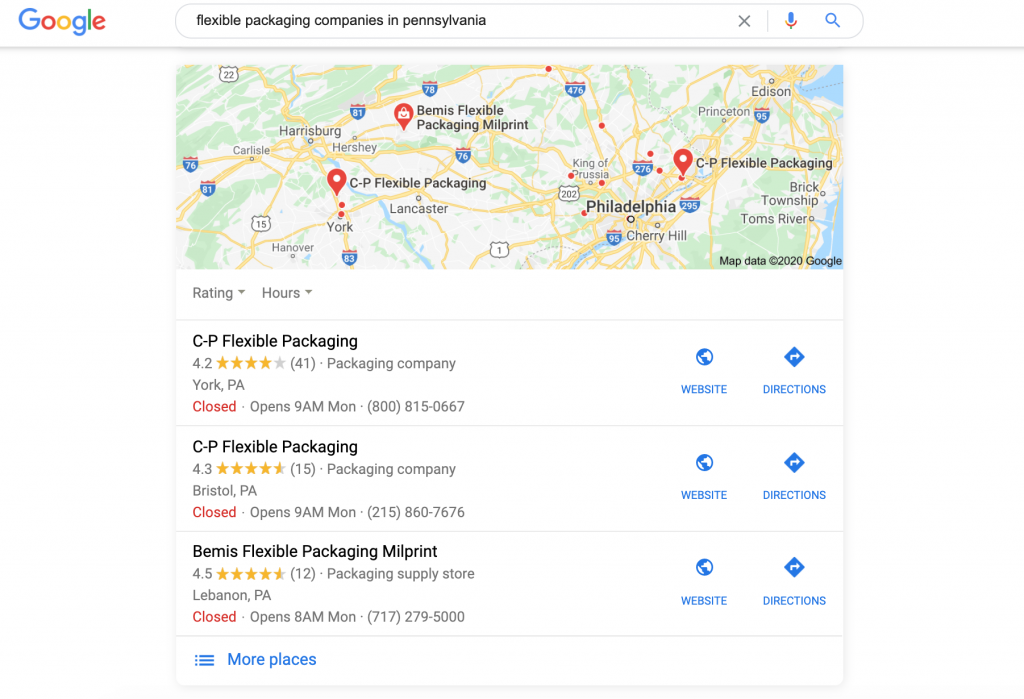
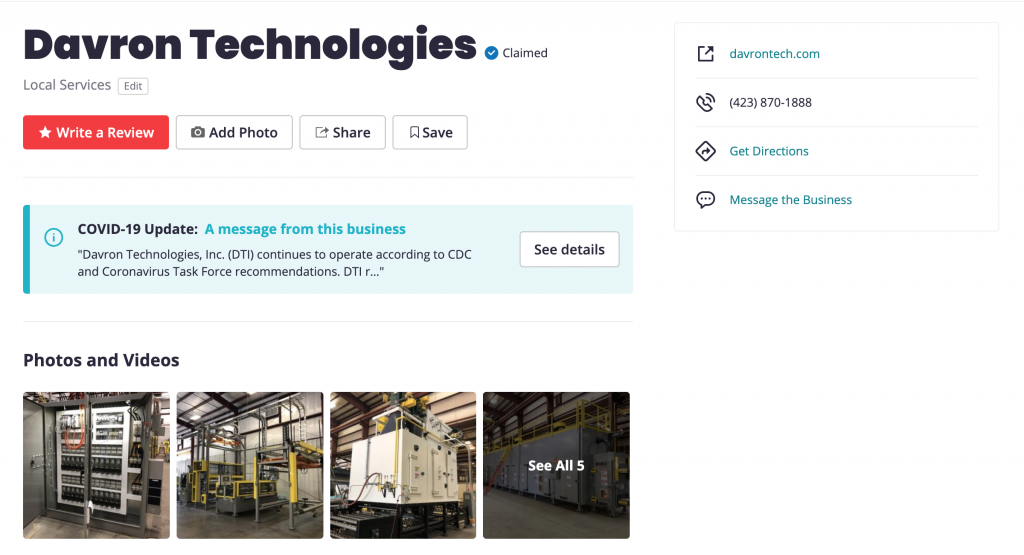


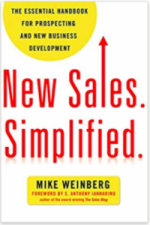
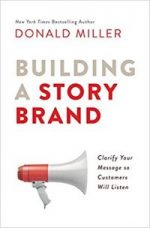

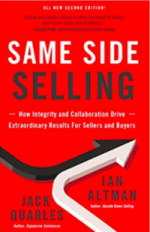
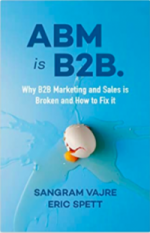
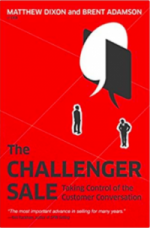

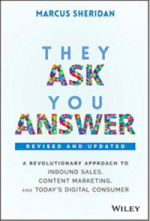
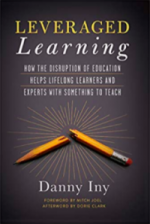
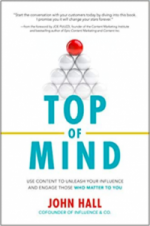
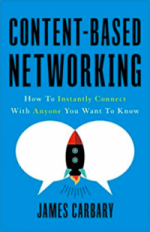
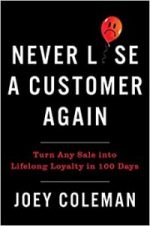


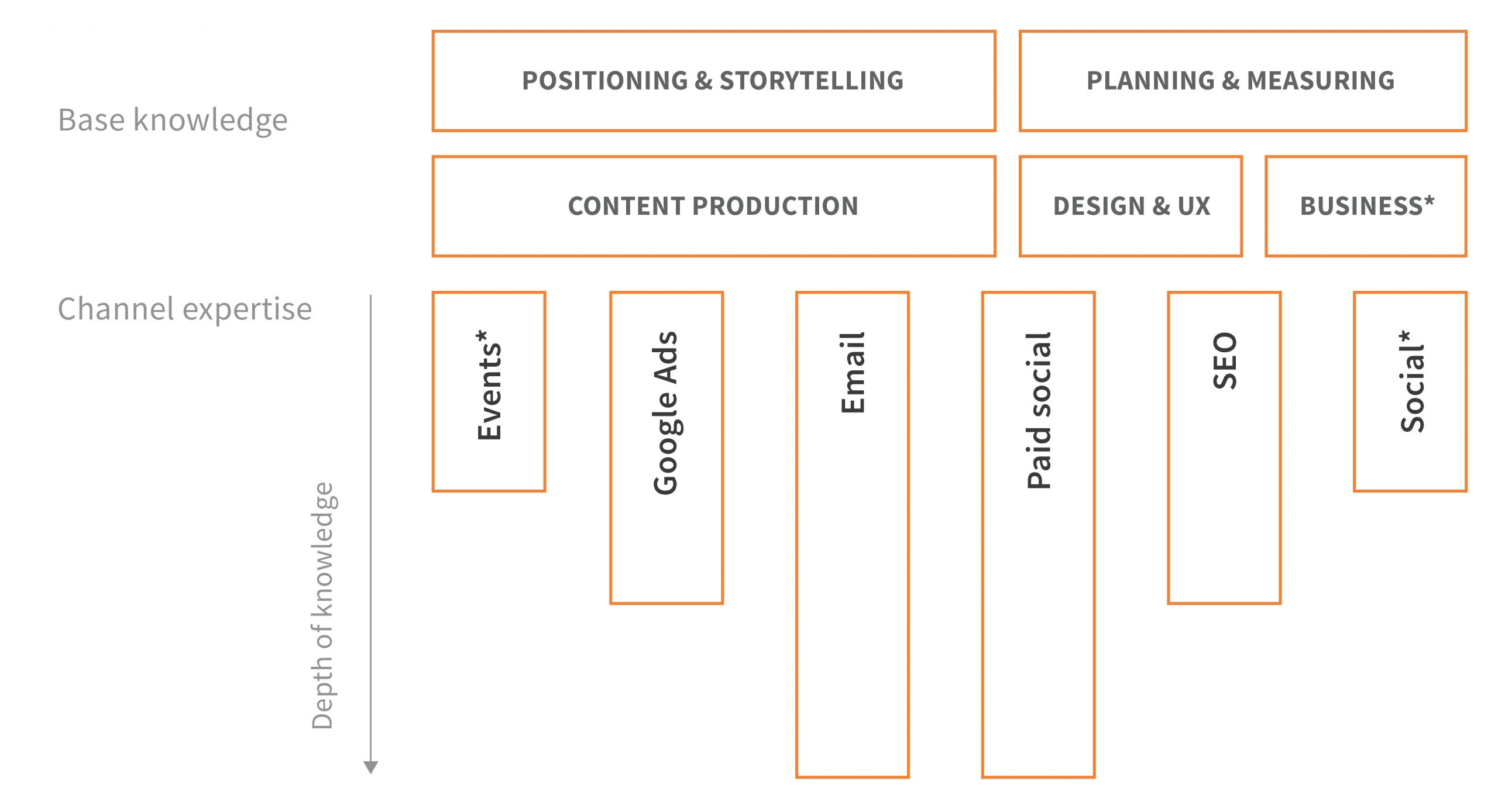
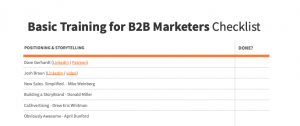




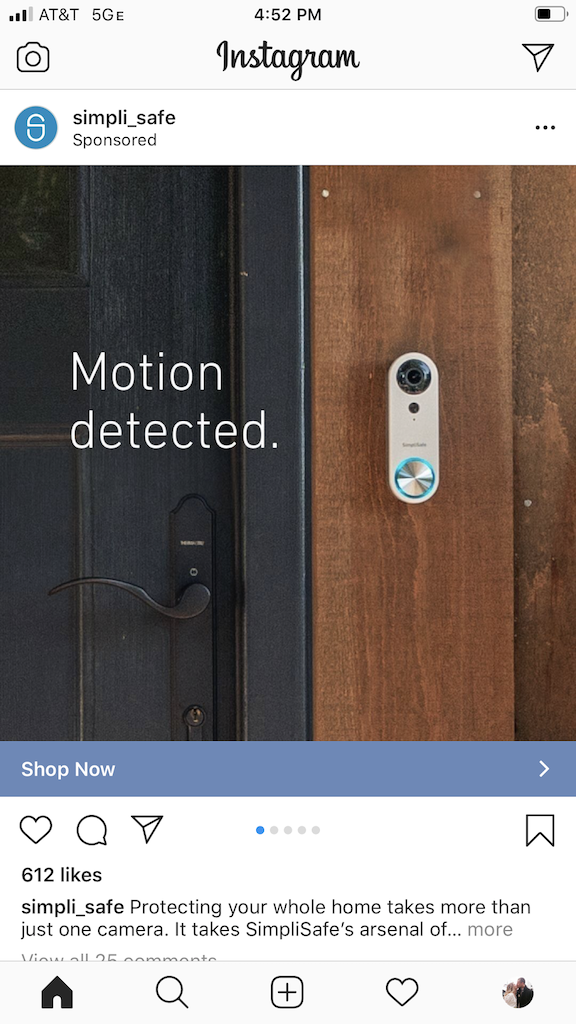
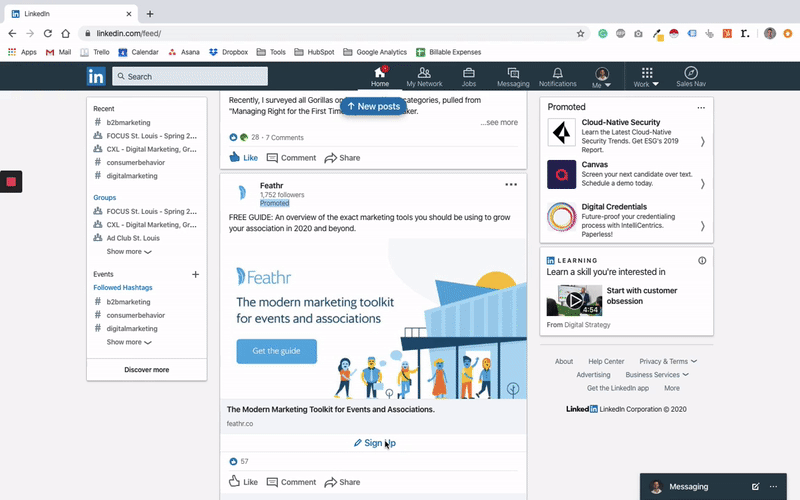
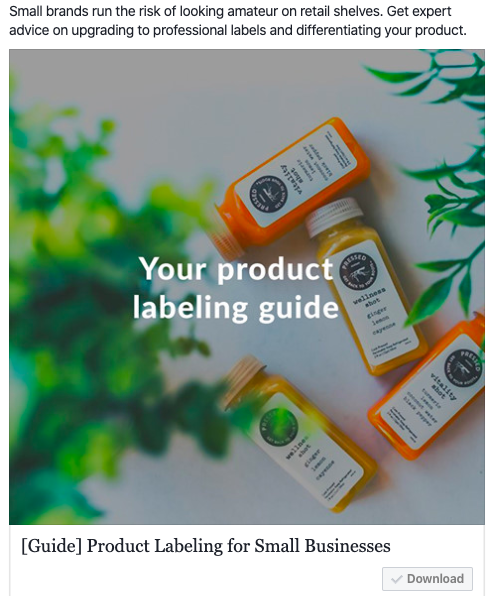
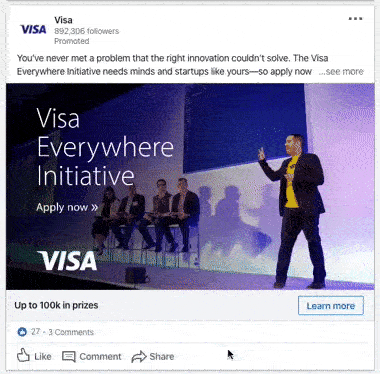




 When asked what makes a successful partnership with Gorilla, one of the first things that come to mind is this:
When asked what makes a successful partnership with Gorilla, one of the first things that come to mind is this: 













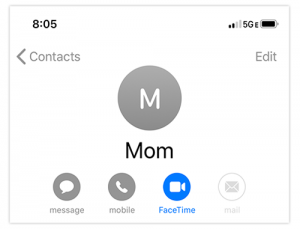 But thanks to Steve Jobs and team, their Grandma doesn’t seem so far away.
But thanks to Steve Jobs and team, their Grandma doesn’t seem so far away.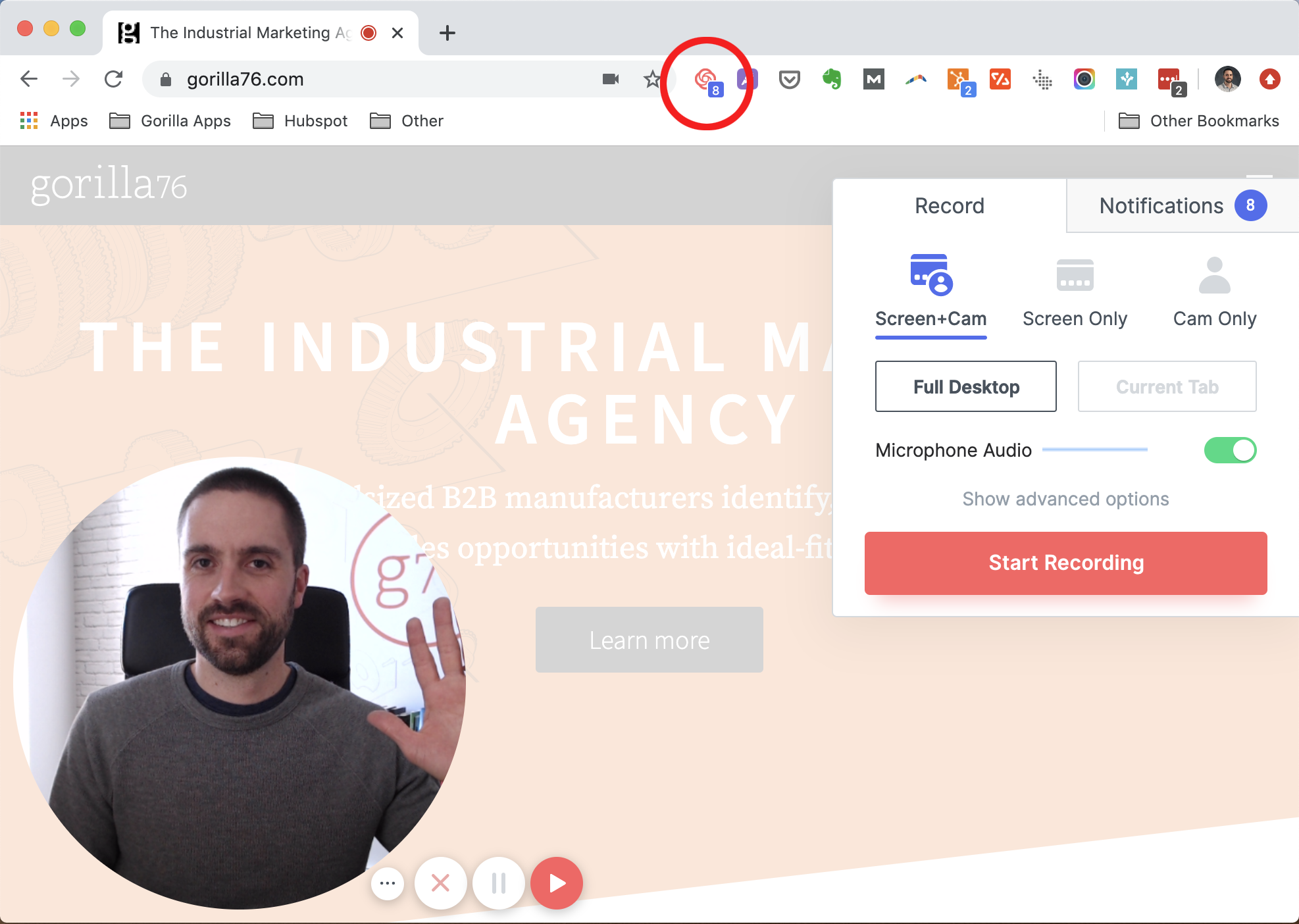
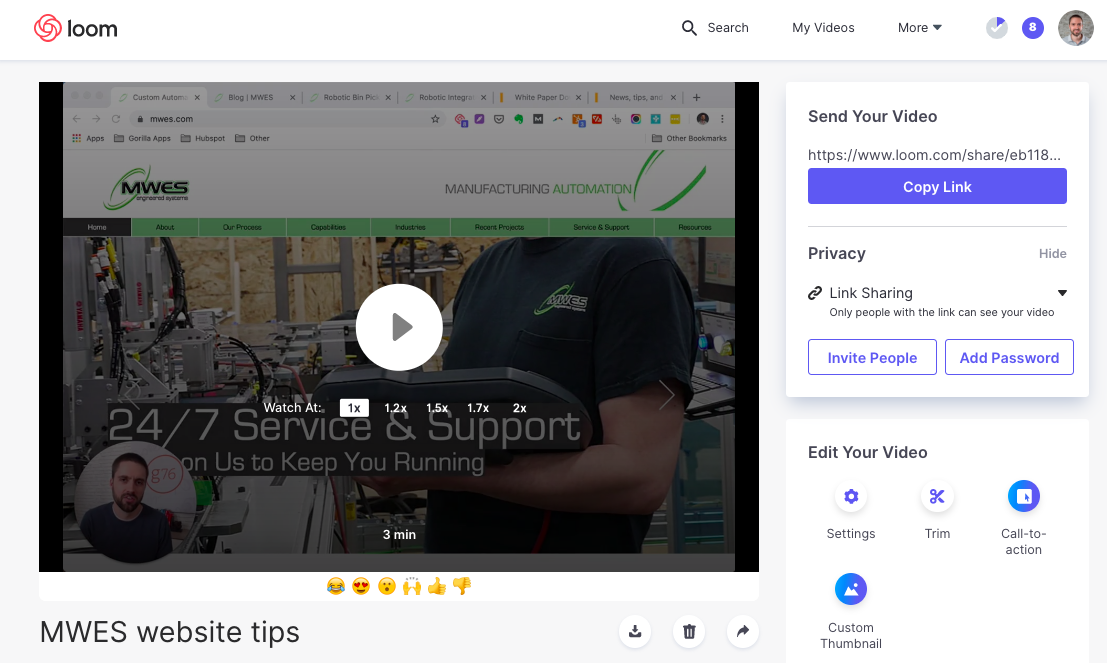
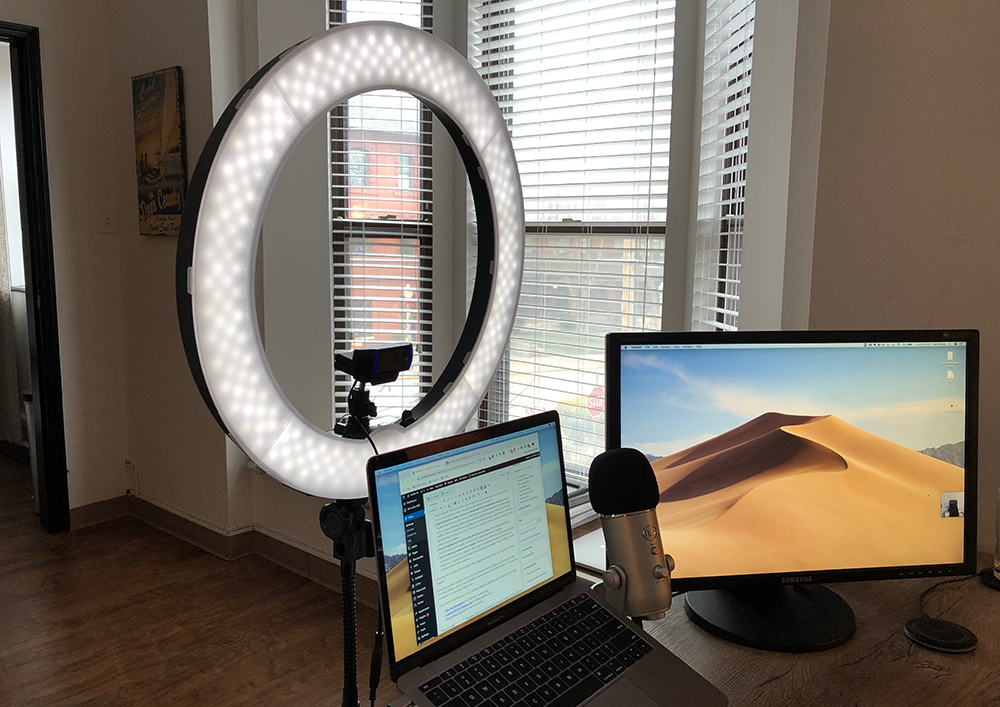








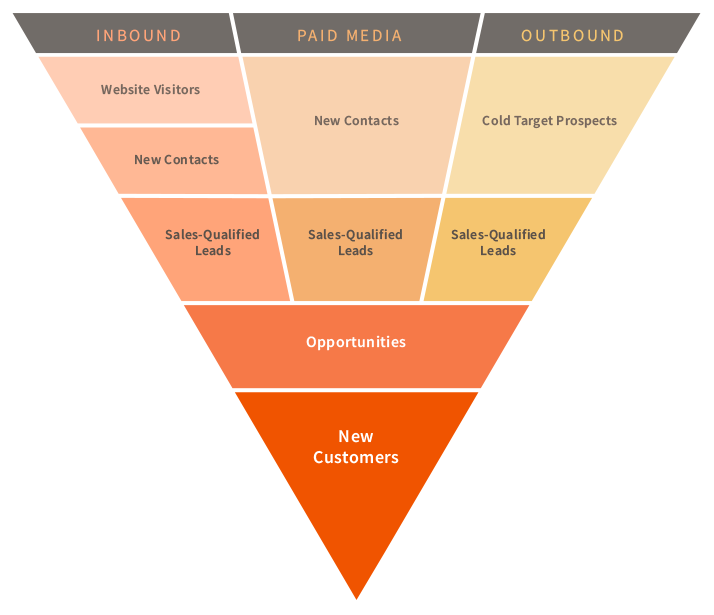

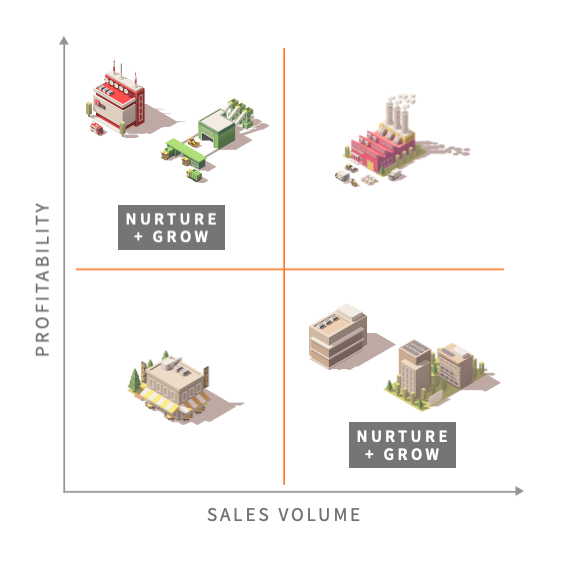
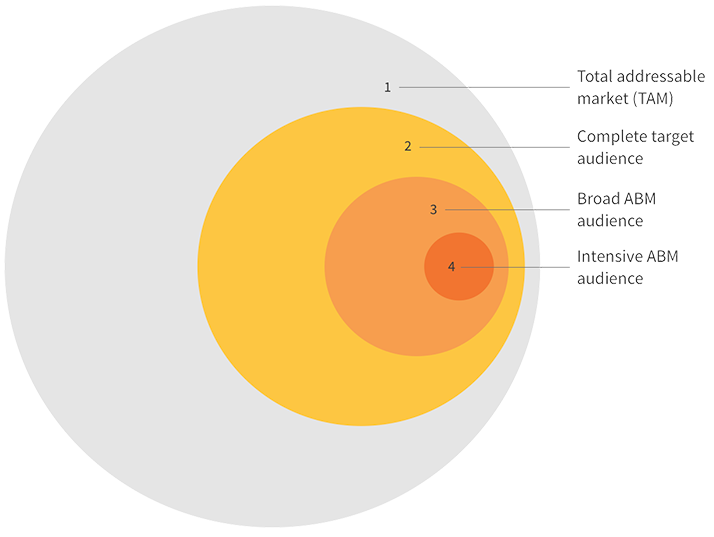

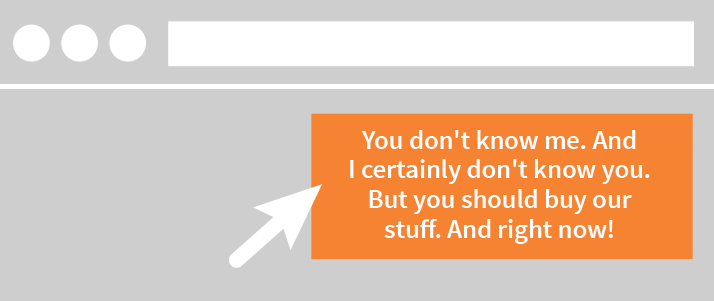
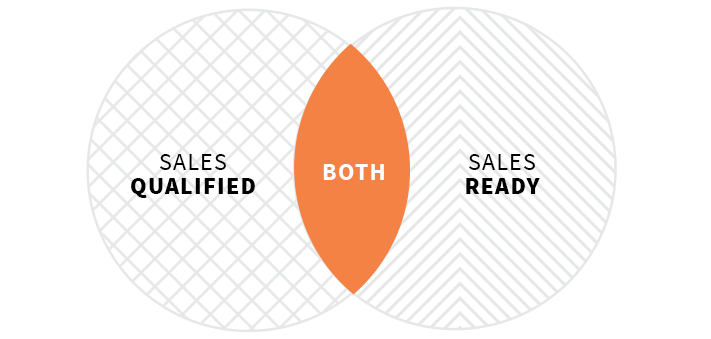

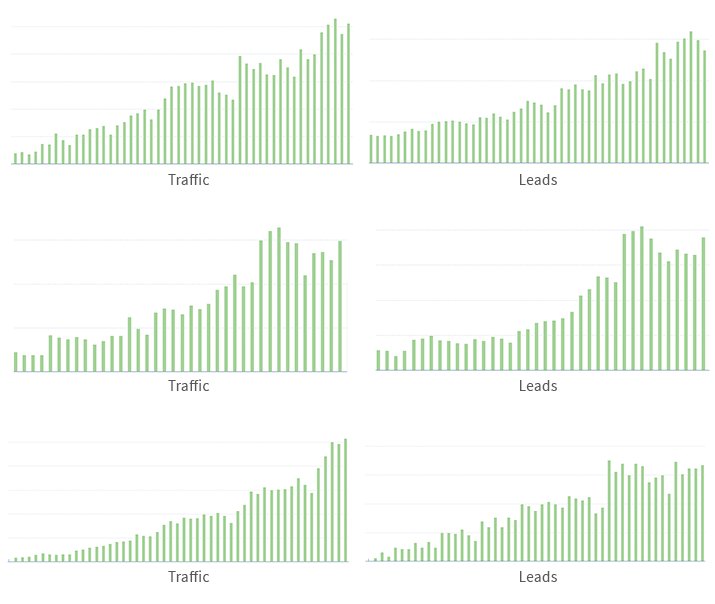
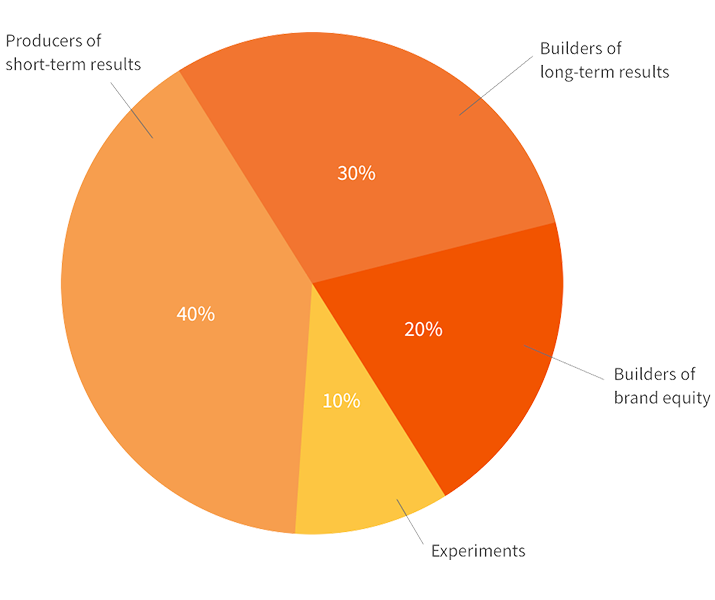

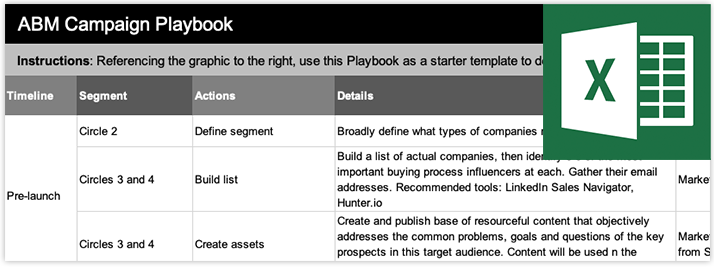


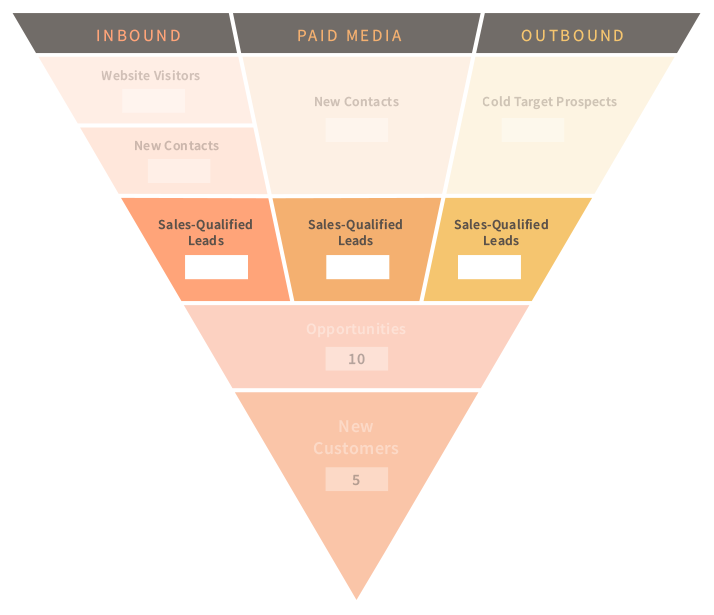
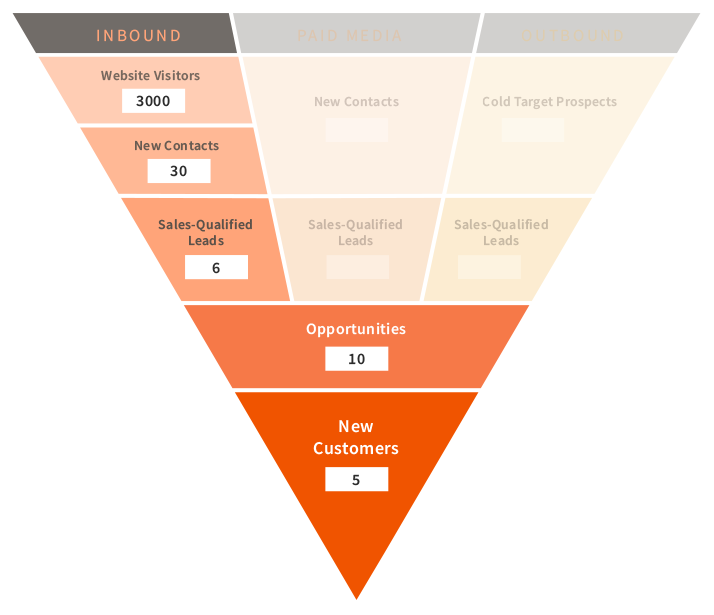
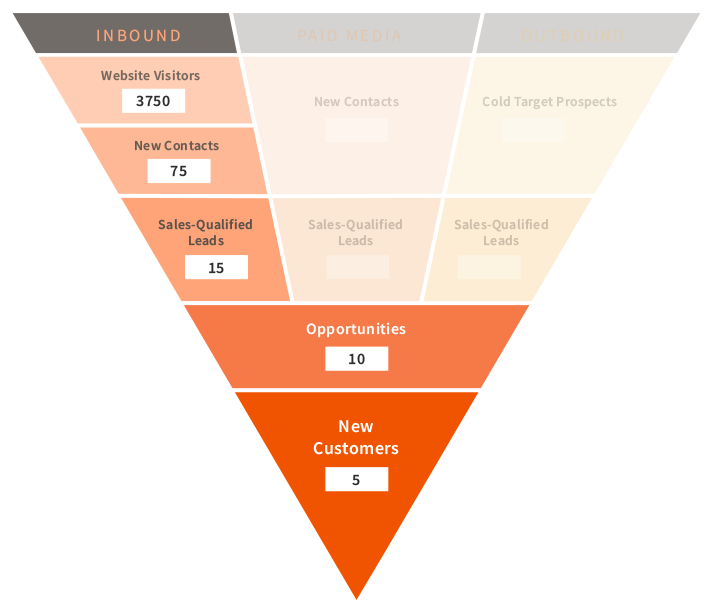
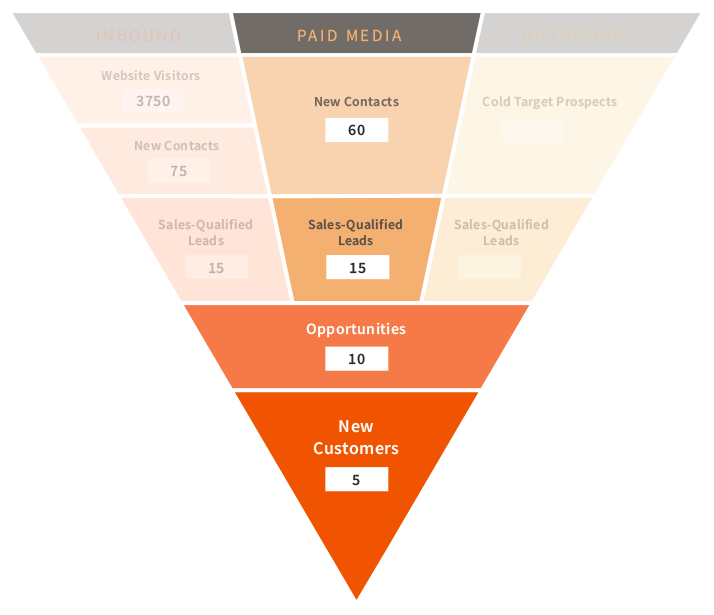
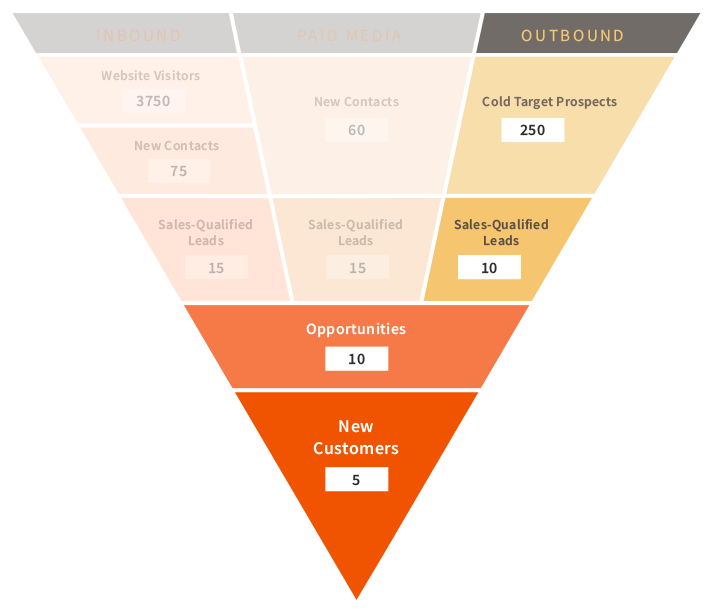
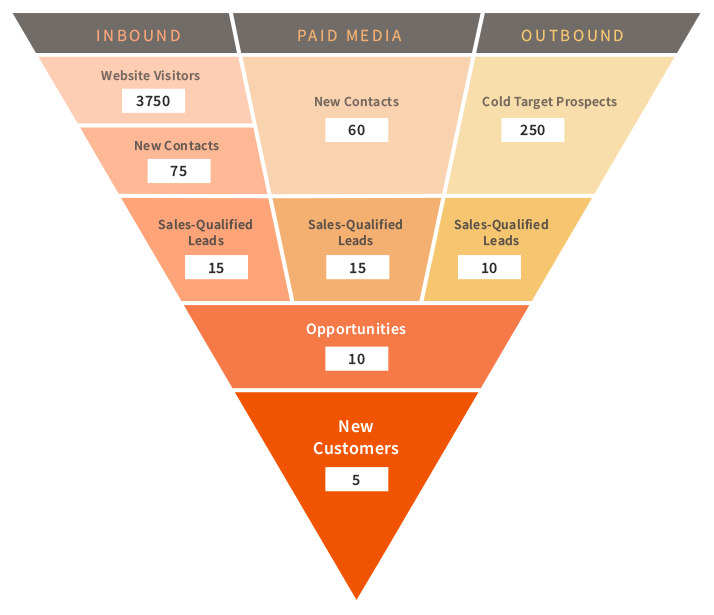




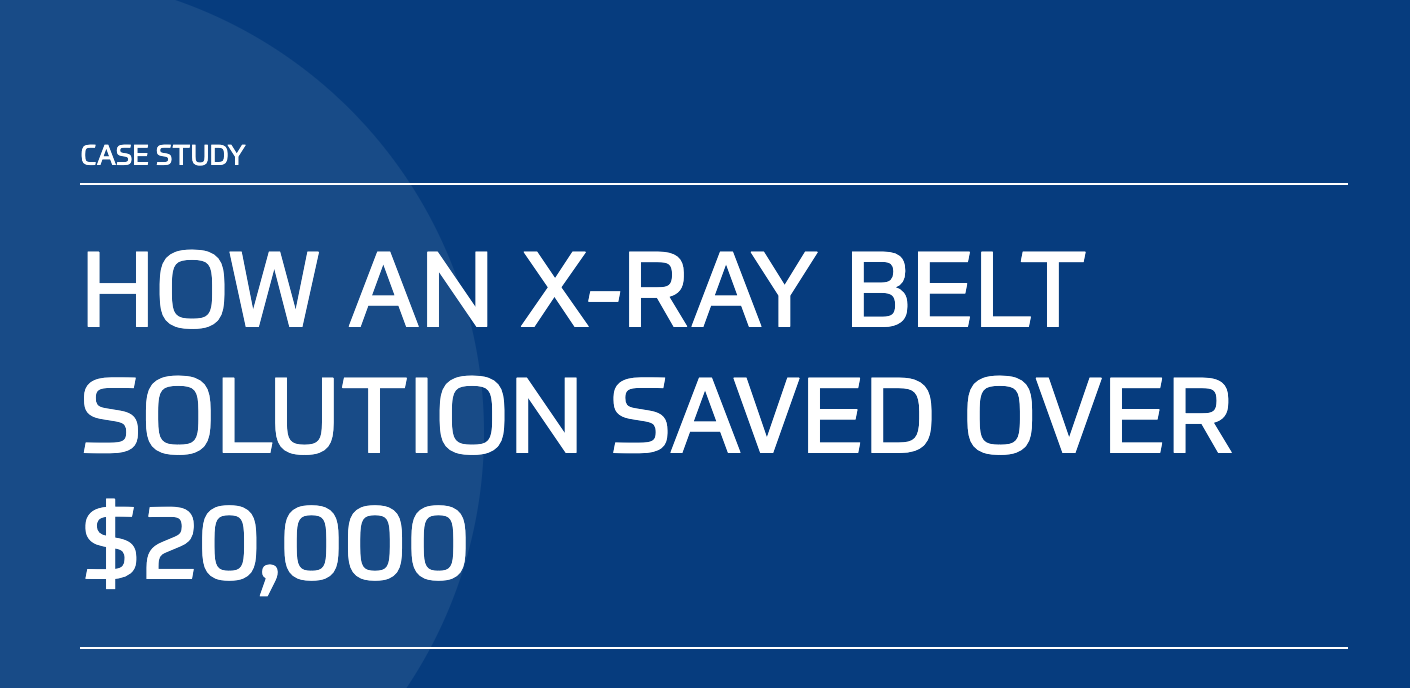
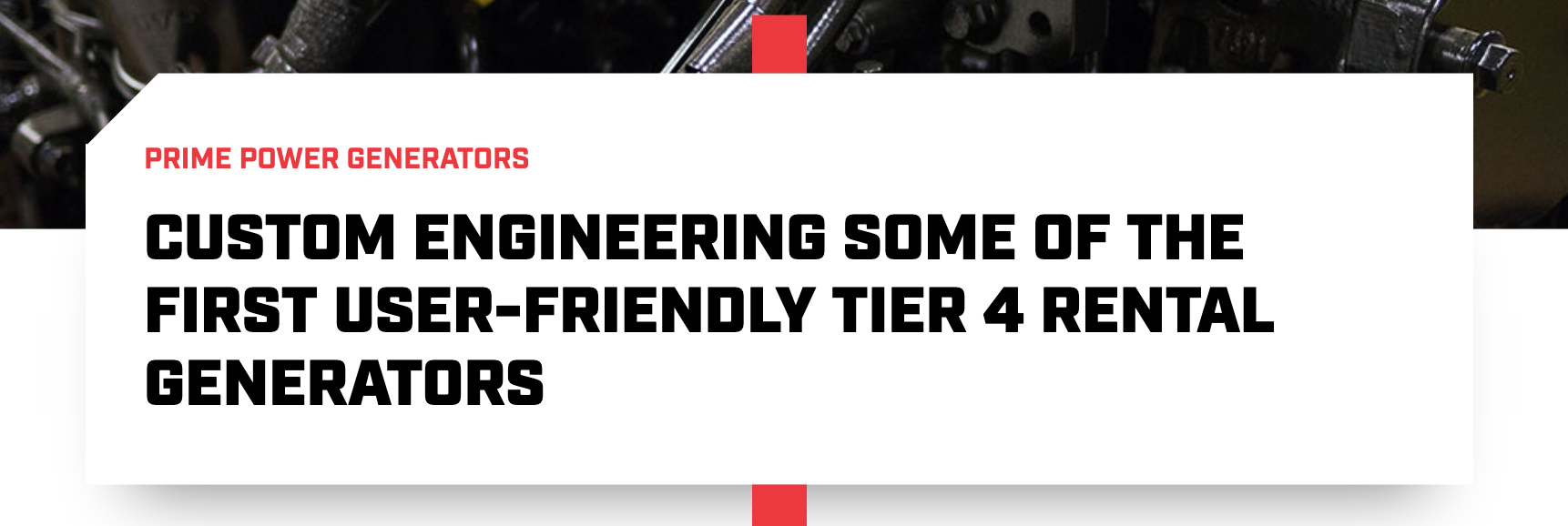

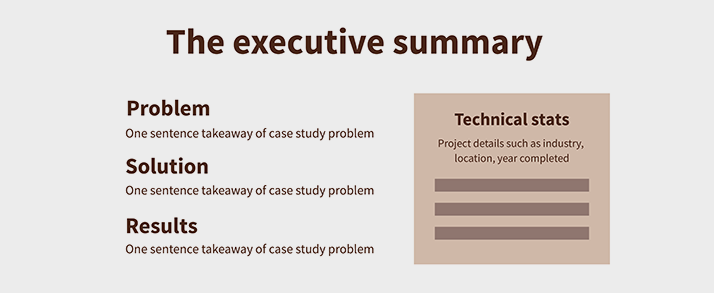
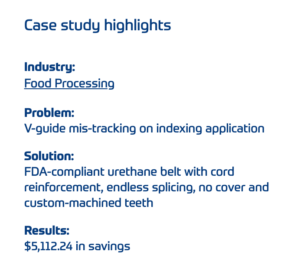

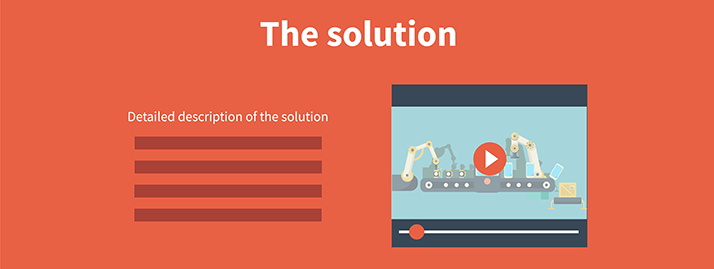

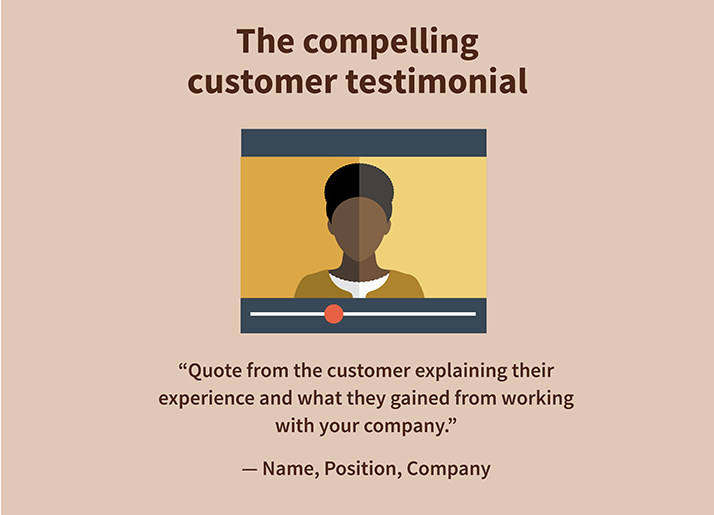
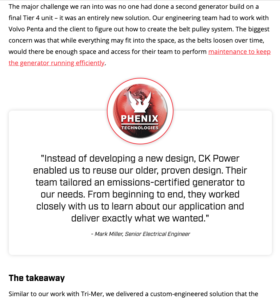
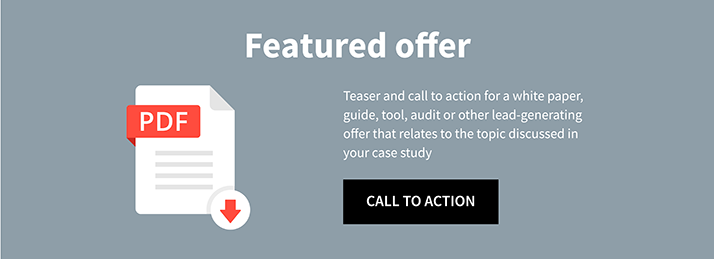
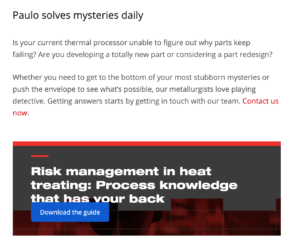
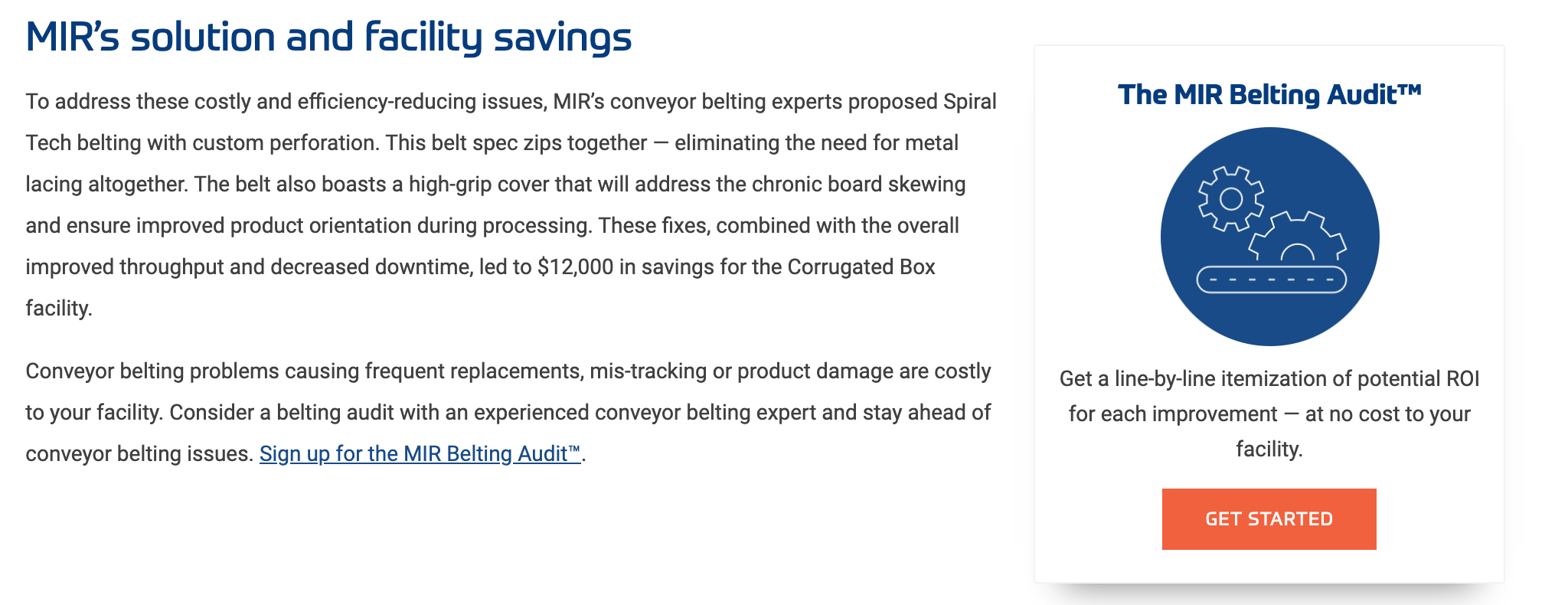



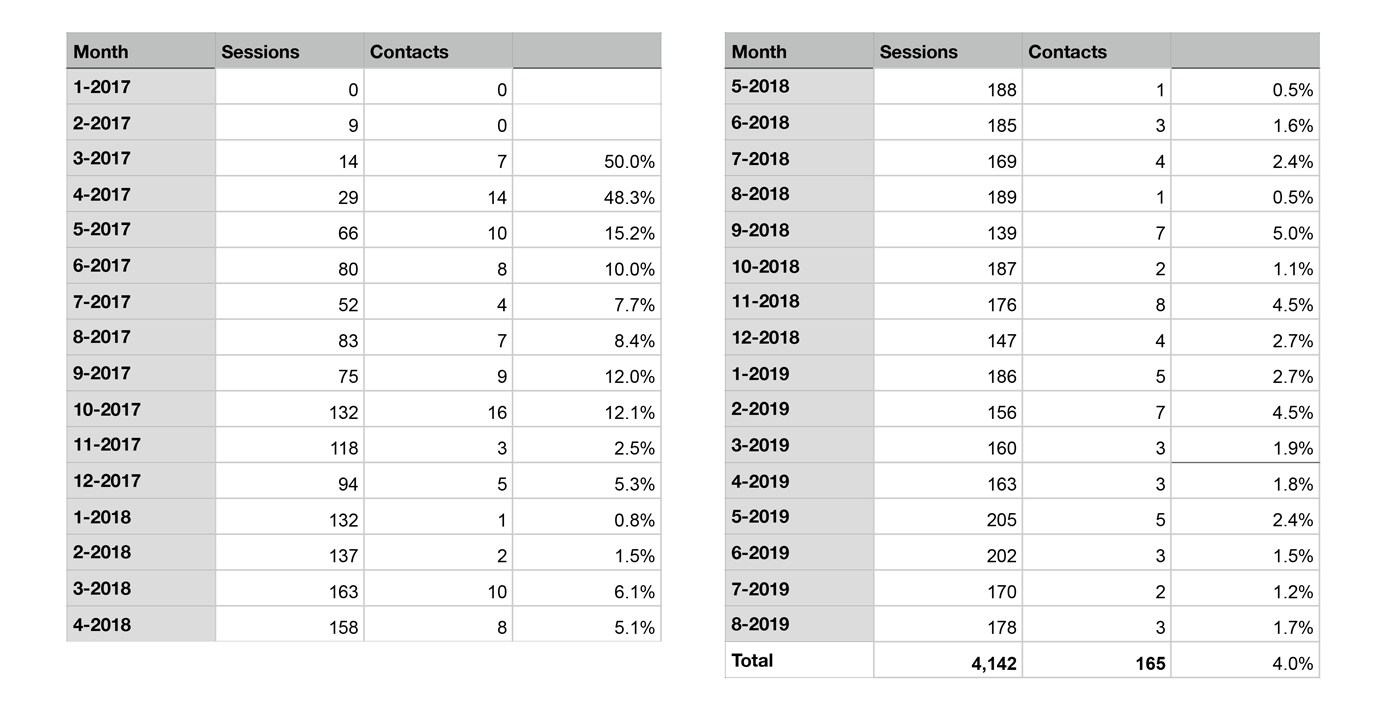
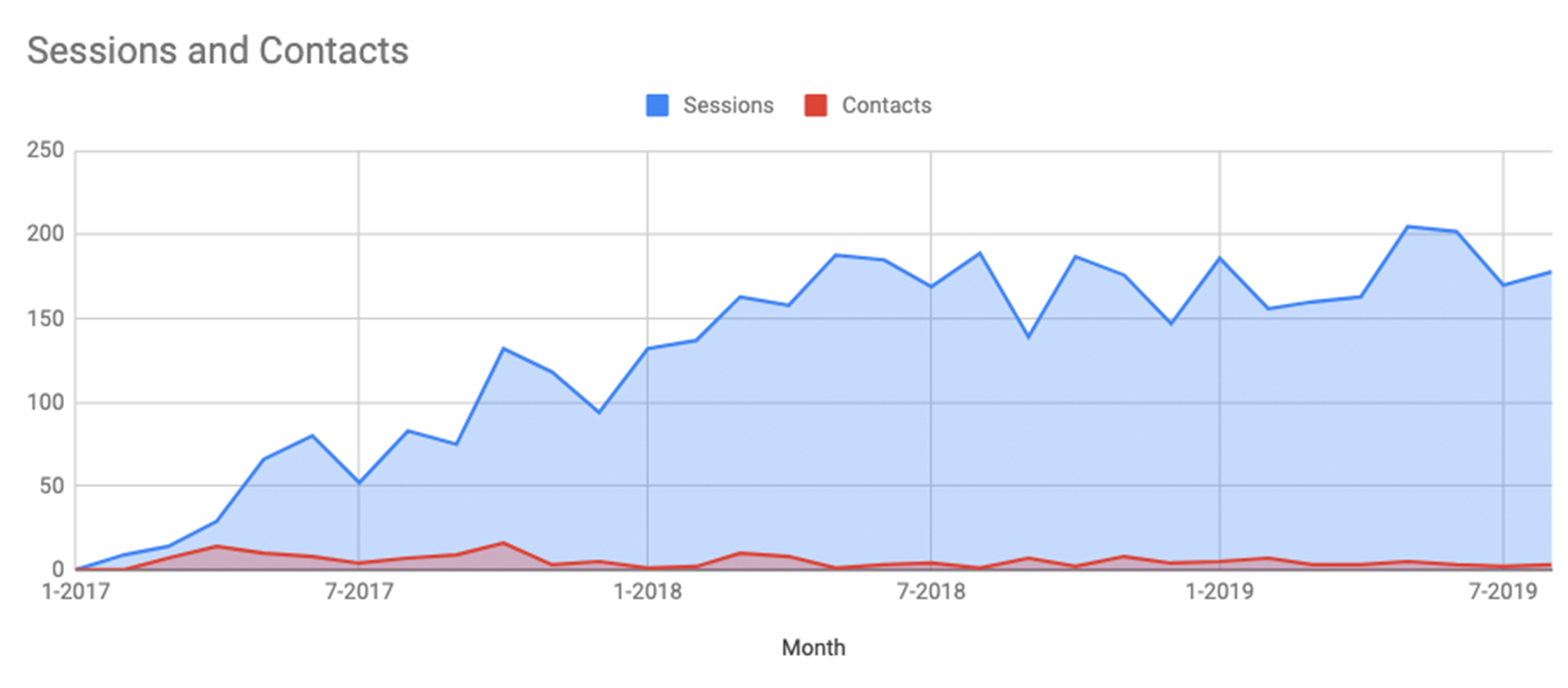



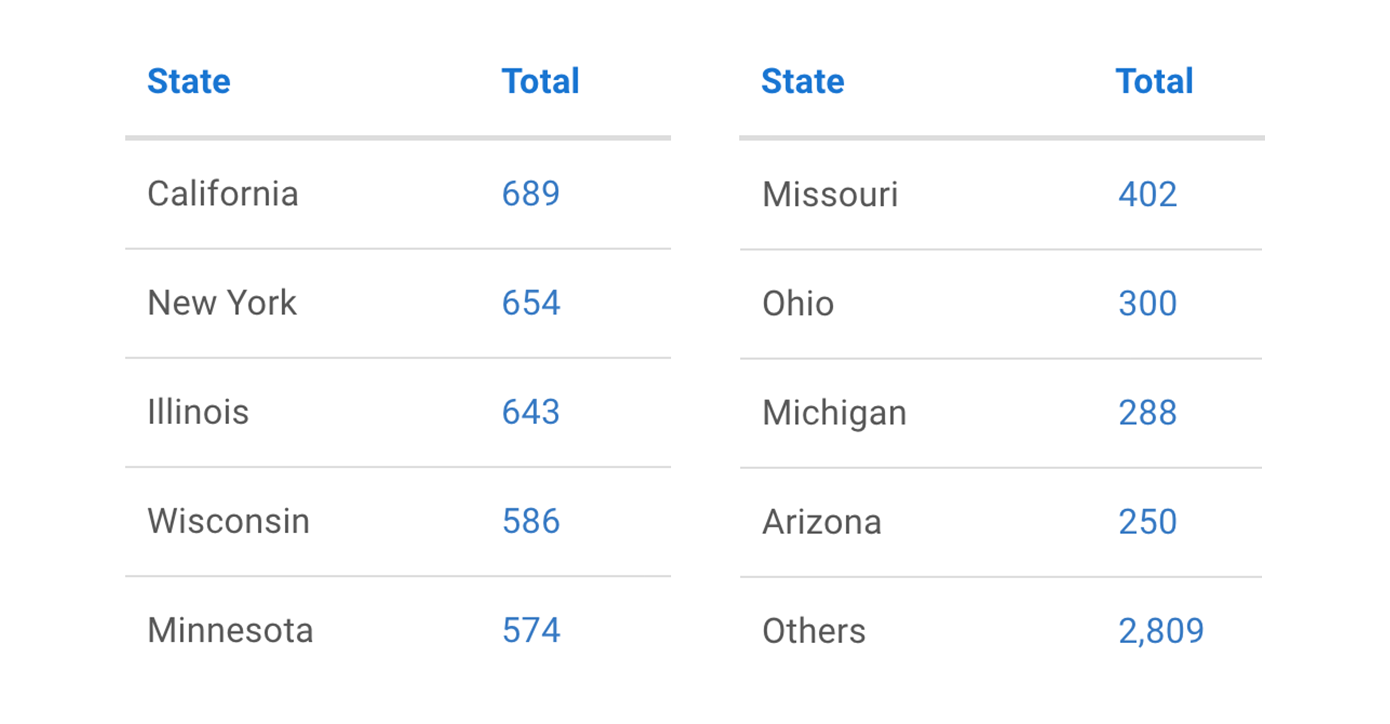







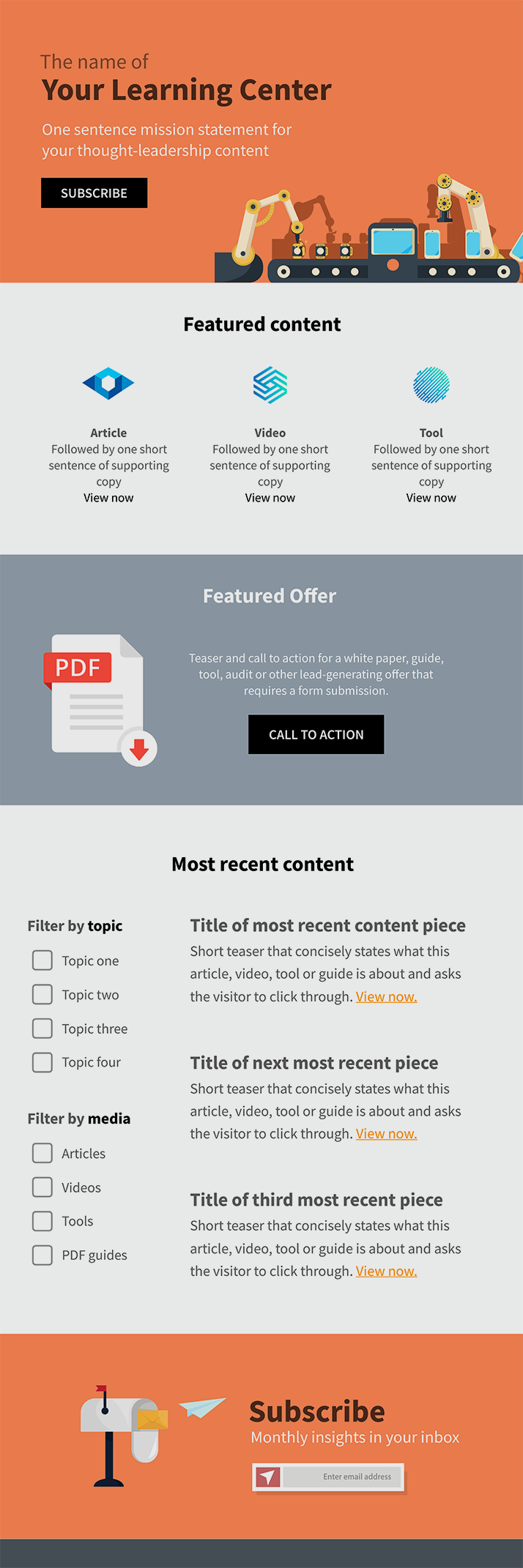
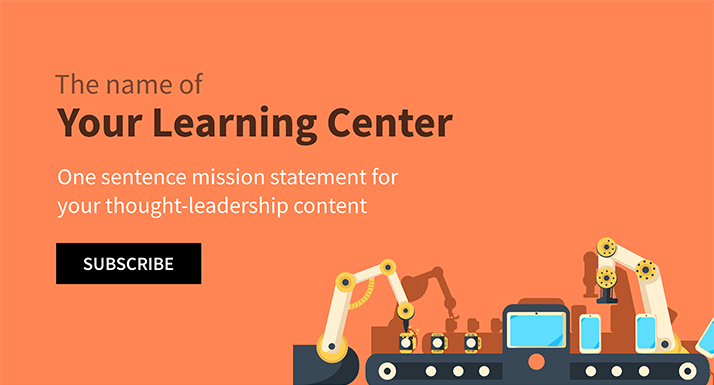
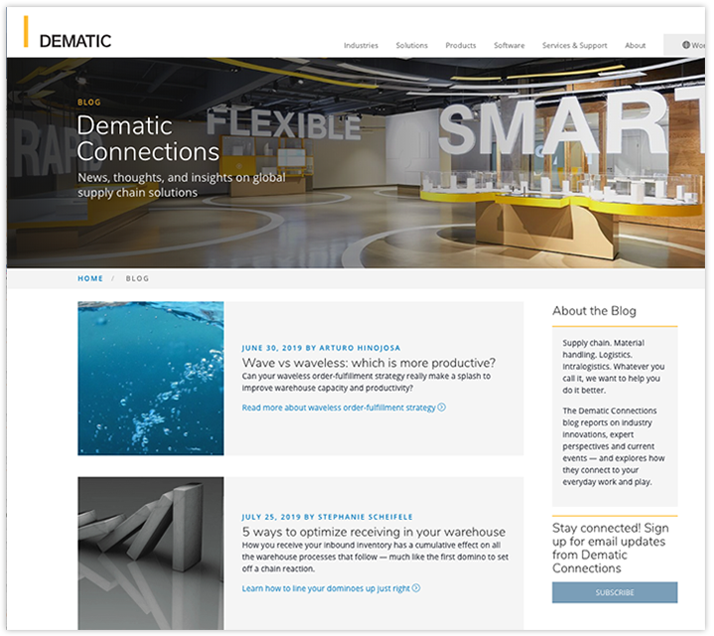
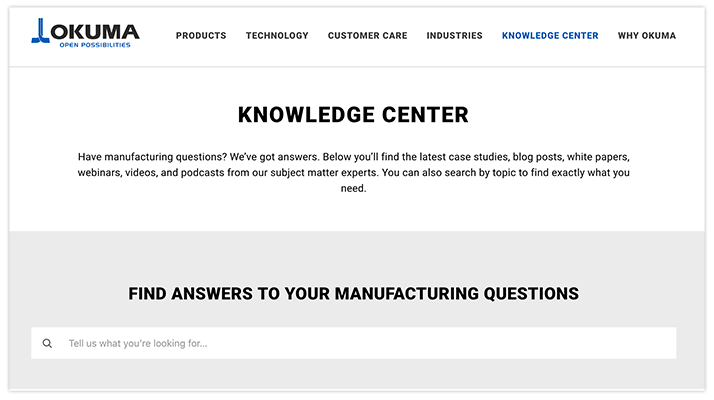
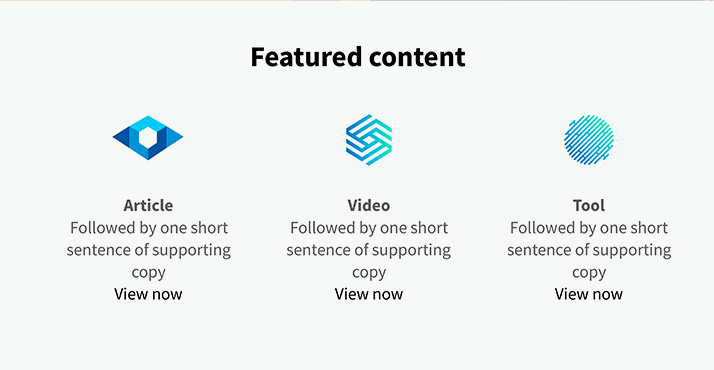

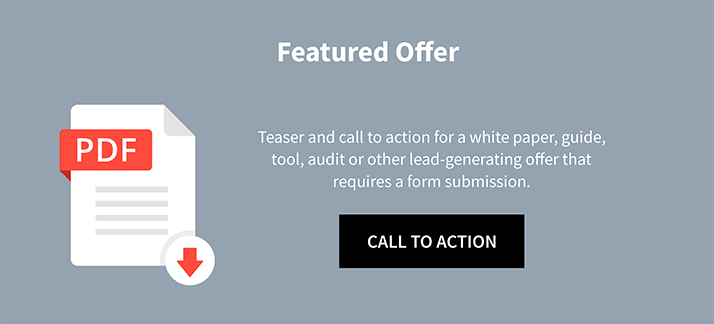
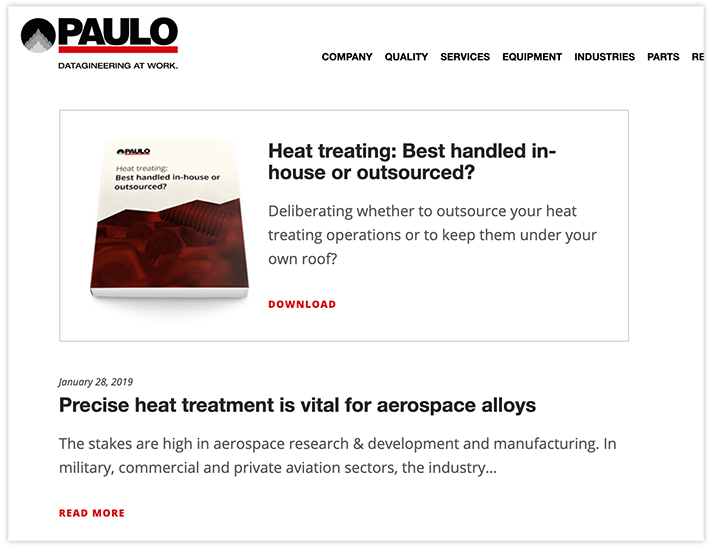
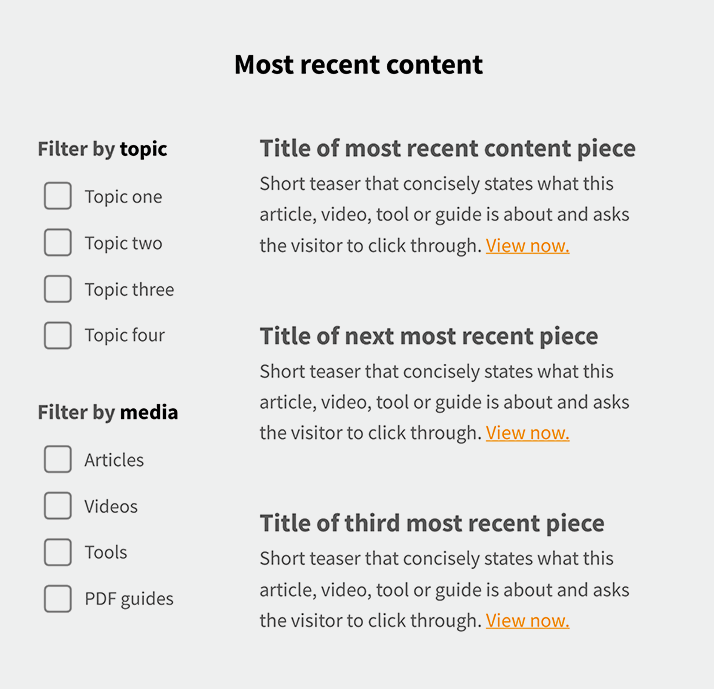
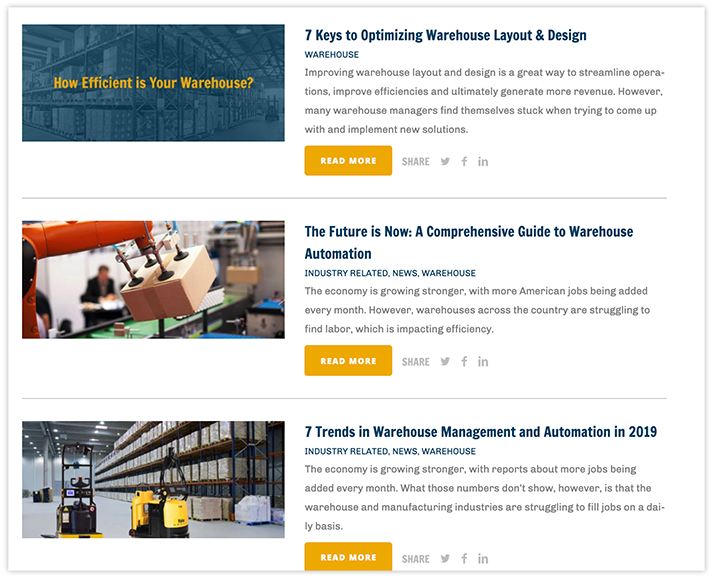
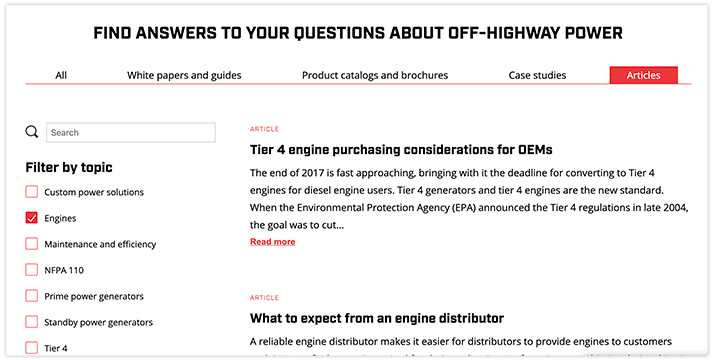

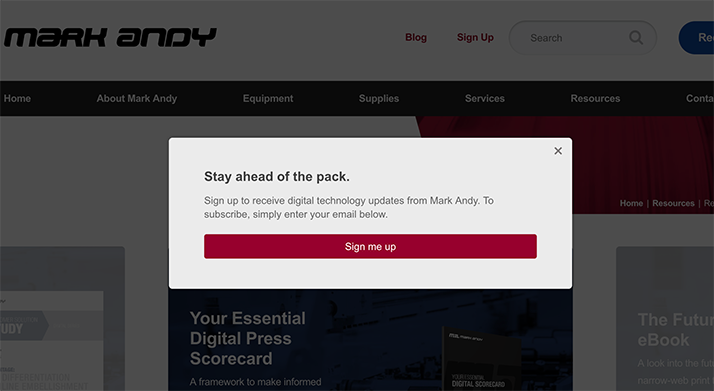

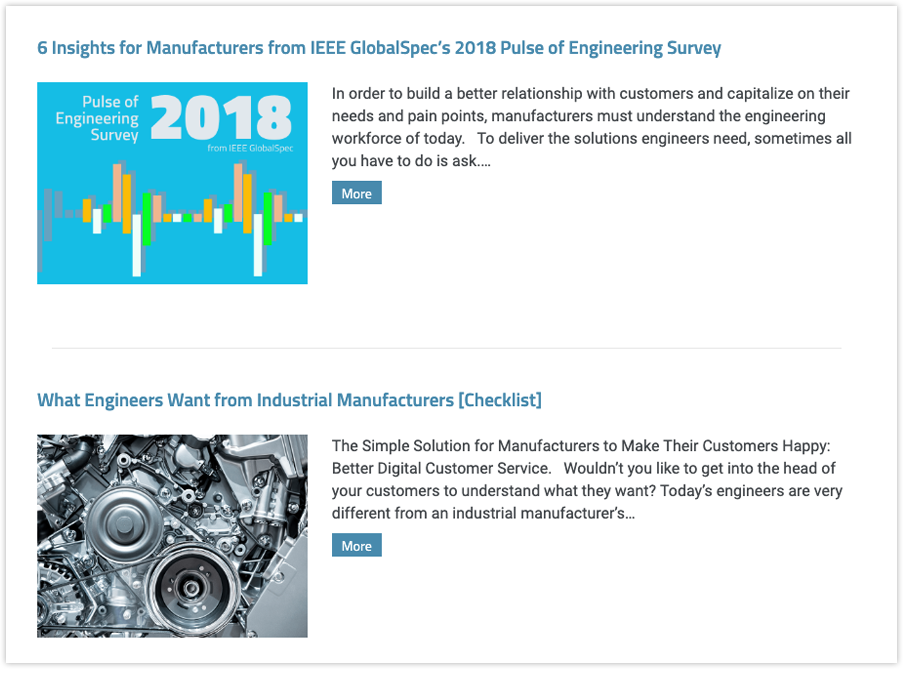
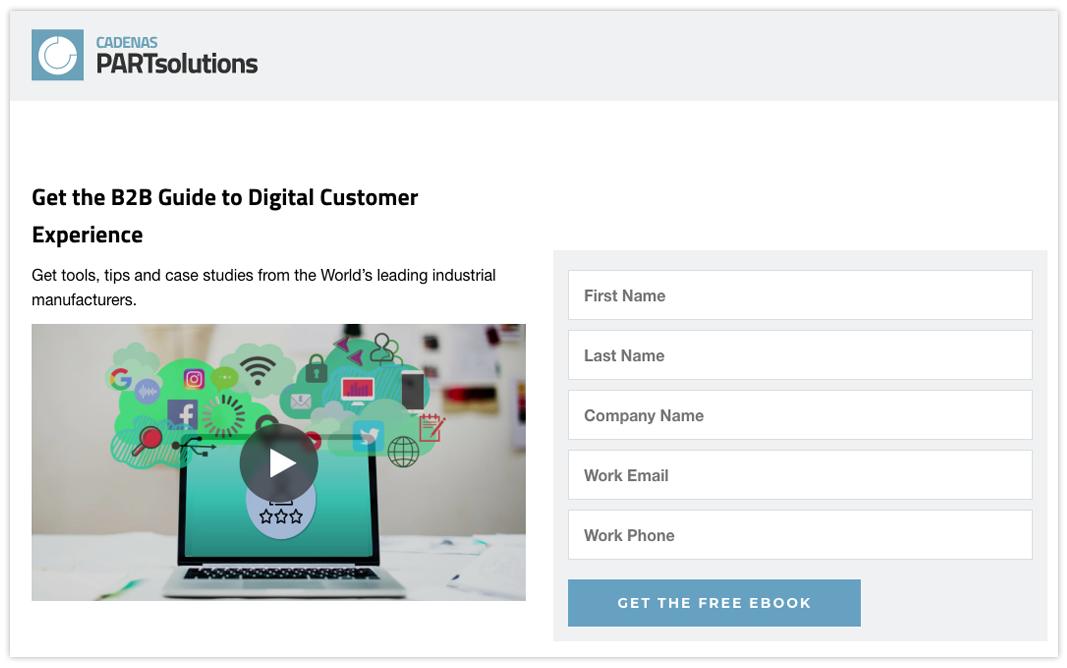

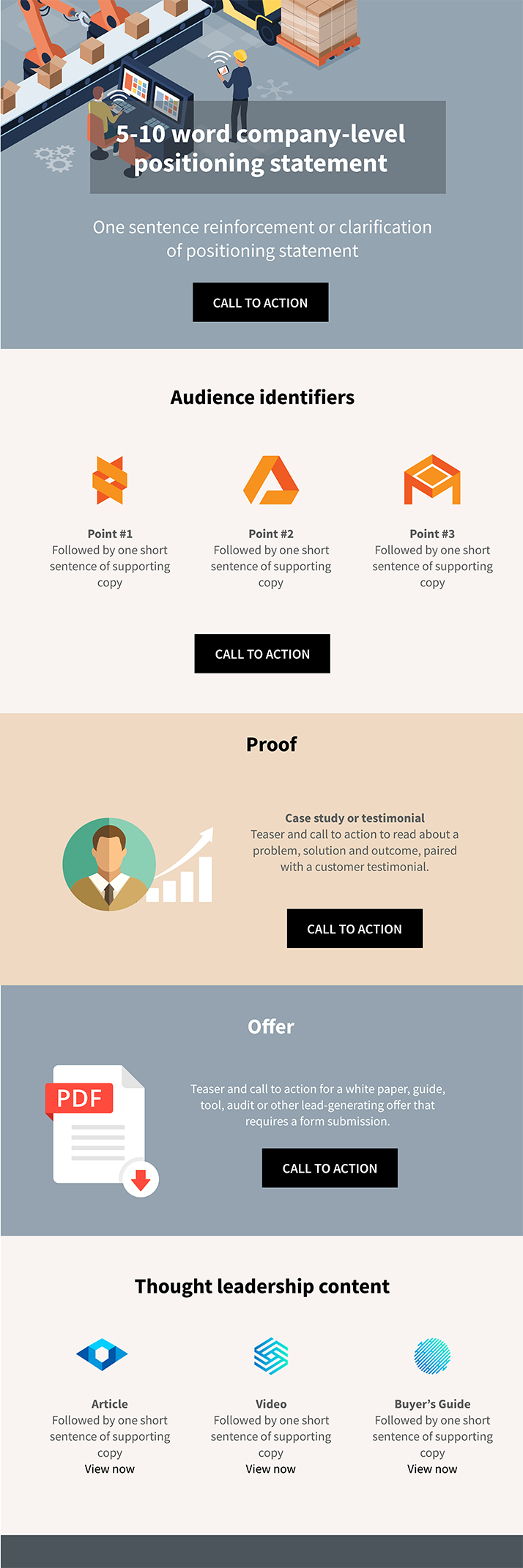
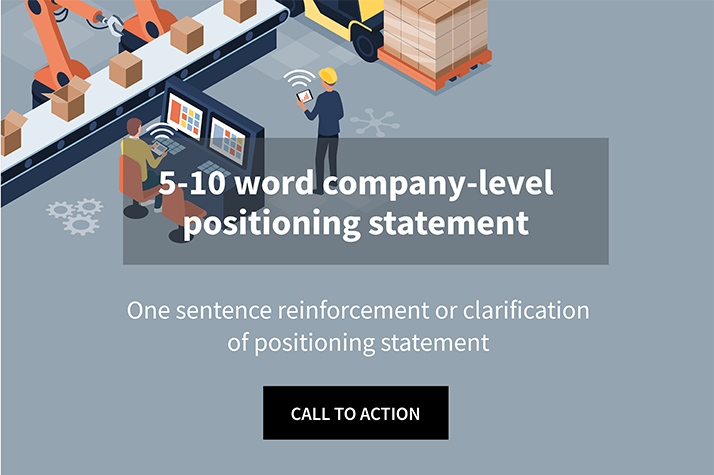
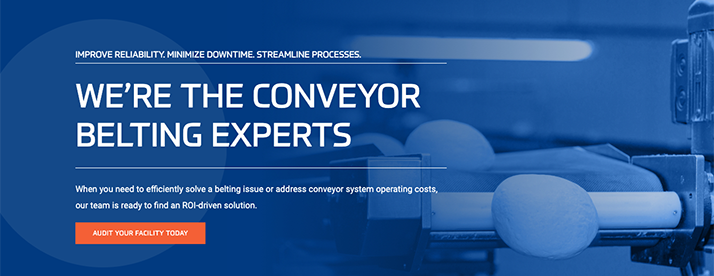
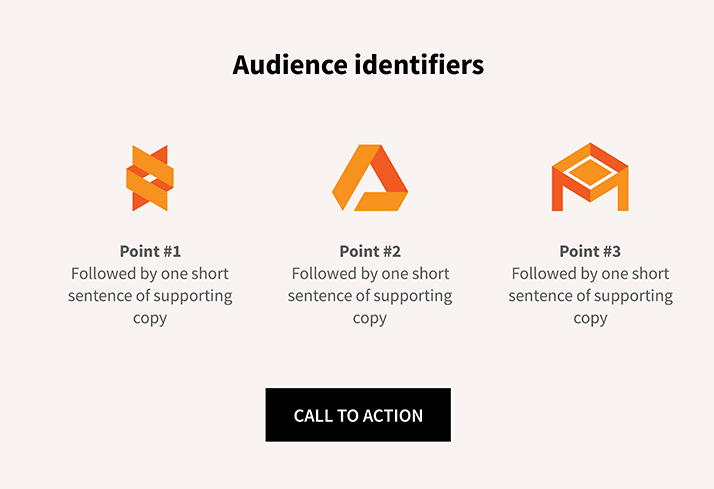
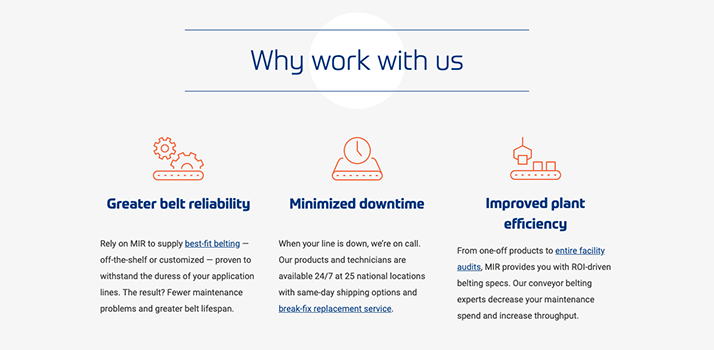
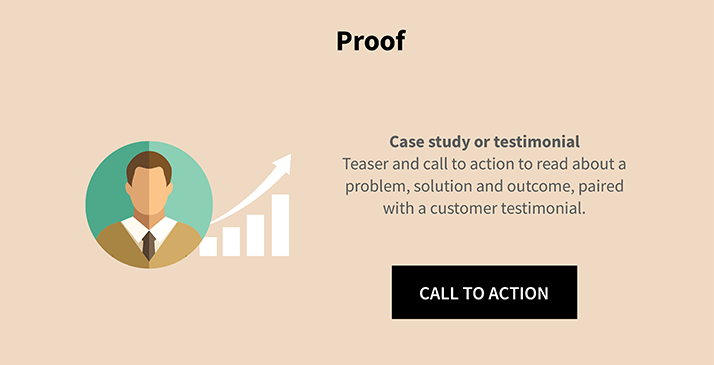
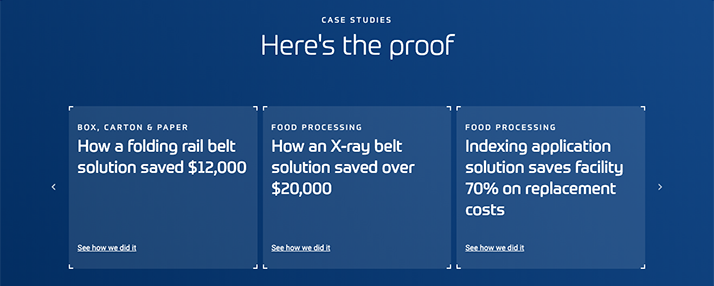
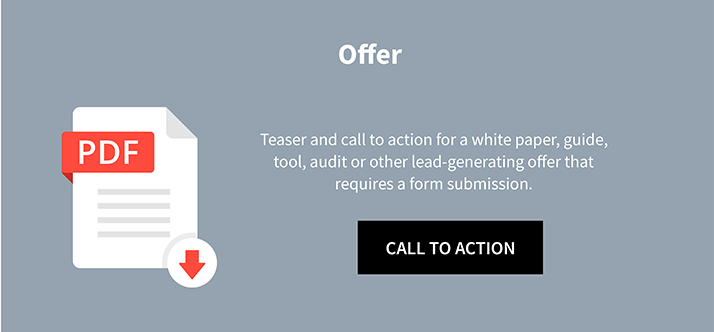
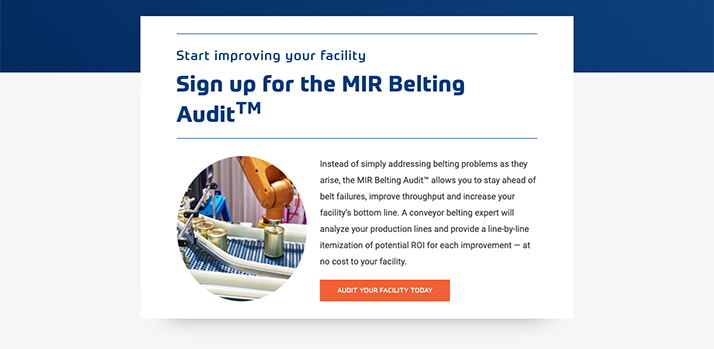
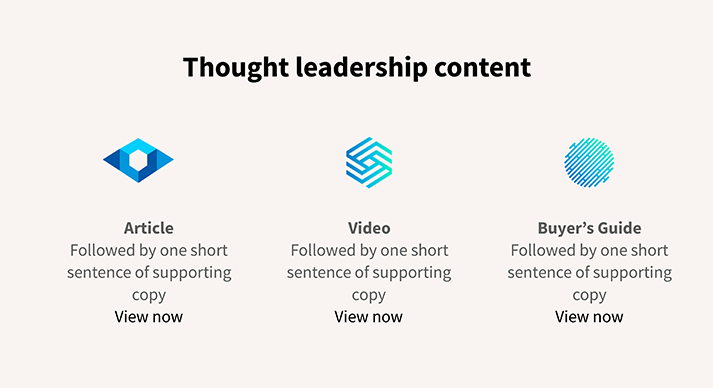
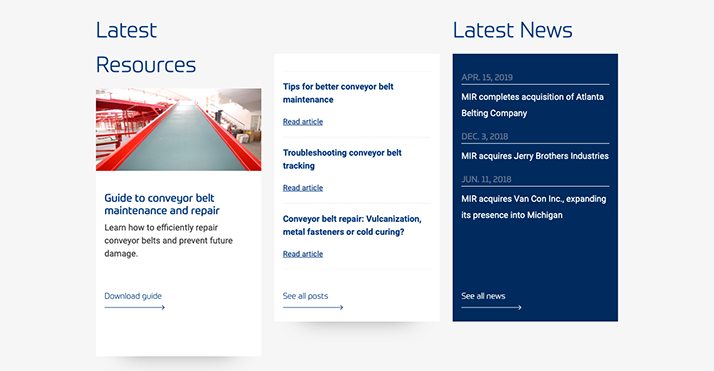

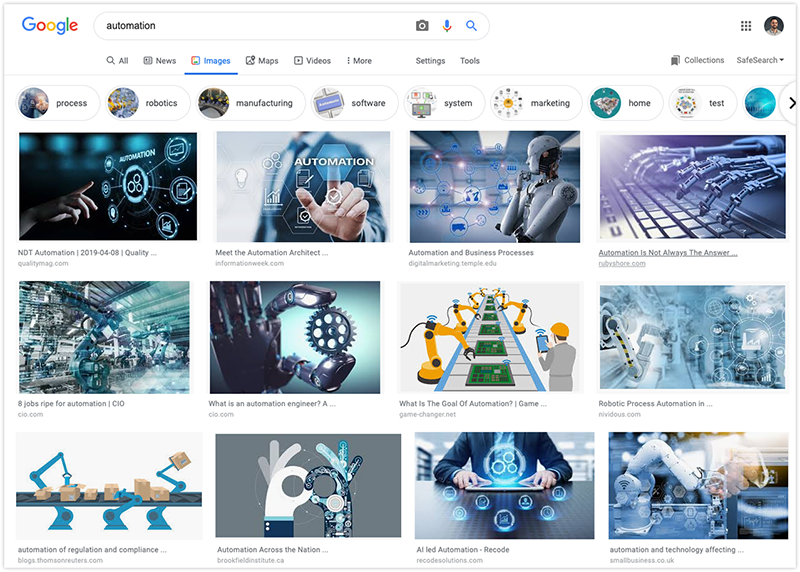




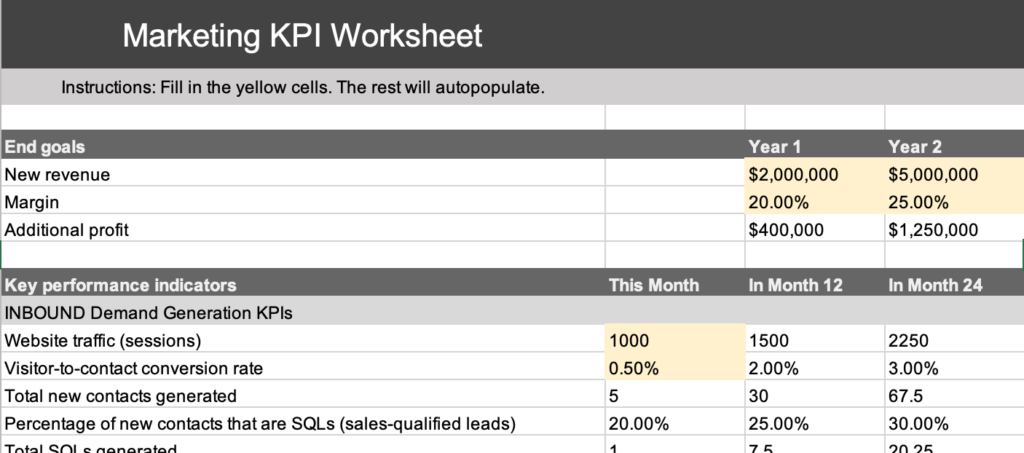





 Loading, Please Wait
Loading, Please Wait